Contributing Factors to Teenage Pregnancy in Barking & Dagenham, UK
VerifiedAdded on 2023/06/12
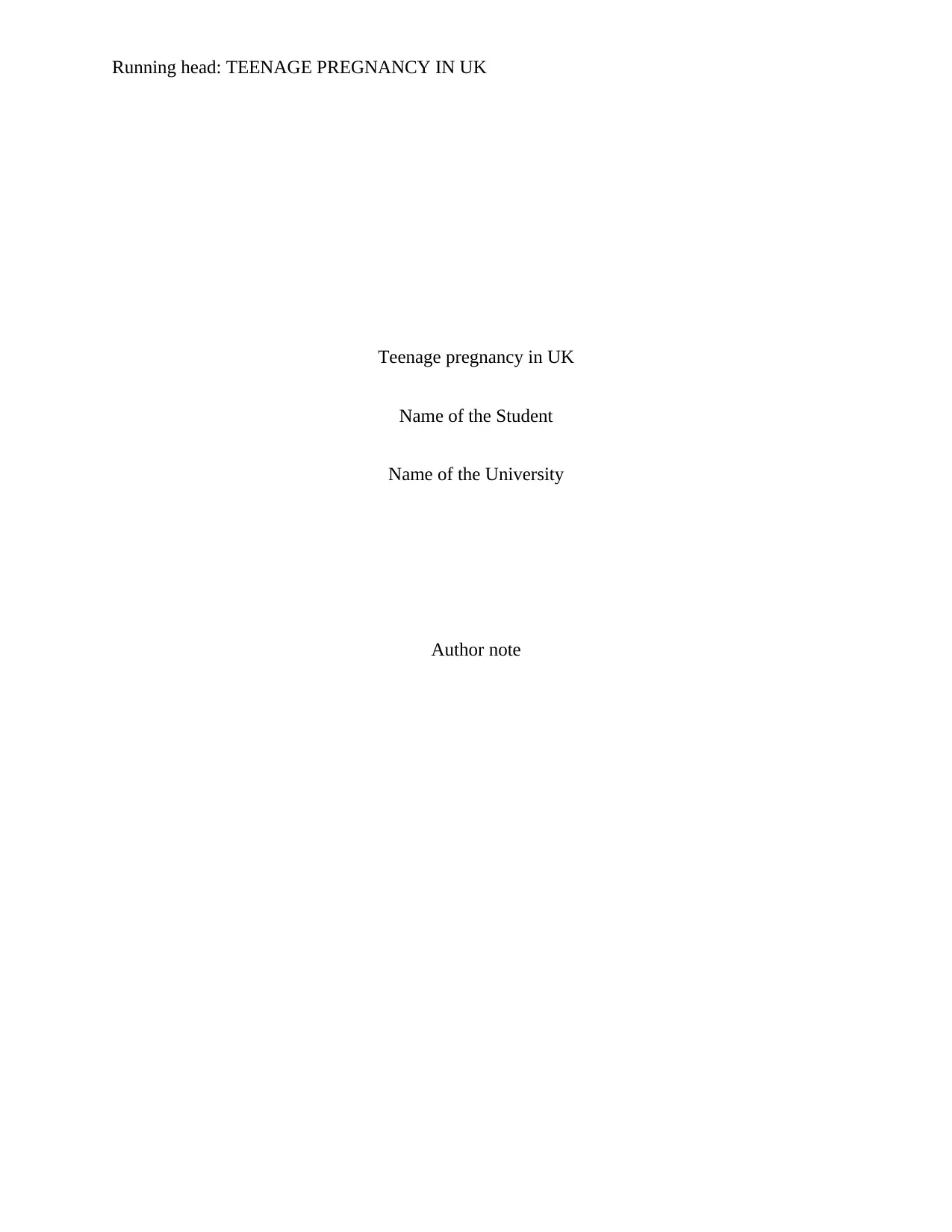
Teenage pregnancy in UK
Name of the Student
Name of the University
Author note
Paraphrase This Document
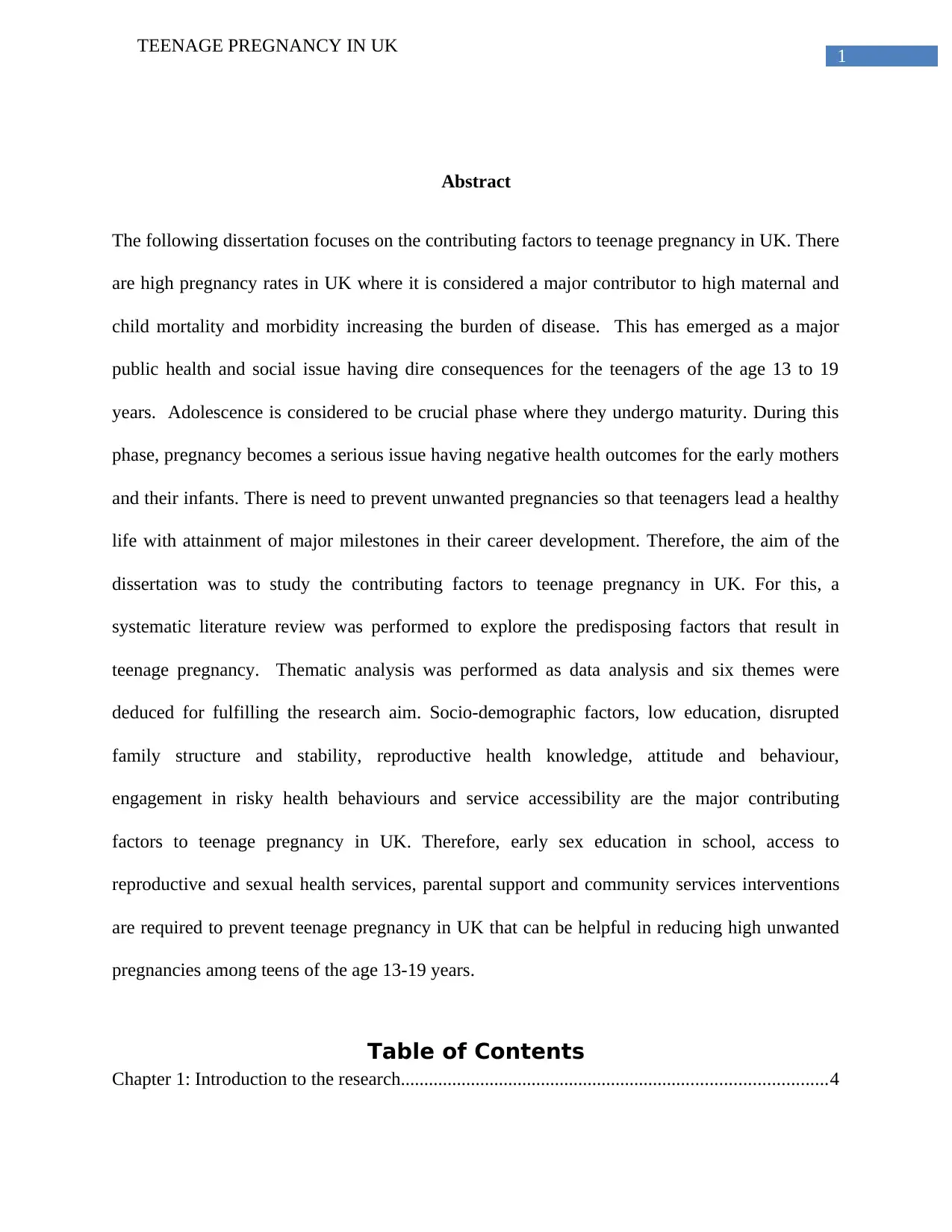
TEENAGE PREGNANCY IN UK
Abstract
The following dissertation focuses on the contributing factors to teenage pregnancy in UK. There
are high pregnancy rates in UK where it is considered a major contributor to high maternal and
child mortality and morbidity increasing the burden of disease. This has emerged as a major
public health and social issue having dire consequences for the teenagers of the age 13 to 19
years. Adolescence is considered to be crucial phase where they undergo maturity. During this
phase, pregnancy becomes a serious issue having negative health outcomes for the early mothers
and their infants. There is need to prevent unwanted pregnancies so that teenagers lead a healthy
life with attainment of major milestones in their career development. Therefore, the aim of the
dissertation was to study the contributing factors to teenage pregnancy in UK. For this, a
systematic literature review was performed to explore the predisposing factors that result in
teenage pregnancy. Thematic analysis was performed as data analysis and six themes were
deduced for fulfilling the research aim. Socio-demographic factors, low education, disrupted
family structure and stability, reproductive health knowledge, attitude and behaviour,
engagement in risky health behaviours and service accessibility are the major contributing
factors to teenage pregnancy in UK. Therefore, early sex education in school, access to
reproductive and sexual health services, parental support and community services interventions
are required to prevent teenage pregnancy in UK that can be helpful in reducing high unwanted
pregnancies among teens of the age 13-19 years.
Table of Contents
Chapter 1: Introduction to the research...........................................................................................4
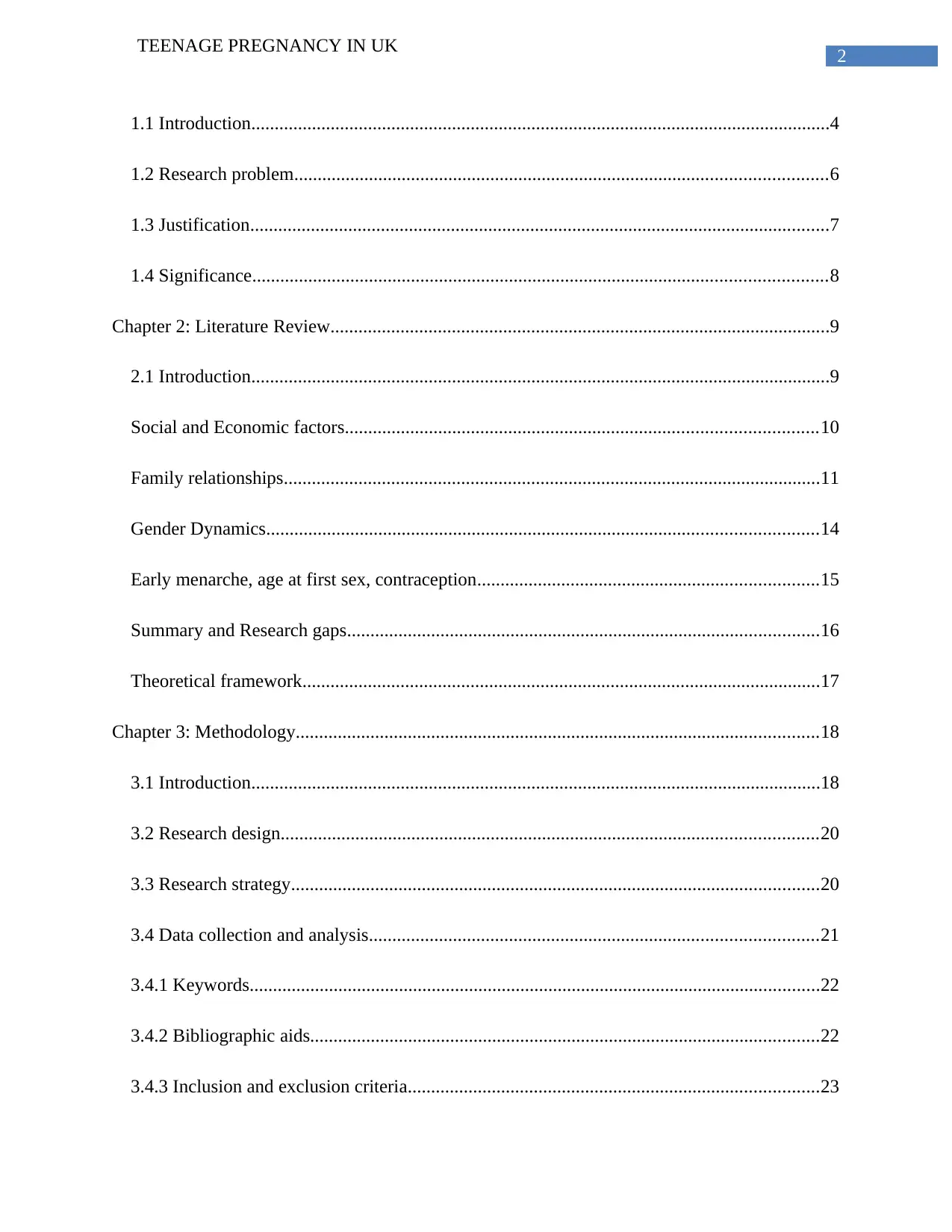
TEENAGE PREGNANCY IN UK
1.1 Introduction............................................................................................................................4
1.2 Research problem..................................................................................................................6
1.3 Justification............................................................................................................................7
1.4 Significance...........................................................................................................................8
Chapter 2: Literature Review...........................................................................................................9
2.1 Introduction............................................................................................................................9
Social and Economic factors.....................................................................................................10
Family relationships...................................................................................................................11
Gender Dynamics......................................................................................................................14
Early menarche, age at first sex, contraception.........................................................................15
Summary and Research gaps.....................................................................................................16
Theoretical framework...............................................................................................................17
Chapter 3: Methodology................................................................................................................18
3.1 Introduction..........................................................................................................................18
3.2 Research design...................................................................................................................20
3.3 Research strategy.................................................................................................................20
3.4 Data collection and analysis................................................................................................21
3.4.1 Keywords..........................................................................................................................22
3.4.2 Bibliographic aids.............................................................................................................22
3.4.3 Inclusion and exclusion criteria........................................................................................23
⊘ This is a preview!⊘
Do you want full access?
Subscribe today to unlock all pages.

Trusted by 1+ million students worldwide
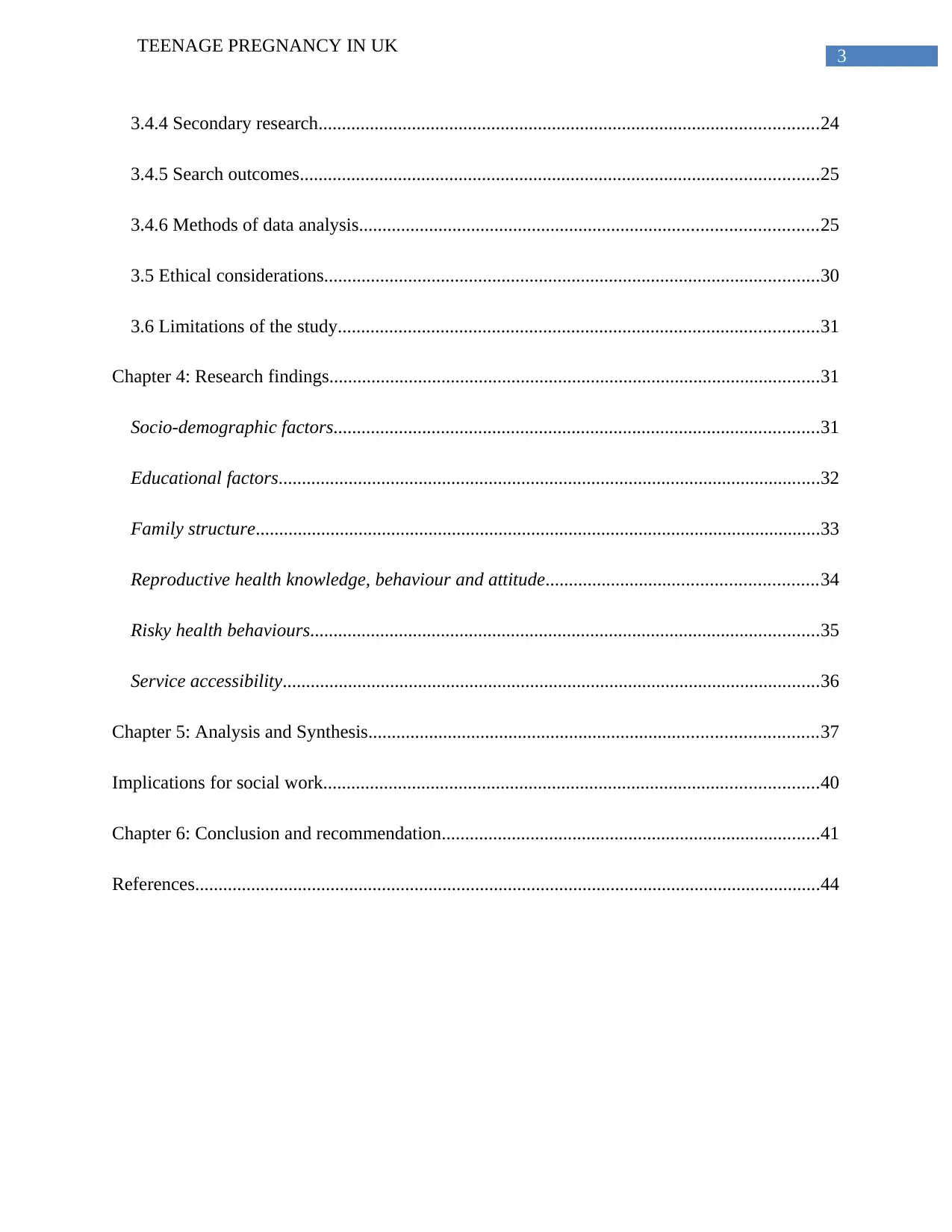
TEENAGE PREGNANCY IN UK
3.4.4 Secondary research...........................................................................................................24
3.4.5 Search outcomes...............................................................................................................25
3.4.6 Methods of data analysis..................................................................................................25
3.5 Ethical considerations..........................................................................................................30
3.6 Limitations of the study.......................................................................................................31
Chapter 4: Research findings.........................................................................................................31
Socio-demographic factors........................................................................................................31
Educational factors....................................................................................................................32
Family structure.........................................................................................................................33
Reproductive health knowledge, behaviour and attitude..........................................................34
Risky health behaviours.............................................................................................................35
Service accessibility...................................................................................................................36
Chapter 5: Analysis and Synthesis................................................................................................37
Implications for social work..........................................................................................................40
Chapter 6: Conclusion and recommendation.................................................................................41
References......................................................................................................................................44
Paraphrase This Document
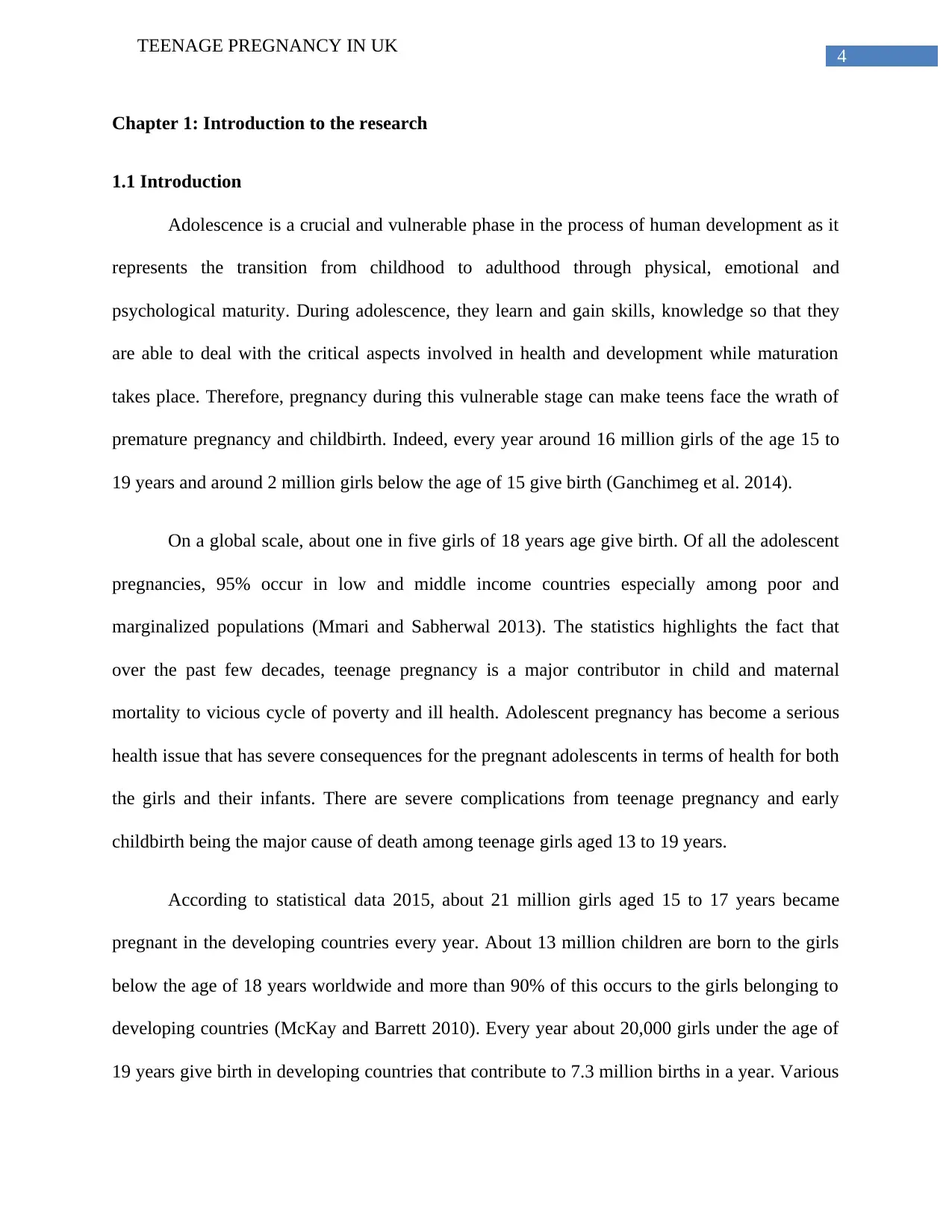
TEENAGE PREGNANCY IN UK
Chapter 1: Introduction to the research
1.1 Introduction
Adolescence is a crucial and vulnerable phase in the process of human development as it
represents the transition from childhood to adulthood through physical, emotional and
psychological maturity. During adolescence, they learn and gain skills, knowledge so that they
are able to deal with the critical aspects involved in health and development while maturation
takes place. Therefore, pregnancy during this vulnerable stage can make teens face the wrath of
premature pregnancy and childbirth. Indeed, every year around 16 million girls of the age 15 to
19 years and around 2 million girls below the age of 15 give birth (Ganchimeg et al. 2014).
On a global scale, about one in five girls of 18 years age give birth. Of all the adolescent
pregnancies, 95% occur in low and middle income countries especially among poor and
marginalized populations (Mmari and Sabherwal 2013). The statistics highlights the fact that
over the past few decades, teenage pregnancy is a major contributor in child and maternal
mortality to vicious cycle of poverty and ill health. Adolescent pregnancy has become a serious
health issue that has severe consequences for the pregnant adolescents in terms of health for both
the girls and their infants. There are severe complications from teenage pregnancy and early
childbirth being the major cause of death among teenage girls aged 13 to 19 years.
According to statistical data 2015, about 21 million girls aged 15 to 17 years became
pregnant in the developing countries every year. About 13 million children are born to the girls
below the age of 18 years worldwide and more than 90% of this occurs to the girls belonging to
developing countries (McKay and Barrett 2010). Every year about 20,000 girls under the age of
19 years give birth in developing countries that contribute to 7.3 million births in a year. Various
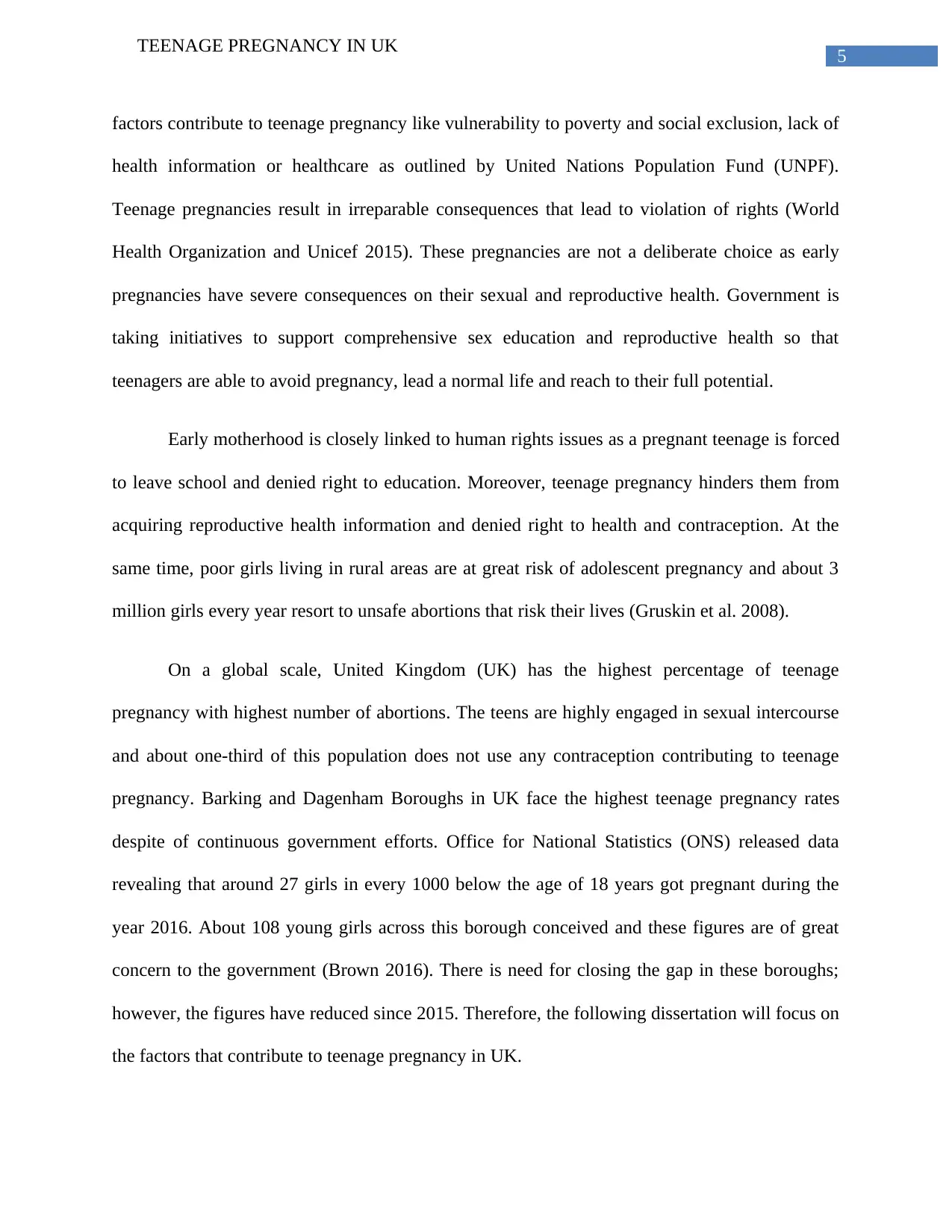
TEENAGE PREGNANCY IN UK
factors contribute to teenage pregnancy like vulnerability to poverty and social exclusion, lack of
health information or healthcare as outlined by United Nations Population Fund (UNPF).
Teenage pregnancies result in irreparable consequences that lead to violation of rights (World
Health Organization and Unicef 2015). These pregnancies are not a deliberate choice as early
pregnancies have severe consequences on their sexual and reproductive health. Government is
taking initiatives to support comprehensive sex education and reproductive health so that
teenagers are able to avoid pregnancy, lead a normal life and reach to their full potential.
Early motherhood is closely linked to human rights issues as a pregnant teenage is forced
to leave school and denied right to education. Moreover, teenage pregnancy hinders them from
acquiring reproductive health information and denied right to health and contraception. At the
same time, poor girls living in rural areas are at great risk of adolescent pregnancy and about 3
million girls every year resort to unsafe abortions that risk their lives (Gruskin et al. 2008).
On a global scale, United Kingdom (UK) has the highest percentage of teenage
pregnancy with highest number of abortions. The teens are highly engaged in sexual intercourse
and about one-third of this population does not use any contraception contributing to teenage
pregnancy. Barking and Dagenham Boroughs in UK face the highest teenage pregnancy rates
despite of continuous government efforts. Office for National Statistics (ONS) released data
revealing that around 27 girls in every 1000 below the age of 18 years got pregnant during the
year 2016. About 108 young girls across this borough conceived and these figures are of great
concern to the government (Brown 2016). There is need for closing the gap in these boroughs;
however, the figures have reduced since 2015. Therefore, the following dissertation will focus on
the factors that contribute to teenage pregnancy in UK.
⊘ This is a preview!⊘
Do you want full access?
Subscribe today to unlock all pages.

Trusted by 1+ million students worldwide

TEENAGE PREGNANCY IN UK
1.2 Research problem
Teenage pregnancy is a public health issue rather than clinical problem because
coordinated action is required for helping young women in avoiding unwanted pregnancy and
dealing with the consequences. The healthcare system need to play a crucial role that is
undeniable that not only comprises of offering sexual health services, but also provision of
termination and maternity services for the girls who wish to end or continue their pregnancy. The
reason why adolescent pregnancy is precisely considered a major health issue in UK, as there are
serious negative consequences of unwanted pregnancy. The problems of smoking, obesity, poor
diet and isolation also need to be considered if the situation needs to be prevented rather than
treating the consequences (Banerjee et al. 2009). Adolescent conception and early motherhood
are strongly linked to poor physical, mental and sexual health (both mother and child), poor
educational achievement and poverty. These factors recognize the fact that socio-economic
disadvantage is a cause and effect of adolescent pregnancy. In addition, teenage pregnancy is
always an area of policy interest as three sexual health indicators need to be focused concerning
teenage pregnancy conception, child poverty and social impact on teen mothers.
The increase in teenage pregnancies and birth rates in these London boroughs is an
indication of lack of family support. Social problems like anti-social behaviour and family
breakdown are considered the causes of unwanted teenage pregnancies. Barking and Dagenham
boroughs in London are the most deprived with highest teenage pregnancy percentage. The
council is in greatest need for health services that offer targeted family support services in these
boroughs (Mahavarkar, Madhu and Mule 2008). There are also potential negative outcomes of
teenage pregnancy as baby born to a teenage mother may have low birth weight and life
expectancy, congenital anomalies, increased likelihood of infant mortality, developmental and
Paraphrase This Document
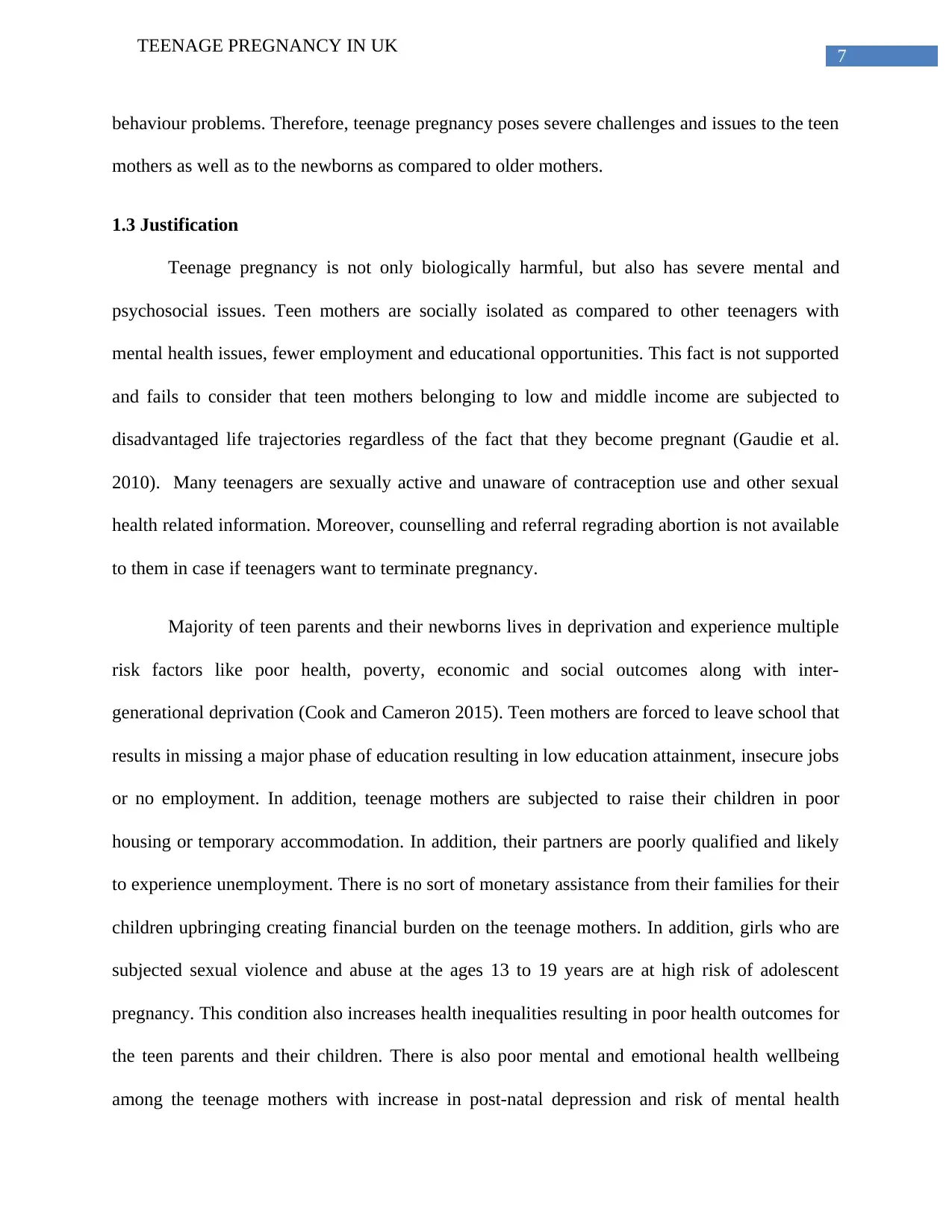
TEENAGE PREGNANCY IN UK
behaviour problems. Therefore, teenage pregnancy poses severe challenges and issues to the teen
mothers as well as to the newborns as compared to older mothers.
1.3 Justification
Teenage pregnancy is not only biologically harmful, but also has severe mental and
psychosocial issues. Teen mothers are socially isolated as compared to other teenagers with
mental health issues, fewer employment and educational opportunities. This fact is not supported
and fails to consider that teen mothers belonging to low and middle income are subjected to
disadvantaged life trajectories regardless of the fact that they become pregnant (Gaudie et al.
2010). Many teenagers are sexually active and unaware of contraception use and other sexual
health related information. Moreover, counselling and referral regrading abortion is not available
to them in case if teenagers want to terminate pregnancy.
Majority of teen parents and their newborns lives in deprivation and experience multiple
risk factors like poor health, poverty, economic and social outcomes along with inter-
generational deprivation (Cook and Cameron 2015). Teen mothers are forced to leave school that
results in missing a major phase of education resulting in low education attainment, insecure jobs
or no employment. In addition, teenage mothers are subjected to raise their children in poor
housing or temporary accommodation. In addition, their partners are poorly qualified and likely
to experience unemployment. There is no sort of monetary assistance from their families for their
children upbringing creating financial burden on the teenage mothers. In addition, girls who are
subjected sexual violence and abuse at the ages 13 to 19 years are at high risk of adolescent
pregnancy. This condition also increases health inequalities resulting in poor health outcomes for
the teen parents and their children. There is also poor mental and emotional health wellbeing
among the teenage mothers with increase in post-natal depression and risk of mental health
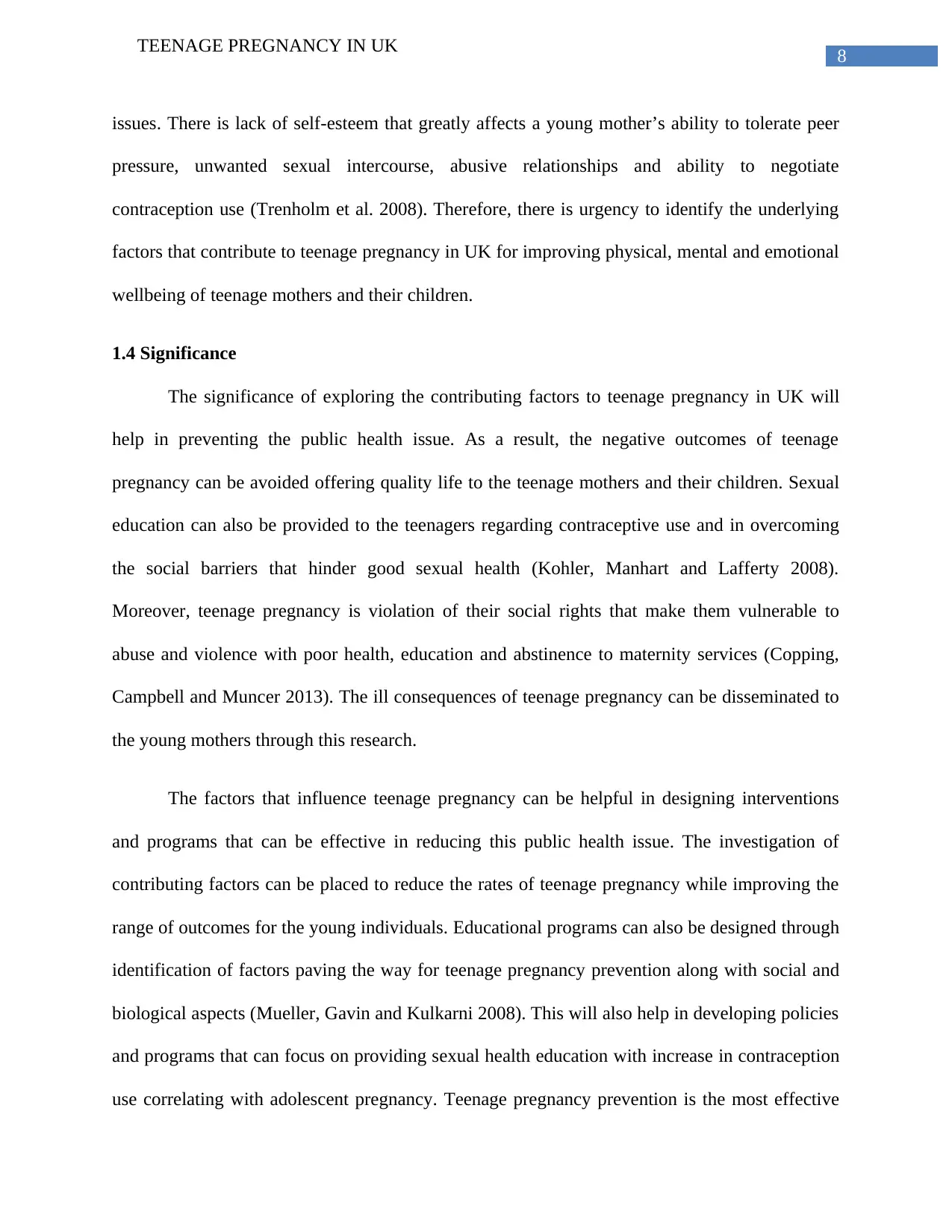
TEENAGE PREGNANCY IN UK
issues. There is lack of self-esteem that greatly affects a young mother’s ability to tolerate peer
pressure, unwanted sexual intercourse, abusive relationships and ability to negotiate
contraception use (Trenholm et al. 2008). Therefore, there is urgency to identify the underlying
factors that contribute to teenage pregnancy in UK for improving physical, mental and emotional
wellbeing of teenage mothers and their children.
1.4 Significance
The significance of exploring the contributing factors to teenage pregnancy in UK will
help in preventing the public health issue. As a result, the negative outcomes of teenage
pregnancy can be avoided offering quality life to the teenage mothers and their children. Sexual
education can also be provided to the teenagers regarding contraceptive use and in overcoming
the social barriers that hinder good sexual health (Kohler, Manhart and Lafferty 2008).
Moreover, teenage pregnancy is violation of their social rights that make them vulnerable to
abuse and violence with poor health, education and abstinence to maternity services (Copping,
Campbell and Muncer 2013). The ill consequences of teenage pregnancy can be disseminated to
the young mothers through this research.
The factors that influence teenage pregnancy can be helpful in designing interventions
and programs that can be effective in reducing this public health issue. The investigation of
contributing factors can be placed to reduce the rates of teenage pregnancy while improving the
range of outcomes for the young individuals. Educational programs can also be designed through
identification of factors paving the way for teenage pregnancy prevention along with social and
biological aspects (Mueller, Gavin and Kulkarni 2008). This will also help in developing policies
and programs that can focus on providing sexual health education with increase in contraception
use correlating with adolescent pregnancy. Teenage pregnancy prevention is the most effective
⊘ This is a preview!⊘
Do you want full access?
Subscribe today to unlock all pages.

Trusted by 1+ million students worldwide
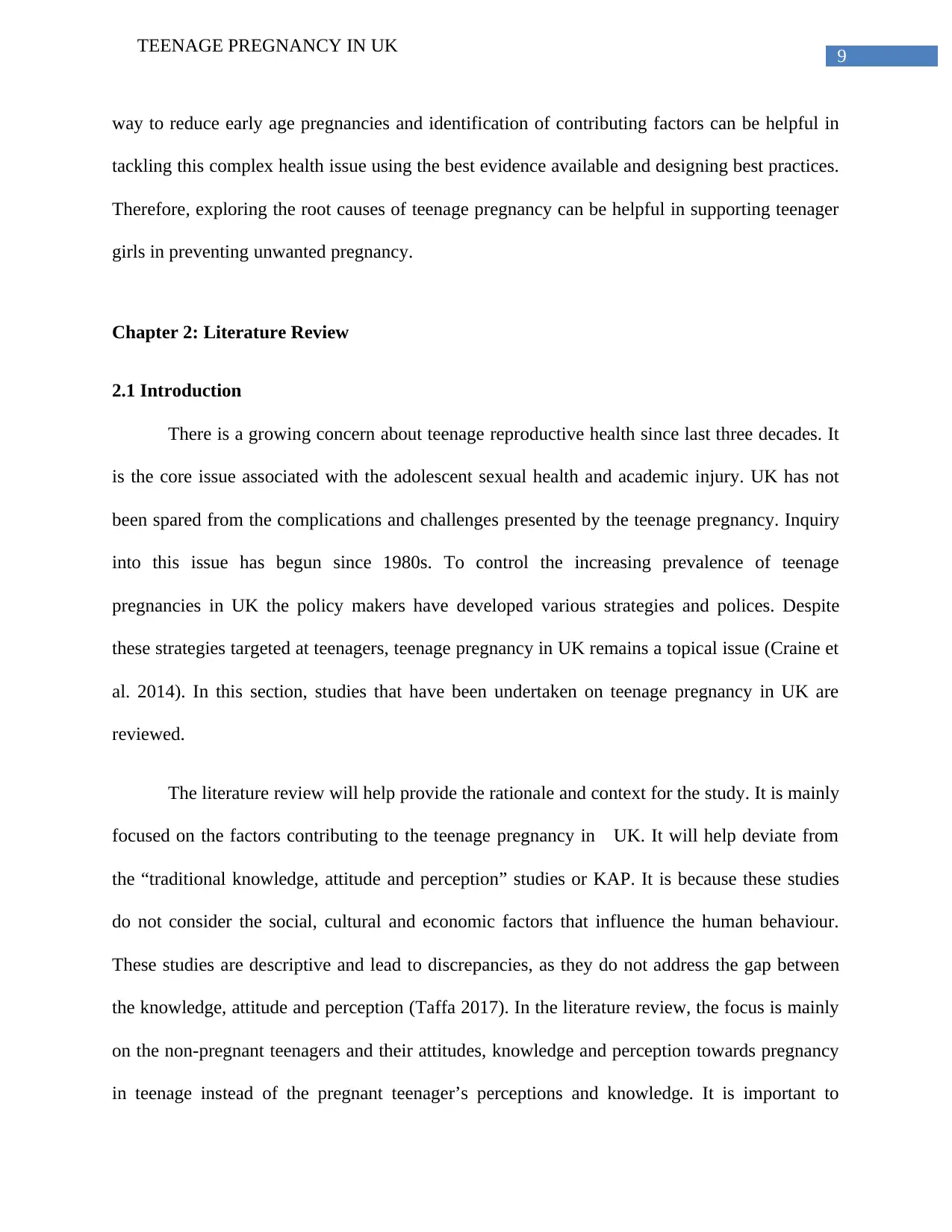
TEENAGE PREGNANCY IN UK
way to reduce early age pregnancies and identification of contributing factors can be helpful in
tackling this complex health issue using the best evidence available and designing best practices.
Therefore, exploring the root causes of teenage pregnancy can be helpful in supporting teenager
girls in preventing unwanted pregnancy.
Chapter 2: Literature Review
2.1 Introduction
There is a growing concern about teenage reproductive health since last three decades. It
is the core issue associated with the adolescent sexual health and academic injury. UK has not
been spared from the complications and challenges presented by the teenage pregnancy. Inquiry
into this issue has begun since 1980s. To control the increasing prevalence of teenage
pregnancies in UK the policy makers have developed various strategies and polices. Despite
these strategies targeted at teenagers, teenage pregnancy in UK remains a topical issue (Craine et
al. 2014). In this section, studies that have been undertaken on teenage pregnancy in UK are
reviewed.
The literature review will help provide the rationale and context for the study. It is mainly
focused on the factors contributing to the teenage pregnancy in UK. It will help deviate from
the “traditional knowledge, attitude and perception” studies or KAP. It is because these studies
do not consider the social, cultural and economic factors that influence the human behaviour.
These studies are descriptive and lead to discrepancies, as they do not address the gap between
the knowledge, attitude and perception (Taffa 2017). In the literature review, the focus is mainly
on the non-pregnant teenagers and their attitudes, knowledge and perception towards pregnancy
in teenage instead of the pregnant teenager’s perceptions and knowledge. It is important to
Paraphrase This Document
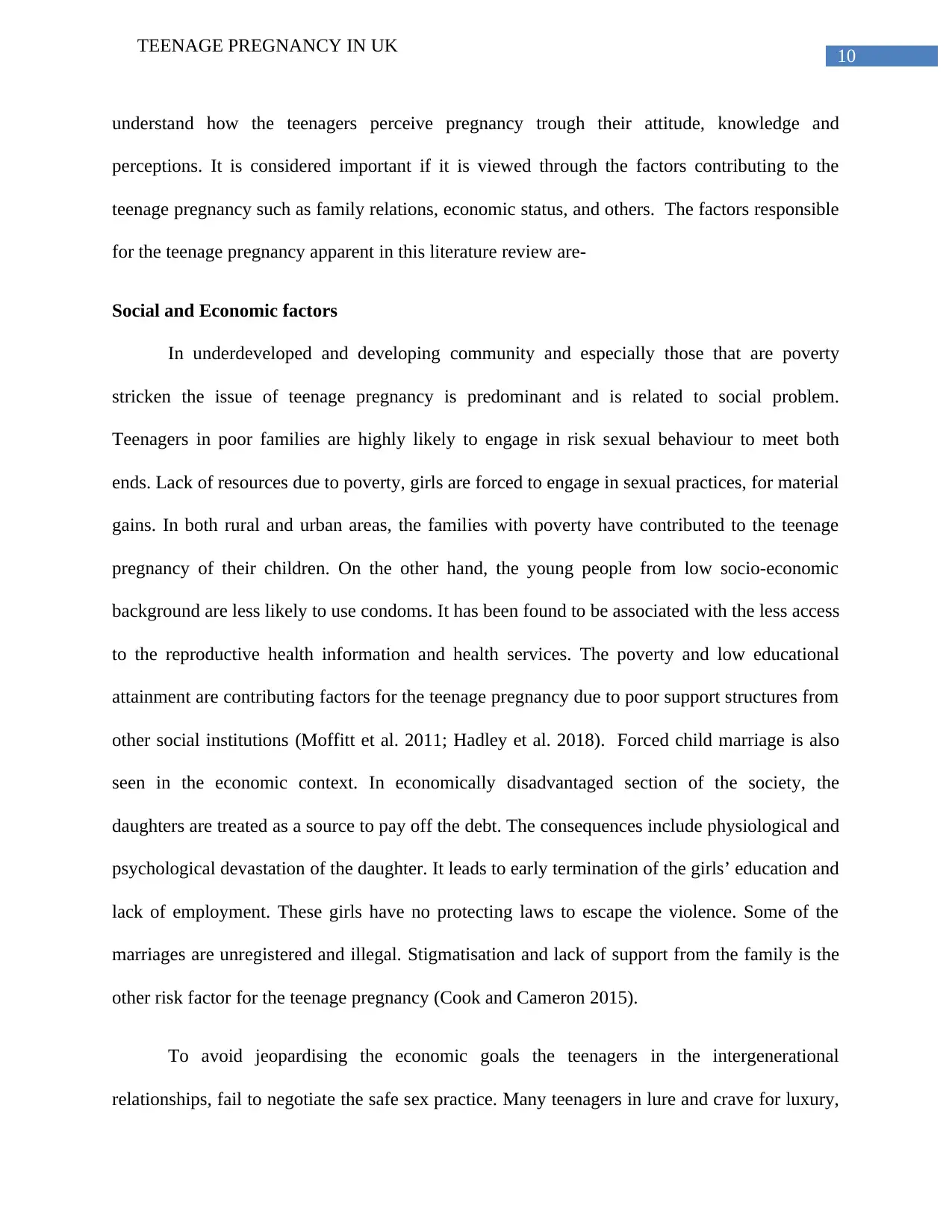
TEENAGE PREGNANCY IN UK
understand how the teenagers perceive pregnancy trough their attitude, knowledge and
perceptions. It is considered important if it is viewed through the factors contributing to the
teenage pregnancy such as family relations, economic status, and others. The factors responsible
for the teenage pregnancy apparent in this literature review are-
Social and Economic factors
In underdeveloped and developing community and especially those that are poverty
stricken the issue of teenage pregnancy is predominant and is related to social problem.
Teenagers in poor families are highly likely to engage in risk sexual behaviour to meet both
ends. Lack of resources due to poverty, girls are forced to engage in sexual practices, for material
gains. In both rural and urban areas, the families with poverty have contributed to the teenage
pregnancy of their children. On the other hand, the young people from low socio-economic
background are less likely to use condoms. It has been found to be associated with the less access
to the reproductive health information and health services. The poverty and low educational
attainment are contributing factors for the teenage pregnancy due to poor support structures from
other social institutions (Moffitt et al. 2011; Hadley et al. 2018). Forced child marriage is also
seen in the economic context. In economically disadvantaged section of the society, the
daughters are treated as a source to pay off the debt. The consequences include physiological and
psychological devastation of the daughter. It leads to early termination of the girls’ education and
lack of employment. These girls have no protecting laws to escape the violence. Some of the
marriages are unregistered and illegal. Stigmatisation and lack of support from the family is the
other risk factor for the teenage pregnancy (Cook and Cameron 2015).
To avoid jeopardising the economic goals the teenagers in the intergenerational
relationships, fail to negotiate the safe sex practice. Many teenagers in lure and crave for luxury,
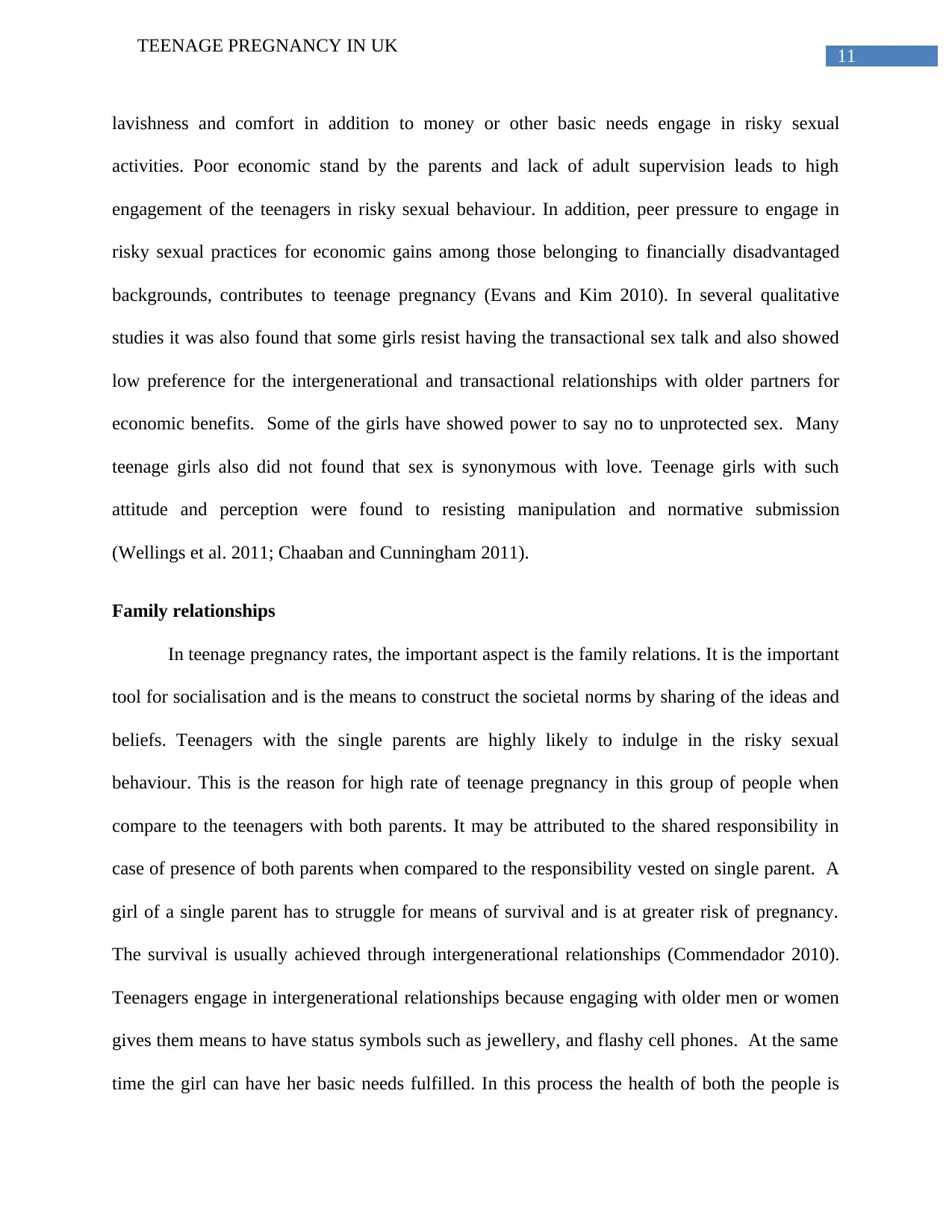
TEENAGE PREGNANCY IN UK
lavishness and comfort in addition to money or other basic needs engage in risky sexual
activities. Poor economic stand by the parents and lack of adult supervision leads to high
engagement of the teenagers in risky sexual behaviour. In addition, peer pressure to engage in
risky sexual practices for economic gains among those belonging to financially disadvantaged
backgrounds, contributes to teenage pregnancy (Evans and Kim 2010). In several qualitative
studies it was also found that some girls resist having the transactional sex talk and also showed
low preference for the intergenerational and transactional relationships with older partners for
economic benefits. Some of the girls have showed power to say no to unprotected sex. Many
teenage girls also did not found that sex is synonymous with love. Teenage girls with such
attitude and perception were found to resisting manipulation and normative submission
(Wellings et al. 2011; Chaaban and Cunningham 2011).
Family relationships
In teenage pregnancy rates, the important aspect is the family relations. It is the important
tool for socialisation and is the means to construct the societal norms by sharing of the ideas and
beliefs. Teenagers with the single parents are highly likely to indulge in the risky sexual
behaviour. This is the reason for high rate of teenage pregnancy in this group of people when
compare to the teenagers with both parents. It may be attributed to the shared responsibility in
case of presence of both parents when compared to the responsibility vested on single parent. A
girl of a single parent has to struggle for means of survival and is at greater risk of pregnancy.
The survival is usually achieved through intergenerational relationships (Commendador 2010).
Teenagers engage in intergenerational relationships because engaging with older men or women
gives them means to have status symbols such as jewellery, and flashy cell phones. At the same
time the girl can have her basic needs fulfilled. In this process the health of both the people is
⊘ This is a preview!⊘
Do you want full access?
Subscribe today to unlock all pages.

Trusted by 1+ million students worldwide
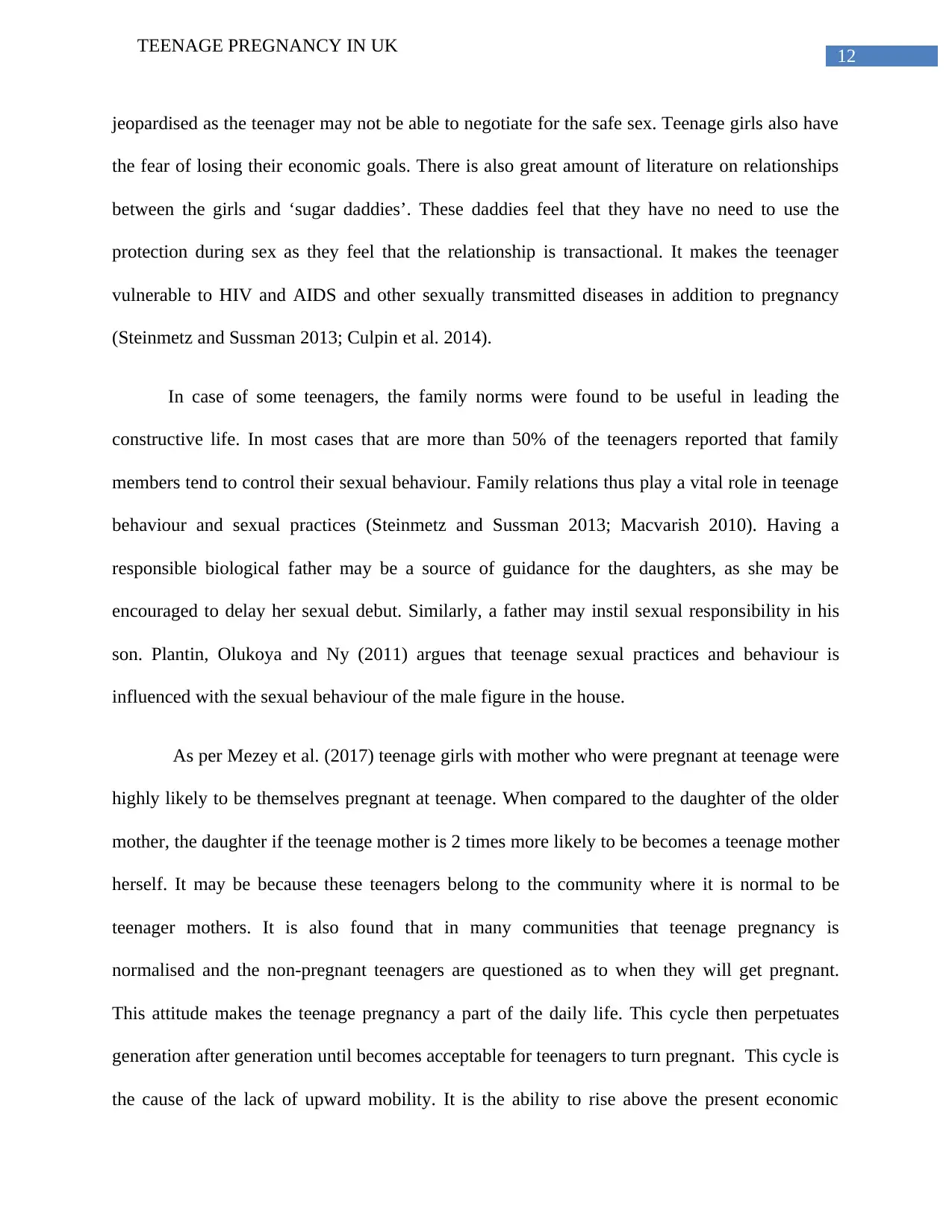
TEENAGE PREGNANCY IN UK
jeopardised as the teenager may not be able to negotiate for the safe sex. Teenage girls also have
the fear of losing their economic goals. There is also great amount of literature on relationships
between the girls and ‘sugar daddies’. These daddies feel that they have no need to use the
protection during sex as they feel that the relationship is transactional. It makes the teenager
vulnerable to HIV and AIDS and other sexually transmitted diseases in addition to pregnancy
(Steinmetz and Sussman 2013; Culpin et al. 2014).
In case of some teenagers, the family norms were found to be useful in leading the
constructive life. In most cases that are more than 50% of the teenagers reported that family
members tend to control their sexual behaviour. Family relations thus play a vital role in teenage
behaviour and sexual practices (Steinmetz and Sussman 2013; Macvarish 2010). Having a
responsible biological father may be a source of guidance for the daughters, as she may be
encouraged to delay her sexual debut. Similarly, a father may instil sexual responsibility in his
son. Plantin, Olukoya and Ny (2011) argues that teenage sexual practices and behaviour is
influenced with the sexual behaviour of the male figure in the house.
As per Mezey et al. (2017) teenage girls with mother who were pregnant at teenage were
highly likely to be themselves pregnant at teenage. When compared to the daughter of the older
mother, the daughter if the teenage mother is 2 times more likely to be becomes a teenage mother
herself. It may be because these teenagers belong to the community where it is normal to be
teenager mothers. It is also found that in many communities that teenage pregnancy is
normalised and the non-pregnant teenagers are questioned as to when they will get pregnant.
This attitude makes the teenage pregnancy a part of the daily life. This cycle then perpetuates
generation after generation until becomes acceptable for teenagers to turn pregnant. This cycle is
the cause of the lack of upward mobility. It is the ability to rise above the present economic
Paraphrase This Document
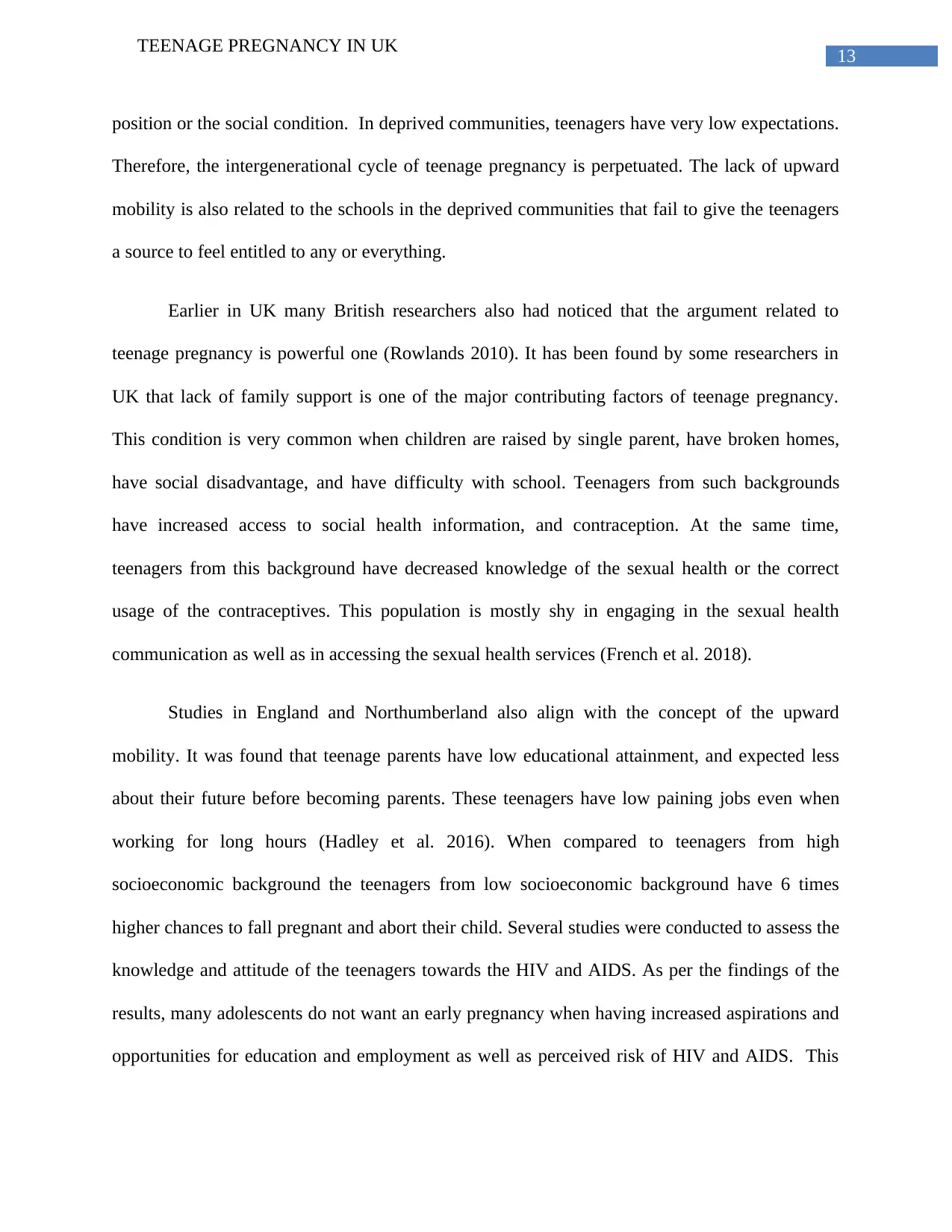
TEENAGE PREGNANCY IN UK
position or the social condition. In deprived communities, teenagers have very low expectations.
Therefore, the intergenerational cycle of teenage pregnancy is perpetuated. The lack of upward
mobility is also related to the schools in the deprived communities that fail to give the teenagers
a source to feel entitled to any or everything.
Earlier in UK many British researchers also had noticed that the argument related to
teenage pregnancy is powerful one (Rowlands 2010). It has been found by some researchers in
UK that lack of family support is one of the major contributing factors of teenage pregnancy.
This condition is very common when children are raised by single parent, have broken homes,
have social disadvantage, and have difficulty with school. Teenagers from such backgrounds
have increased access to social health information, and contraception. At the same time,
teenagers from this background have decreased knowledge of the sexual health or the correct
usage of the contraceptives. This population is mostly shy in engaging in the sexual health
communication as well as in accessing the sexual health services (French et al. 2018).
Studies in England and Northumberland also align with the concept of the upward
mobility. It was found that teenage parents have low educational attainment, and expected less
about their future before becoming parents. These teenagers have low paining jobs even when
working for long hours (Hadley et al. 2016). When compared to teenagers from high
socioeconomic background the teenagers from low socioeconomic background have 6 times
higher chances to fall pregnant and abort their child. Several studies were conducted to assess the
knowledge and attitude of the teenagers towards the HIV and AIDS. As per the findings of the
results, many adolescents do not want an early pregnancy when having increased aspirations and
opportunities for education and employment as well as perceived risk of HIV and AIDS. This

TEENAGE PREGNANCY IN UK
again validates the concept of upward mobility. Teenagers with high level of upward mobility
are highly likely to prevent themselves from early parenthood (Chaaban and Cunningham 2011).
Gender Dynamics
The health of the young people mandates considering the gender factors. In communities
like that of the Aboriginals, early marriages and traditional gender roles, are the vital determining
factors. In many rural areas, parents with low educational attainment perceive teenage pregnancy
as blessing (Rowlingson and McKay 2014). The policies and the guidelines related to youth and
adolescent health highlight that sexual abuse, sexual heath, sexual exploitation, coercive sex,
gender-based violence are the areas that subject the teenagers to greater risk of the HIV and
AIDS and teenage pregnancy (Rowlingson and McKay 2014). Unequal gender roles have been
associated with the teenage pregnancy. In most cases it was found that the power relations in any
relationships are altered by the sexual violence. In most cases women fail to negotiate safe sex.
Teenagers also are found to avoid negotiating contraceptive usage especially the use of the
condoms to avoid violent reactions from partners or emotional rejections In rural communities
the men have upper hand over women in terms of sexual matters. The females are constrained
due to the social and gender hierarchy. In addition, the condom negotiation has been found to be
complicated between teenagers themselves and also with the older partners (Widman et al.
2014). Evans (2013) argues that several girls are submissive when it comes to the sexual
intercourse and in many cases they make decisions consensually. However, this area needs
further exploration, as there are cases that contradict the fact that girls are the only victims. Boys
are also the victims of girls in regards to use of contraception and condoms. To better teenage
pregnancy, it is necessary to understand the context in which it is taking place. It is necessary to
understand the background of the boys. It is not known where the boys come from. One such
⊘ This is a preview!⊘
Do you want full access?
Subscribe today to unlock all pages.

Trusted by 1+ million students worldwide

TEENAGE PREGNANCY IN UK
background is considering the boys as “others” in the teenage pregnancy related discourse. Male
teenagers in several part of UK have been found to impregnate girls to show the sign of
masculinity and that giving birth at early age may strengthen their relationship with their
partners. More number of studies is focused on the girls in regards to the discourse on teenage
pregnancy who are suffering due to consequences of the teenage parenthood. There is less
highlighted studies on the males continuing their live without any disruption (McCall et al.
2014).
Early menarche, age at first sex, contraception
The age of the menarche was between 13 and 15 years of age. This is the age of increased
sexual activity and this is the age of higher possibility of conceiving. The average menarche was
found to be 11 years and first sexual intercourse was reported mostly between ages 11 and 14.
Protective factors like spiritual beliefs, strong relationship with parents and teachers leads to
decreased chances of early sexual debut. Lack of these factors and having the sexually active
friends increases the chances of the early sexual debut that is risk factors for teenage pregnancy
(Johns 2011). There is great surge in sexual development during this period with increased
secretion of hormones and appearance of secondary sexual characteristics. Increase in sexual
fantasy and sexual behaviours is very common. This behaviour is exacerbated with the exposure
to sexual titillation on TV and music video clips. The lack of right source of information
dissemination and sexual education leads to poor knowledge of contraception and safe sex (Kelly
et al. 2016). However, there are various communication gaps between children and parents due
to sex considered as taboo as well as cultural obligations. Lack of charity with parents pushes
teenagers to follow what peers say. This perpetuates the mystification and silence surrounding
sex (Rabeea’h et al. 2017). In urban cities and in cities with highly educated parents, teenagers
Paraphrase This Document
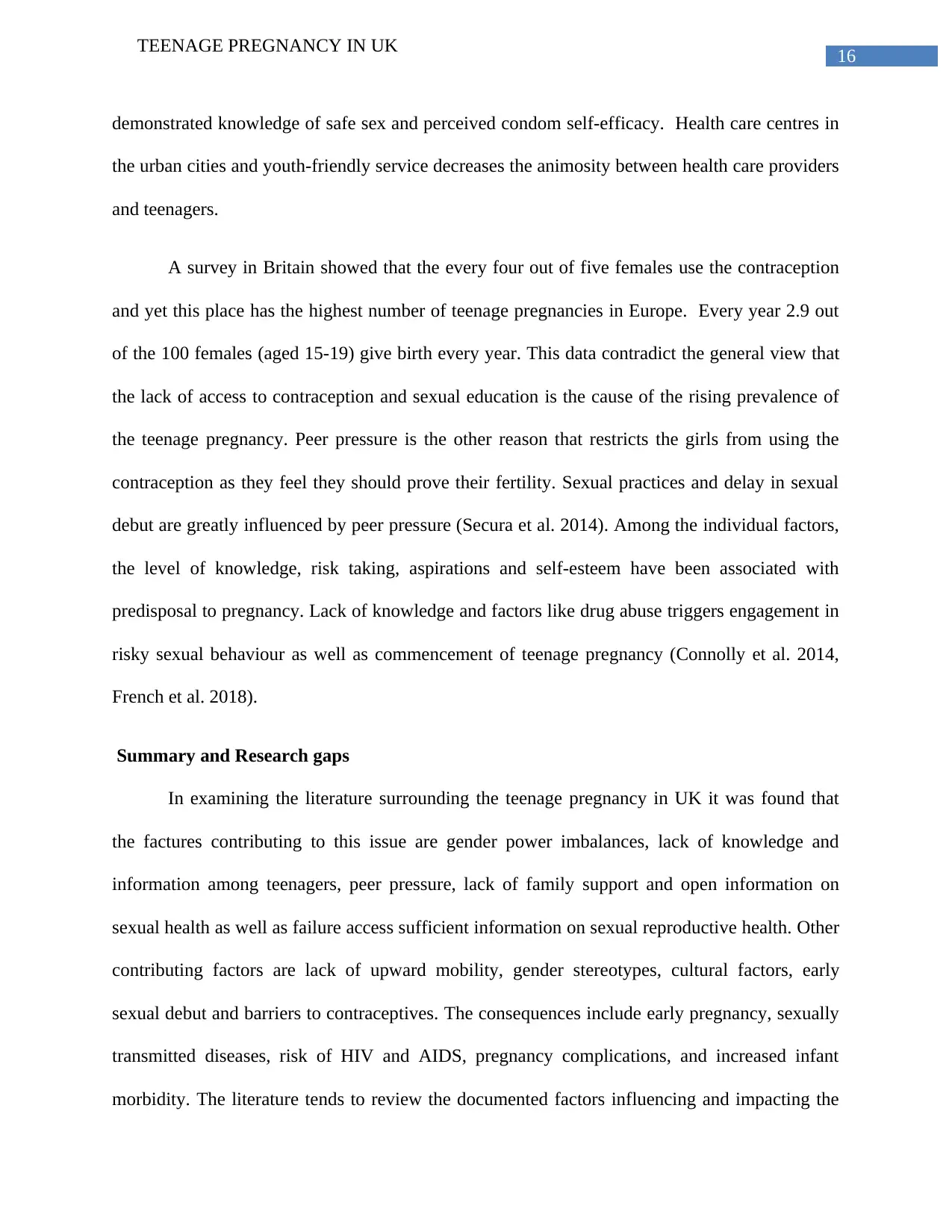
TEENAGE PREGNANCY IN UK
demonstrated knowledge of safe sex and perceived condom self-efficacy. Health care centres in
the urban cities and youth-friendly service decreases the animosity between health care providers
and teenagers.
A survey in Britain showed that the every four out of five females use the contraception
and yet this place has the highest number of teenage pregnancies in Europe. Every year 2.9 out
of the 100 females (aged 15-19) give birth every year. This data contradict the general view that
the lack of access to contraception and sexual education is the cause of the rising prevalence of
the teenage pregnancy. Peer pressure is the other reason that restricts the girls from using the
contraception as they feel they should prove their fertility. Sexual practices and delay in sexual
debut are greatly influenced by peer pressure (Secura et al. 2014). Among the individual factors,
the level of knowledge, risk taking, aspirations and self-esteem have been associated with
predisposal to pregnancy. Lack of knowledge and factors like drug abuse triggers engagement in
risky sexual behaviour as well as commencement of teenage pregnancy (Connolly et al. 2014,
French et al. 2018).
Summary and Research gaps
In examining the literature surrounding the teenage pregnancy in UK it was found that
the factures contributing to this issue are gender power imbalances, lack of knowledge and
information among teenagers, peer pressure, lack of family support and open information on
sexual health as well as failure access sufficient information on sexual reproductive health. Other
contributing factors are lack of upward mobility, gender stereotypes, cultural factors, early
sexual debut and barriers to contraceptives. The consequences include early pregnancy, sexually
transmitted diseases, risk of HIV and AIDS, pregnancy complications, and increased infant
morbidity. The literature tends to review the documented factors influencing and impacting the
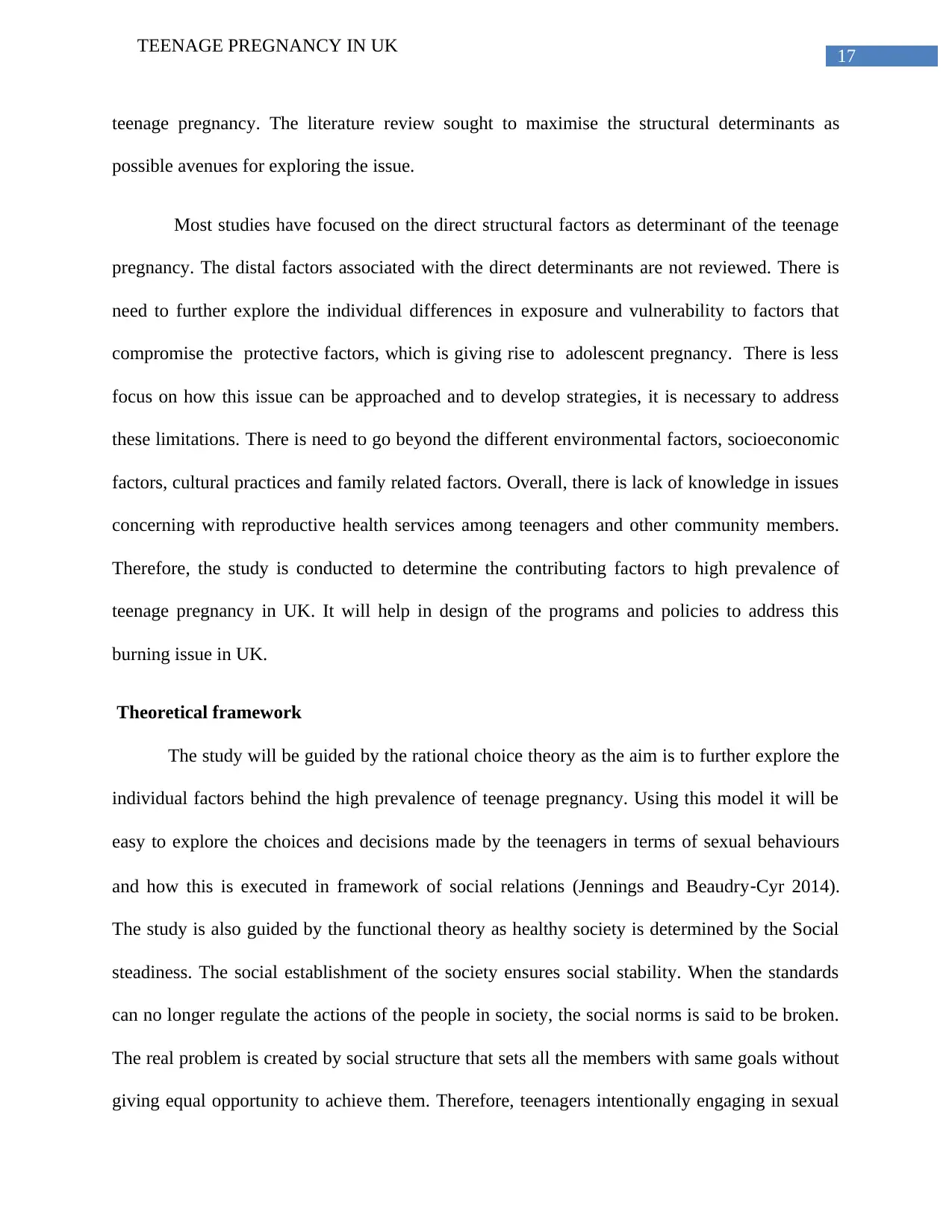
TEENAGE PREGNANCY IN UK
teenage pregnancy. The literature review sought to maximise the structural determinants as
possible avenues for exploring the issue.
Most studies have focused on the direct structural factors as determinant of the teenage
pregnancy. The distal factors associated with the direct determinants are not reviewed. There is
need to further explore the individual differences in exposure and vulnerability to factors that
compromise the protective factors, which is giving rise to adolescent pregnancy. There is less
focus on how this issue can be approached and to develop strategies, it is necessary to address
these limitations. There is need to go beyond the different environmental factors, socioeconomic
factors, cultural practices and family related factors. Overall, there is lack of knowledge in issues
concerning with reproductive health services among teenagers and other community members.
Therefore, the study is conducted to determine the contributing factors to high prevalence of
teenage pregnancy in UK. It will help in design of the programs and policies to address this
burning issue in UK.
Theoretical framework
The study will be guided by the rational choice theory as the aim is to further explore the
individual factors behind the high prevalence of teenage pregnancy. Using this model it will be
easy to explore the choices and decisions made by the teenagers in terms of sexual behaviours
and how this is executed in framework of social relations (Jennings and Beaudry‐Cyr 2014).
The study is also guided by the functional theory as healthy society is determined by the Social
steadiness. The social establishment of the society ensures social stability. When the standards
can no longer regulate the actions of the people in society, the social norms is said to be broken.
The real problem is created by social structure that sets all the members with same goals without
giving equal opportunity to achieve them. Therefore, teenagers intentionally engaging in sexual
⊘ This is a preview!⊘
Do you want full access?
Subscribe today to unlock all pages.

Trusted by 1+ million students worldwide
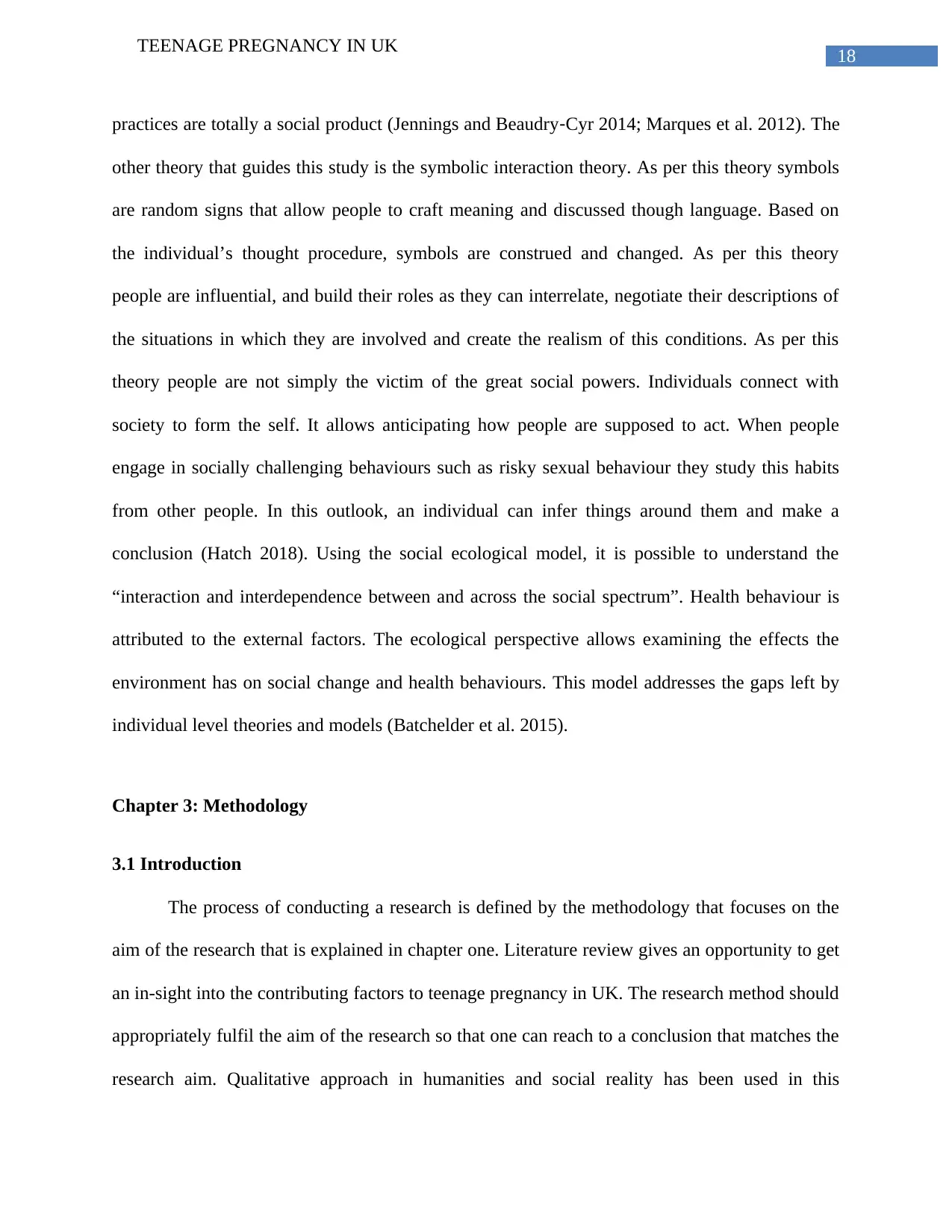
TEENAGE PREGNANCY IN UK
practices are totally a social product (Jennings and Beaudry‐Cyr 2014; Marques et al. 2012). The
other theory that guides this study is the symbolic interaction theory. As per this theory symbols
are random signs that allow people to craft meaning and discussed though language. Based on
the individual’s thought procedure, symbols are construed and changed. As per this theory
people are influential, and build their roles as they can interrelate, negotiate their descriptions of
the situations in which they are involved and create the realism of this conditions. As per this
theory people are not simply the victim of the great social powers. Individuals connect with
society to form the self. It allows anticipating how people are supposed to act. When people
engage in socially challenging behaviours such as risky sexual behaviour they study this habits
from other people. In this outlook, an individual can infer things around them and make a
conclusion (Hatch 2018). Using the social ecological model, it is possible to understand the
“interaction and interdependence between and across the social spectrum”. Health behaviour is
attributed to the external factors. The ecological perspective allows examining the effects the
environment has on social change and health behaviours. This model addresses the gaps left by
individual level theories and models (Batchelder et al. 2015).
Chapter 3: Methodology
3.1 Introduction
The process of conducting a research is defined by the methodology that focuses on the
aim of the research that is explained in chapter one. Literature review gives an opportunity to get
an in-sight into the contributing factors to teenage pregnancy in UK. The research method should
appropriately fulfil the aim of the research so that one can reach to a conclusion that matches the
research aim. Qualitative approach in humanities and social reality has been used in this
Paraphrase This Document

TEENAGE PREGNANCY IN UK
dissertation. This design sough to explore the contributing factors to teenage pregnancy among
13-19 years old girls within the UK region. The studying of factors in relation to consequences
of adolescent pregnancy can help to promote reduction in teen pregnancy rates with
identification of barriers that hinder teenagers from accessing contraceptives, sex education and
maternity services.
The qualitative research that is employed in this current research is concerned with
understanding of factors in UK that contribute to high teenage pregnancy with an impact on the
health services in UK regarding teenage pregnancy. An exploration of literature that is related to
the research topic. A qualitative approach that is involved in this systematic literature review
helped in enhancing an understanding of teenage pregnancy factors that contribute to high birth
rate among teenagers living in poverty (Taylor, Bogdan and DeVault 2015). The research intends
to focus on the factors that predispose teenagers to early pregnancy. It would also help to
understand why adolescents are subjected to pregnancies while looking at the parental
attachment and support that act as protective factors useful in understanding parenting role as
control factor in teenage pregnancy prevention. Barriers would also help in exploring individual
factors beyond institutional obstacles to contraception use. The understanding of these factors is
crucial as it provides a comprehensive insight into challenges that need to be targeted in
enhancing contraception use among teenagers in UK.
This chapter will demonstrate the steps involved in the conduction of a systematic
literature review that can be narrowed down to obtain the final selected articles. The databases,
keywords, research approach, bibliographic aids, data collection, inclusion and exclusion criteria,
search strategy and outcomes along with ethical considerations and research limitations are
entailed in this section.
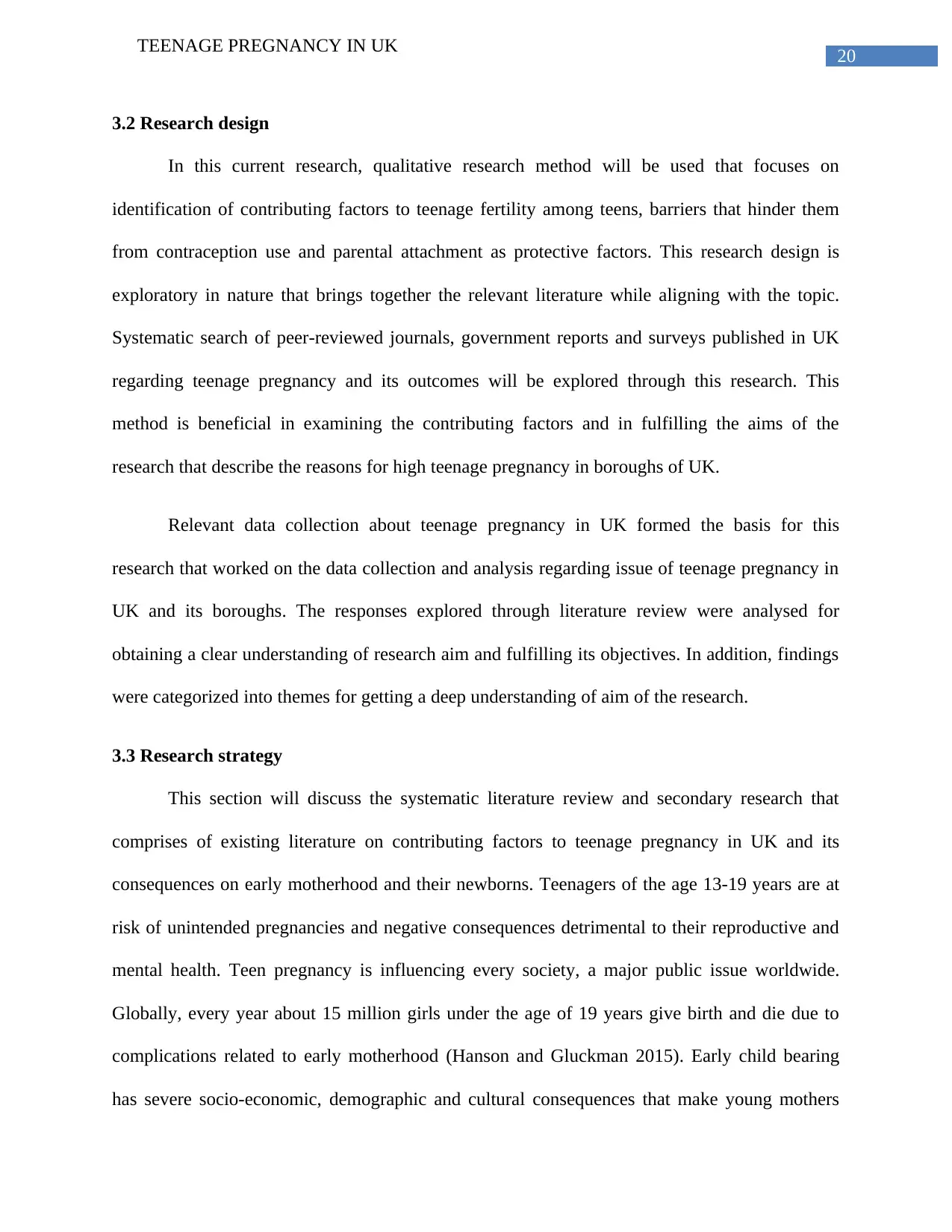
TEENAGE PREGNANCY IN UK
3.2 Research design
In this current research, qualitative research method will be used that focuses on
identification of contributing factors to teenage fertility among teens, barriers that hinder them
from contraception use and parental attachment as protective factors. This research design is
exploratory in nature that brings together the relevant literature while aligning with the topic.
Systematic search of peer-reviewed journals, government reports and surveys published in UK
regarding teenage pregnancy and its outcomes will be explored through this research. This
method is beneficial in examining the contributing factors and in fulfilling the aims of the
research that describe the reasons for high teenage pregnancy in boroughs of UK.
Relevant data collection about teenage pregnancy in UK formed the basis for this
research that worked on the data collection and analysis regarding issue of teenage pregnancy in
UK and its boroughs. The responses explored through literature review were analysed for
obtaining a clear understanding of research aim and fulfilling its objectives. In addition, findings
were categorized into themes for getting a deep understanding of aim of the research.
3.3 Research strategy
This section will discuss the systematic literature review and secondary research that
comprises of existing literature on contributing factors to teenage pregnancy in UK and its
consequences on early motherhood and their newborns. Teenagers of the age 13-19 years are at
risk of unintended pregnancies and negative consequences detrimental to their reproductive and
mental health. Teen pregnancy is influencing every society, a major public issue worldwide.
Globally, every year about 15 million girls under the age of 19 years give birth and die due to
complications related to early motherhood (Hanson and Gluckman 2015). Early child bearing
has severe socio-economic, demographic and cultural consequences that make young mothers
⊘ This is a preview!⊘
Do you want full access?
Subscribe today to unlock all pages.

Trusted by 1+ million students worldwide

TEENAGE PREGNANCY IN UK
and their infants prone to poor health associated with high mortality and morbidity rates. They
experience socio-economic disadvantage and younger the mother, greater will be the likelihood
of making their infants experience poor health complications.
Early age pregnancy demands increased nutritional requirement for both the growing
foetus and the mother. The teenage mother is subjected to malnutrition and suffers from
pregnancy-related complications during labour, premature delivery and foetal growth retardation
(Mollborn 2010). There is a need to reduce teenage pregnancy rates to avoid such fatal
complications and adverse health outcomes. Therefore, this dissertation will derive themes from
the data collected from literature review. Finally, findings of the literature review will be used to
suggest recommendations and draw conclusions.
3.4 Data collection and analysis
The data collection in this current research gathers information in systematic manner that
is based on variables of interest that enables them to answer the aims of the research and search
outcomes evaluation. A systematic literature review is the stepping-stone in a research that
would help to determine what is already known about research proposal (Jesson, Matheson and
Lacey 2011). Data collection method is divided into two forms: primary and secondary data
collection. This research will use secondary data collection method. The conclusions will be
drawn from the existing studies conducted by authors that are primary research like trials and
surveys. Systematic literature review helps to synthesize evidence from highest quality research
that is relevant to the research aim and generate new evidence that fills the literature gap (Booth,
Sutton and Papaioannou 2016). In the current research, the review clearly addresses the research
aim and employs explicit methods like identification and selection of publications that is relevant
Paraphrase This Document
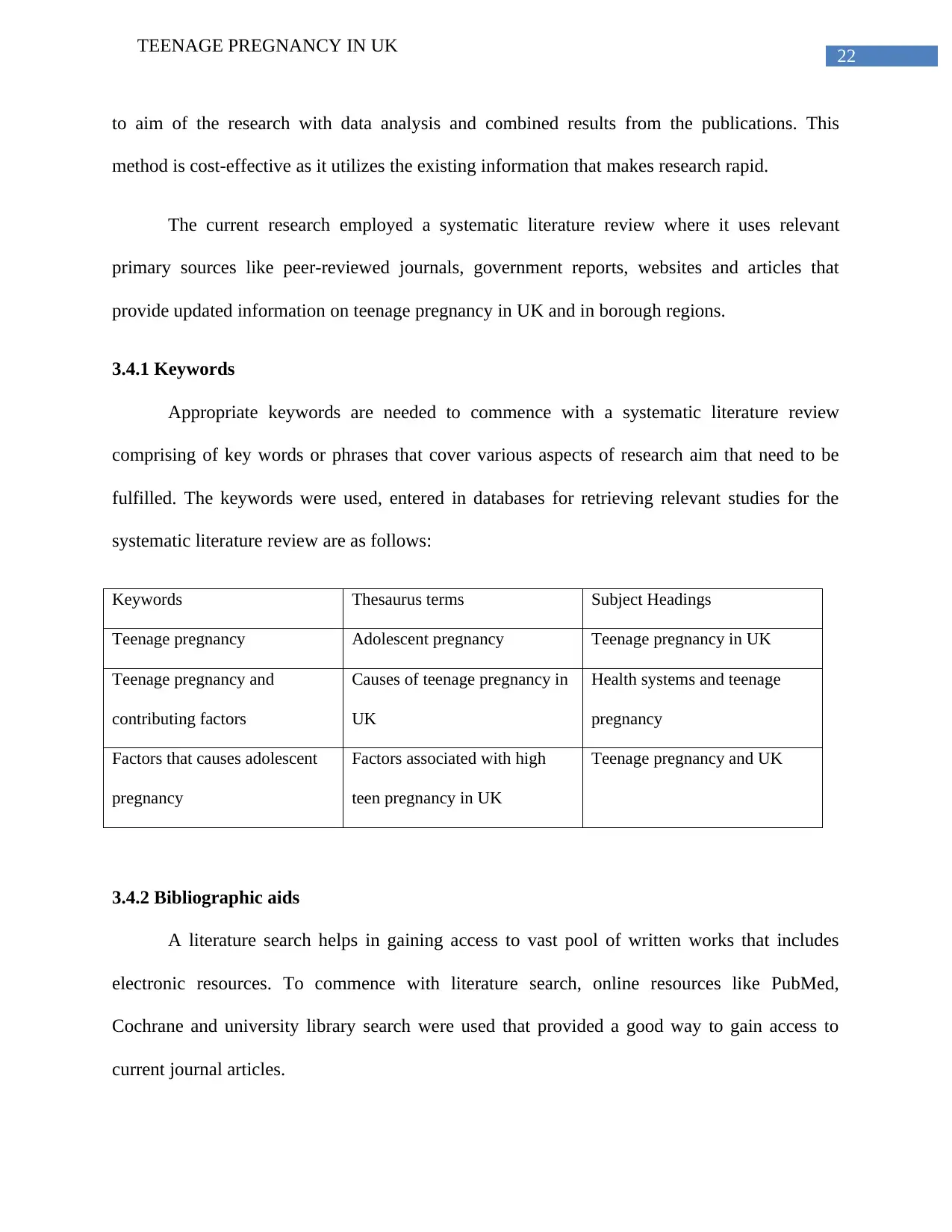
TEENAGE PREGNANCY IN UK
to aim of the research with data analysis and combined results from the publications. This
method is cost-effective as it utilizes the existing information that makes research rapid.
The current research employed a systematic literature review where it uses relevant
primary sources like peer-reviewed journals, government reports, websites and articles that
provide updated information on teenage pregnancy in UK and in borough regions.
3.4.1 Keywords
Appropriate keywords are needed to commence with a systematic literature review
comprising of key words or phrases that cover various aspects of research aim that need to be
fulfilled. The keywords were used, entered in databases for retrieving relevant studies for the
systematic literature review are as follows:
Keywords Thesaurus terms Subject Headings
Teenage pregnancy Adolescent pregnancy Teenage pregnancy in UK
Teenage pregnancy and
contributing factors
Causes of teenage pregnancy in
UK
Health systems and teenage
pregnancy
Factors that causes adolescent
pregnancy
Factors associated with high
teen pregnancy in UK
Teenage pregnancy and UK
3.4.2 Bibliographic aids
A literature search helps in gaining access to vast pool of written works that includes
electronic resources. To commence with literature search, online resources like PubMed,
Cochrane and university library search were used that provided a good way to gain access to
current journal articles.
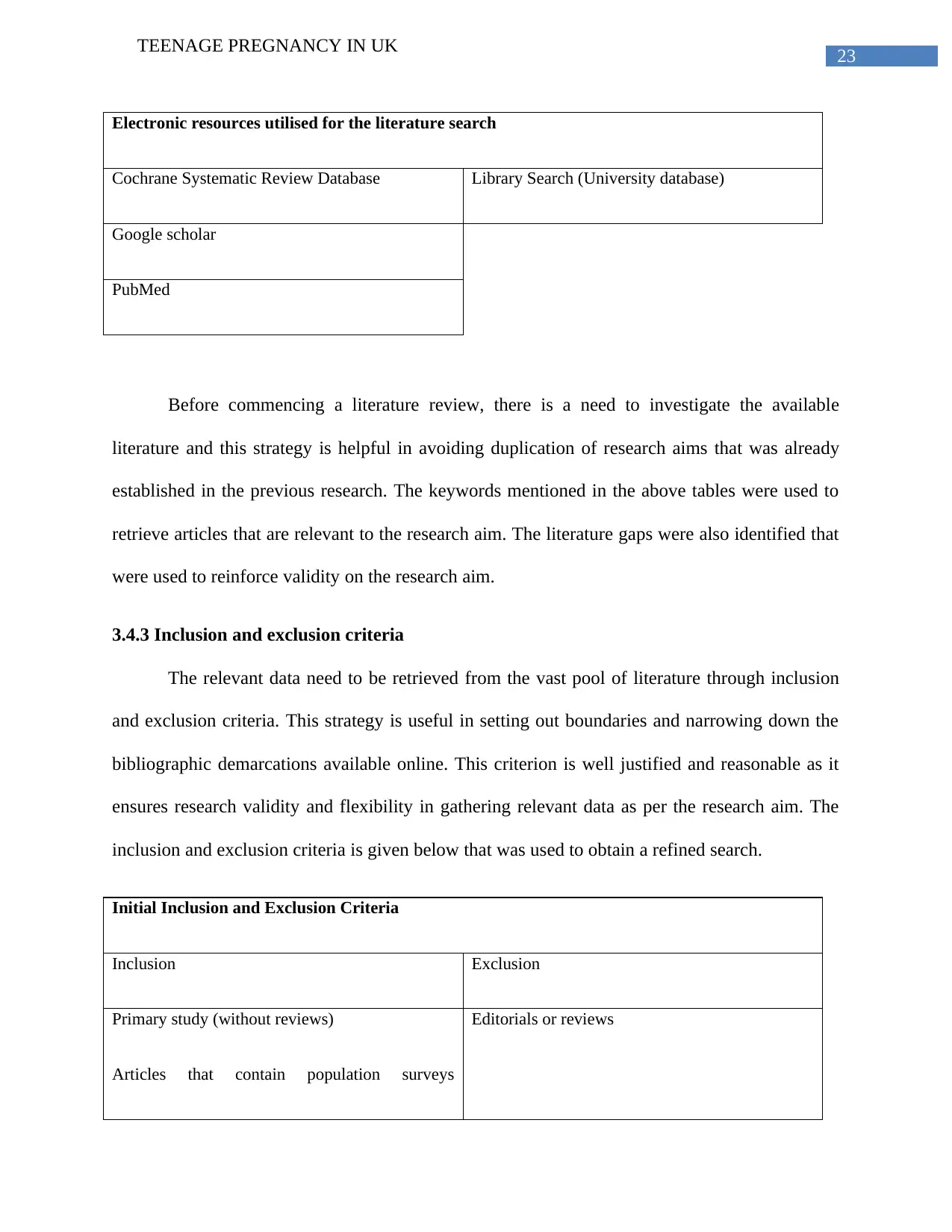
TEENAGE PREGNANCY IN UK
Electronic resources utilised for the literature search
Cochrane Systematic Review Database Library Search (University database)
Google scholar
PubMed
Before commencing a literature review, there is a need to investigate the available
literature and this strategy is helpful in avoiding duplication of research aims that was already
established in the previous research. The keywords mentioned in the above tables were used to
retrieve articles that are relevant to the research aim. The literature gaps were also identified that
were used to reinforce validity on the research aim.
3.4.3 Inclusion and exclusion criteria
The relevant data need to be retrieved from the vast pool of literature through inclusion
and exclusion criteria. This strategy is useful in setting out boundaries and narrowing down the
bibliographic demarcations available online. This criterion is well justified and reasonable as it
ensures research validity and flexibility in gathering relevant data as per the research aim. The
inclusion and exclusion criteria is given below that was used to obtain a refined search.
Initial Inclusion and Exclusion Criteria
Inclusion Exclusion
Primary study (without reviews)
Articles that contain population surveys
Editorials or reviews
⊘ This is a preview!⊘
Do you want full access?
Subscribe today to unlock all pages.

Trusted by 1+ million students worldwide

TEENAGE PREGNANCY IN UK
conducted in UK
Articles that explore contributing factors to
teenage pregnancy in UK
Articles published in peer-reviewed journals
Language: English Published in foreign languages
Year of publication: 2008 to 2018 Older than 2008
Peer reviewed journal articles Unpublished manuscripts and abstracts
Book chapters
Case studies
Dissertation
Case studies
Research methods: Qualitative
3.4.4 Secondary research
This research involves the examining of existing data that is relevant to the research
topic. Reliability and validity are the two essential criteria that can be helpful in assessing the
quality of the research study (Drost 2011). This greatly evaluates the research methods that
measure the important concepts that need to be explored. The articles that are published before
2008 were not included in the study as updated results relevant to the literature were included.
Paraphrase This Document

TEENAGE PREGNANCY IN UK
3.4.5 Search outcomes
Google Scholar was used that gave a detailed insight into the research articles that are
available online. There was adjustment of publication year after the inclusion and exclusion
criteria and the number reached to 500. This figure revealed that a vast pool of literature is
available online relevant to the research aim comprising of relevant journal articles and
government reports that were published for the common people.
A search was conducted after entering keywords in the databases that aided in obtaining
500 articles that were assessed and included in the study. Duplicate studies were screened and
excluded. The abstracts were reviewed for relevancy to research aim and those articles that
appeared irrelevant were excluded from the study. After removal of duplications from the initial
search, the number came to 50. Full-text articles were screened and it was found that about 10
articles were retrieved that addressed research aim of studying the contributing factors to teenage
pregnancy in UK.
Boolean operators were used that helped in associating the key phrases or words that
narrowed and refined the search. AND and OR operators were used for contrasting and
comparing the key phrases or words as per search strategy. This strategy saved time that would
be wasted in manual screening of articles. The Google Scholar was used where search items
were entered to search journal articles relevant to research topic. Electronic databases, broad
phrases or keywords helped in increasing chances of getting maximum relevant articles to the
research aim.
3.4.6 Methods of data analysis
Sample Author Year Title Source Location
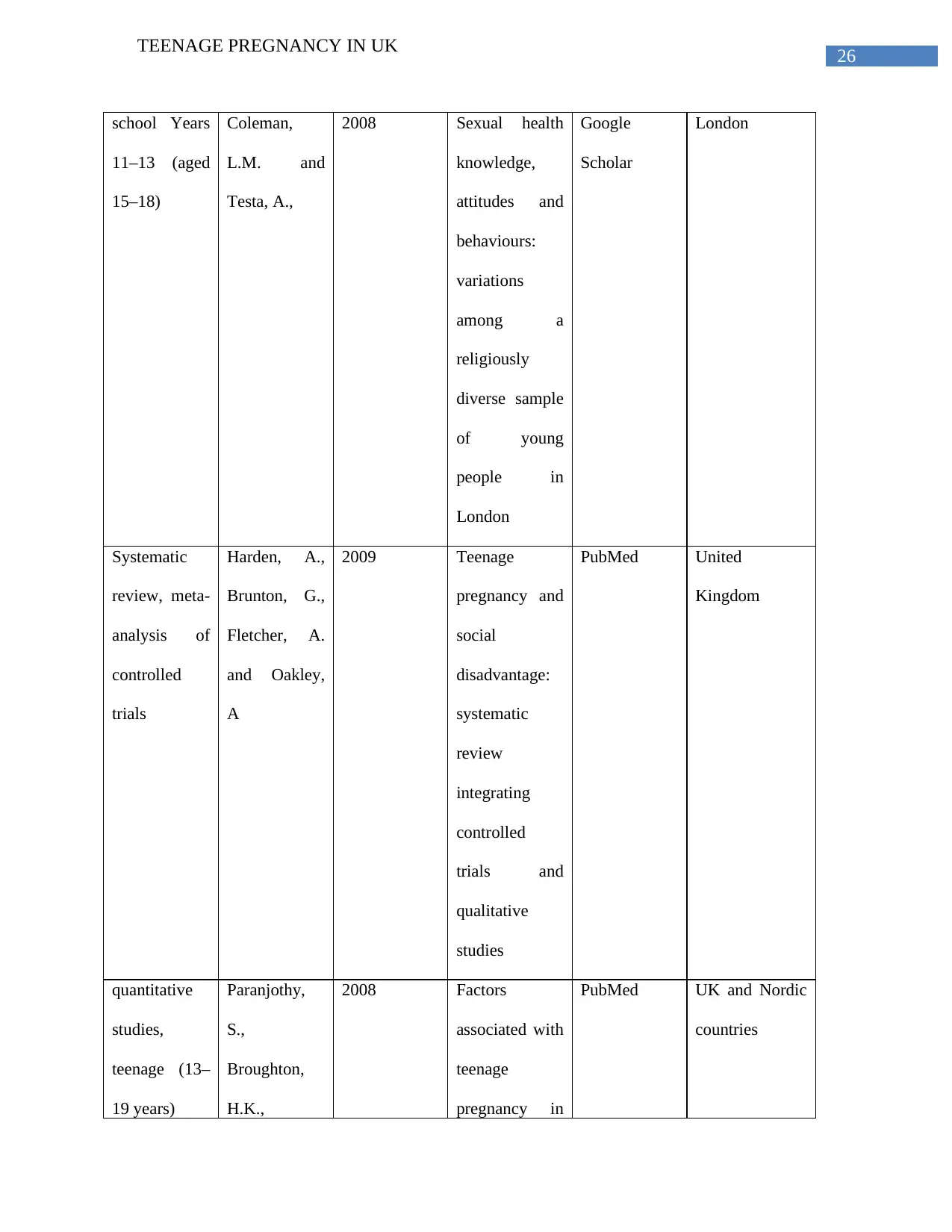
TEENAGE PREGNANCY IN UK
school Years
11–13 (aged
15–18)
Coleman,
L.M. and
Testa, A.,
2008 Sexual health
knowledge,
attitudes and
behaviours:
variations
among a
religiously
diverse sample
of young
people in
London
Scholar
London
Systematic
review, meta-
analysis of
controlled
trials
Harden, A.,
Brunton, G.,
Fletcher, A.
and Oakley,
A
2009 Teenage
pregnancy and
social
disadvantage:
systematic
review
integrating
controlled
trials and
qualitative
studies
PubMed United
Kingdom
quantitative
studies,
teenage (13–
19 years)
Paranjothy,
S.,
Broughton,
H.K.,
2008 Factors
associated with
teenage
pregnancy in
PubMed UK and Nordic
countries
⊘ This is a preview!⊘
Do you want full access?
Subscribe today to unlock all pages.

Trusted by 1+ million students worldwide
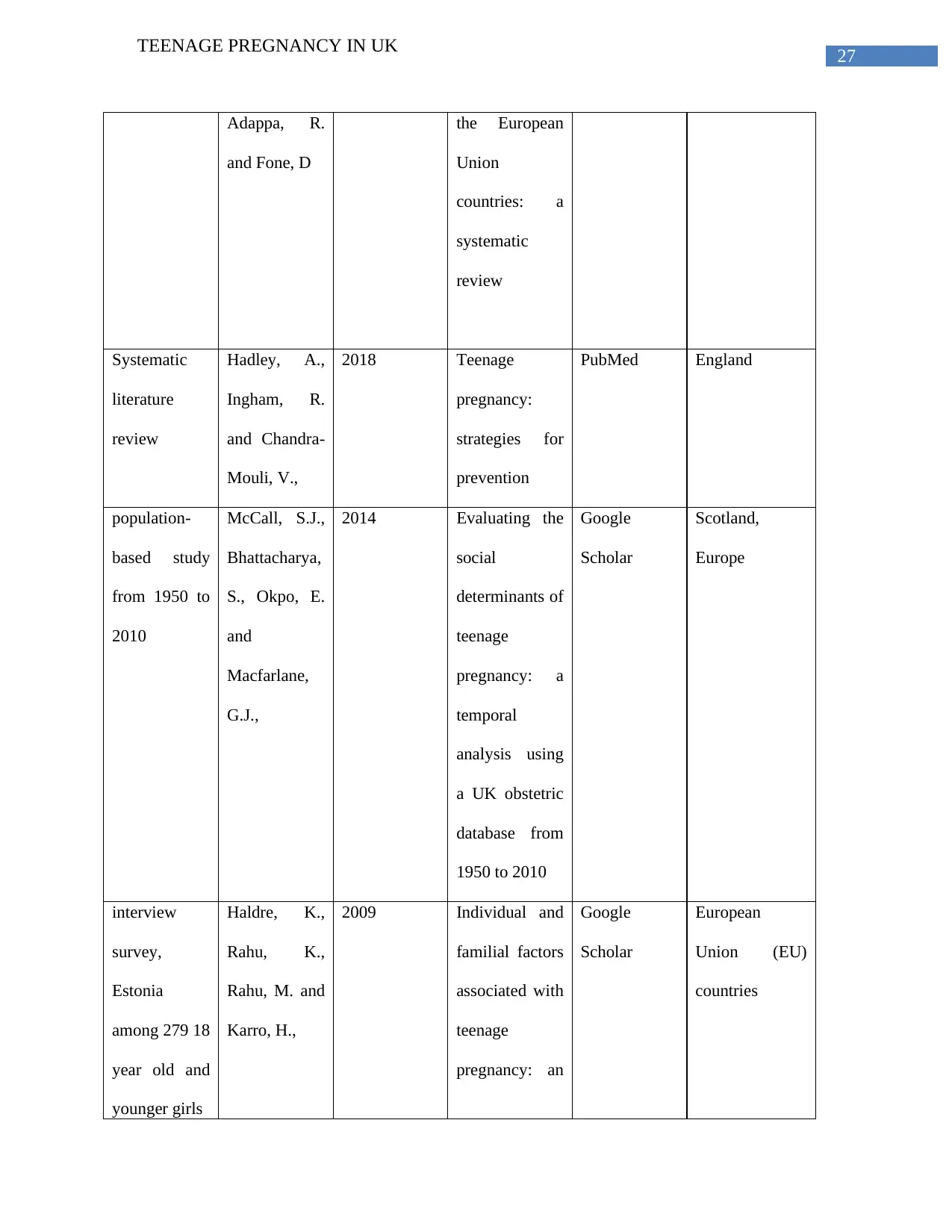
TEENAGE PREGNANCY IN UK
Adappa, R.
and Fone, D
the European
Union
countries: a
systematic
review
Systematic
literature
review
Hadley, A.,
Ingham, R.
and Chandra-
Mouli, V.,
2018 Teenage
pregnancy:
strategies for
prevention
PubMed England
population-
based study
from 1950 to
2010
McCall, S.J.,
Bhattacharya,
S., Okpo, E.
and
Macfarlane,
G.J.,
2014 Evaluating the
social
determinants of
teenage
pregnancy: a
temporal
analysis using
a UK obstetric
database from
1950 to 2010
Scholar
Scotland,
Europe
interview
survey,
Estonia
among 279 18
year old and
younger girls
Haldre, K.,
Rahu, K.,
Rahu, M. and
Karro, H.,
2009 Individual and
familial factors
associated with
teenage
pregnancy: an
Scholar
European
Union (EU)
countries
Paraphrase This Document

TEENAGE PREGNANCY IN UK
interview study
Systematic
review
Whitaker, R.,
Hendry, M.,
Booth, A.,
Carter, B.,
Charles, J.,
Craine, N.,
Edwards,
R.T., Lyons,
M., Noyes, J.,
Pasterfield,
D. and
Rycroft-
Malone, J.,
2014 Intervention
Now To
Eliminate
Repeat
Unintended
Pregnancy in
Teenagers
(INTERUPT):
a systematic
review of
intervention
effectiveness
and cost-
effectiveness,
qualitative and
realist
synthesis of
implementatio
n factors and
user
engagement
PubMed Western
Europe, UK
semi-
structured
interviews, 95
Whitehead,
E.,
2009 Understanding
the association
between
Scholar
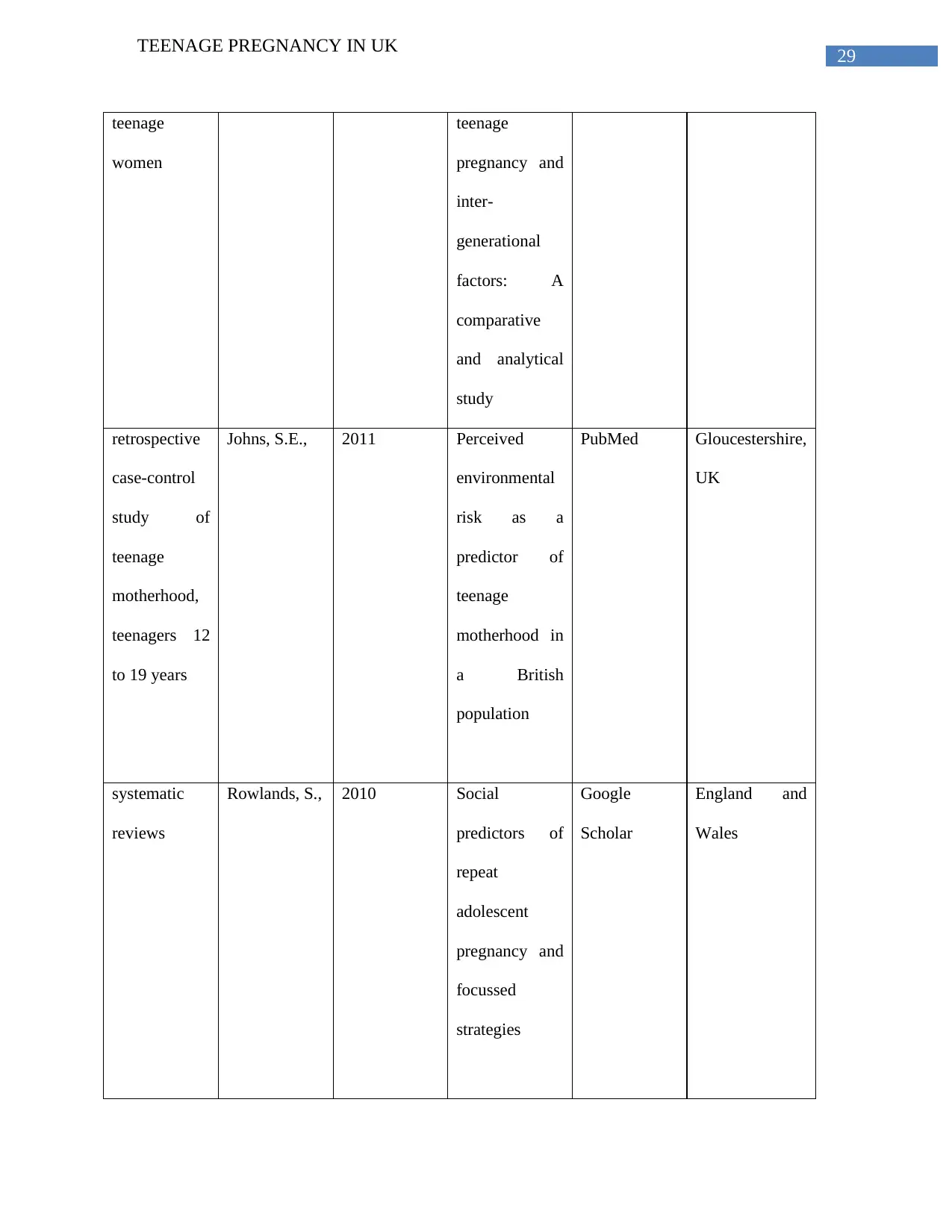
TEENAGE PREGNANCY IN UK
teenage
women
teenage
pregnancy and
inter-
generational
factors: A
comparative
and analytical
study
retrospective
case-control
study of
teenage
motherhood,
teenagers 12
to 19 years
Johns, S.E., 2011 Perceived
environmental
risk as a
predictor of
teenage
motherhood in
a British
population
PubMed Gloucestershire,
UK
systematic
reviews
Rowlands, S., 2010 Social
predictors of
repeat
adolescent
pregnancy and
focussed
strategies
Scholar
England and
Wales
⊘ This is a preview!⊘
Do you want full access?
Subscribe today to unlock all pages.

Trusted by 1+ million students worldwide
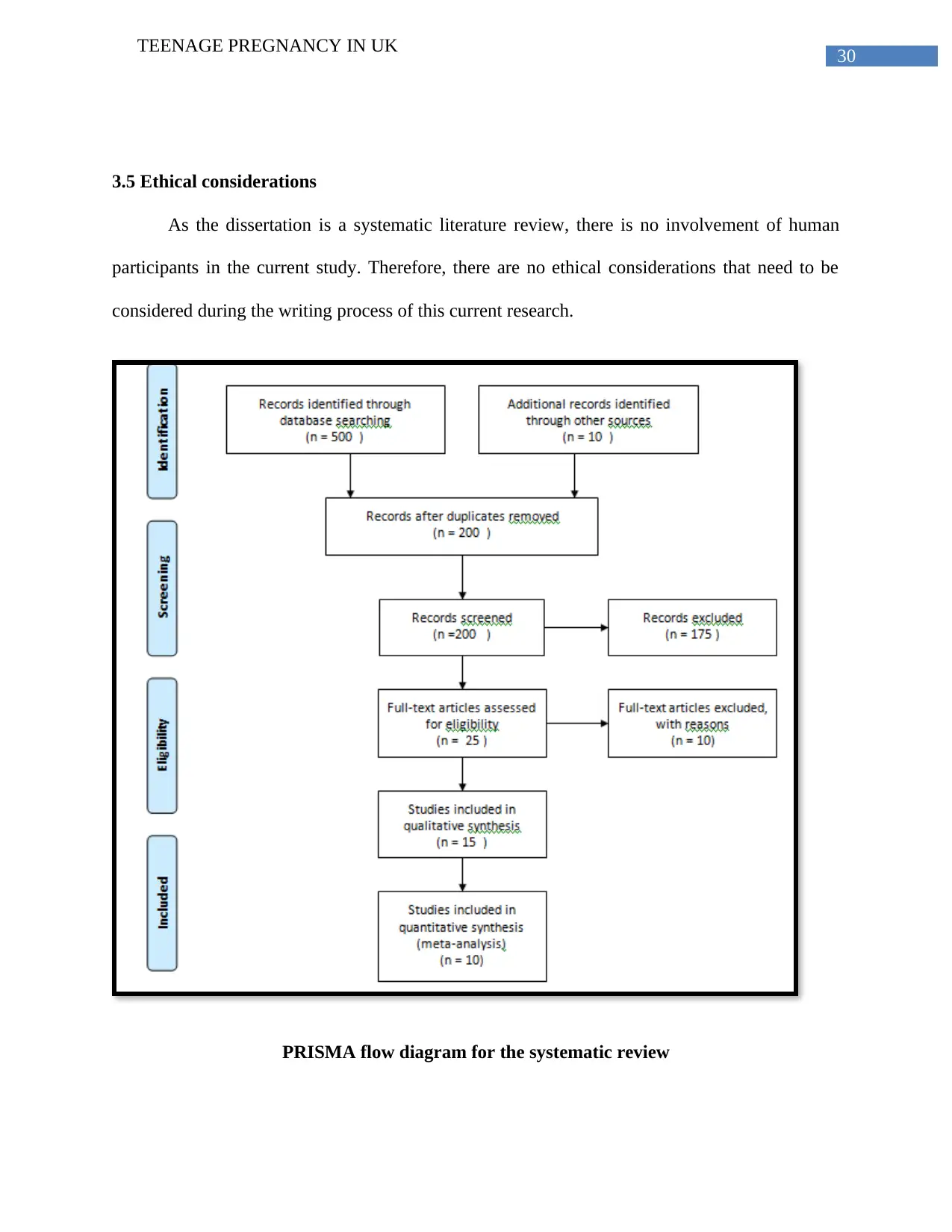
TEENAGE PREGNANCY IN UK
3.5 Ethical considerations
As the dissertation is a systematic literature review, there is no involvement of human
participants in the current study. Therefore, there are no ethical considerations that need to be
considered during the writing process of this current research.
PRISMA flow diagram for the systematic review
Paraphrase This Document
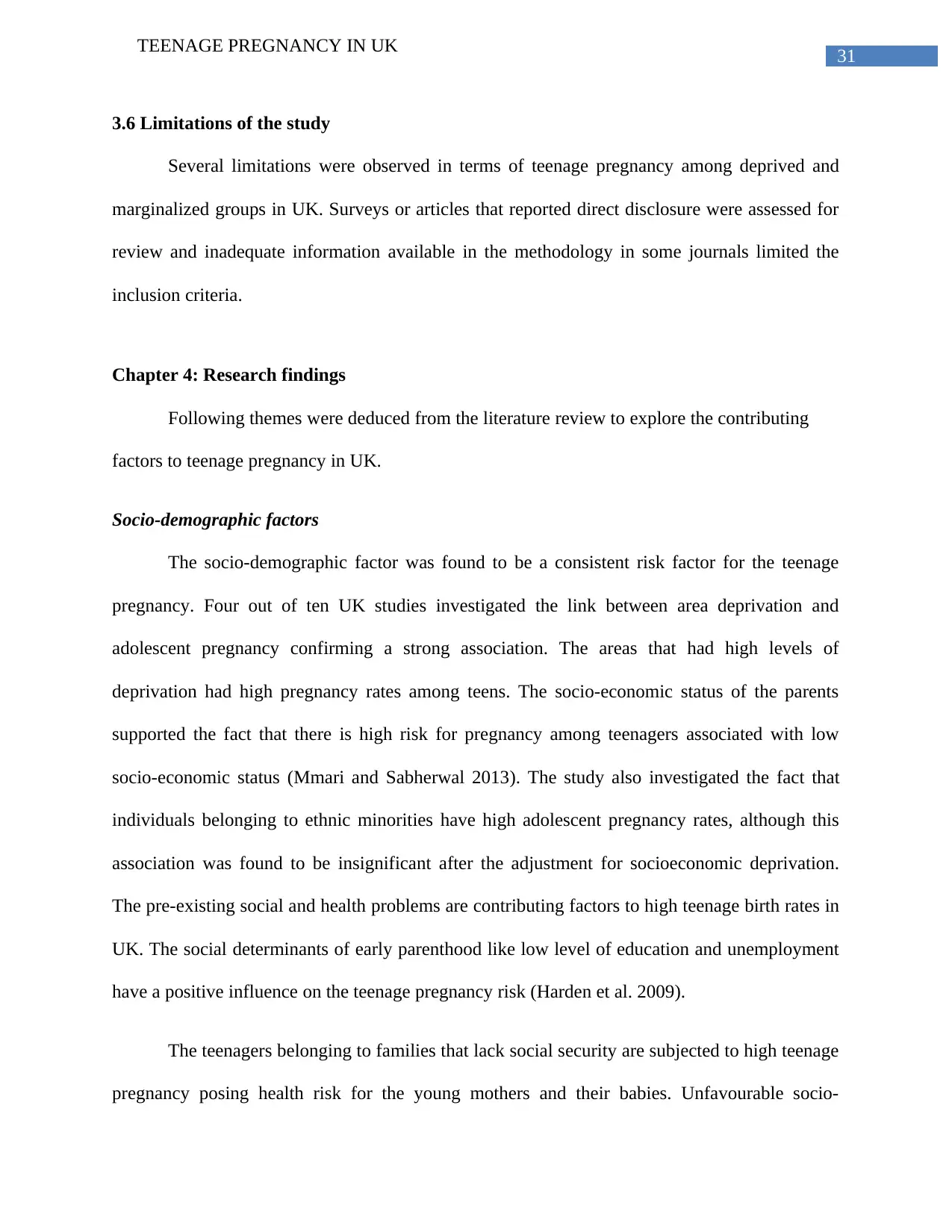
TEENAGE PREGNANCY IN UK
3.6 Limitations of the study
Several limitations were observed in terms of teenage pregnancy among deprived and
marginalized groups in UK. Surveys or articles that reported direct disclosure were assessed for
review and inadequate information available in the methodology in some journals limited the
inclusion criteria.
Chapter 4: Research findings
Following themes were deduced from the literature review to explore the contributing
factors to teenage pregnancy in UK.
Socio-demographic factors
The socio-demographic factor was found to be a consistent risk factor for the teenage
pregnancy. Four out of ten UK studies investigated the link between area deprivation and
adolescent pregnancy confirming a strong association. The areas that had high levels of
deprivation had high pregnancy rates among teens. The socio-economic status of the parents
supported the fact that there is high risk for pregnancy among teenagers associated with low
socio-economic status (Mmari and Sabherwal 2013). The study also investigated the fact that
individuals belonging to ethnic minorities have high adolescent pregnancy rates, although this
association was found to be insignificant after the adjustment for socioeconomic deprivation.
The pre-existing social and health problems are contributing factors to high teenage birth rates in
UK. The social determinants of early parenthood like low level of education and unemployment
have a positive influence on the teenage pregnancy risk (Harden et al. 2009).
The teenagers belonging to families that lack social security are subjected to high teenage
pregnancy posing health risk for the young mothers and their babies. Unfavourable socio-
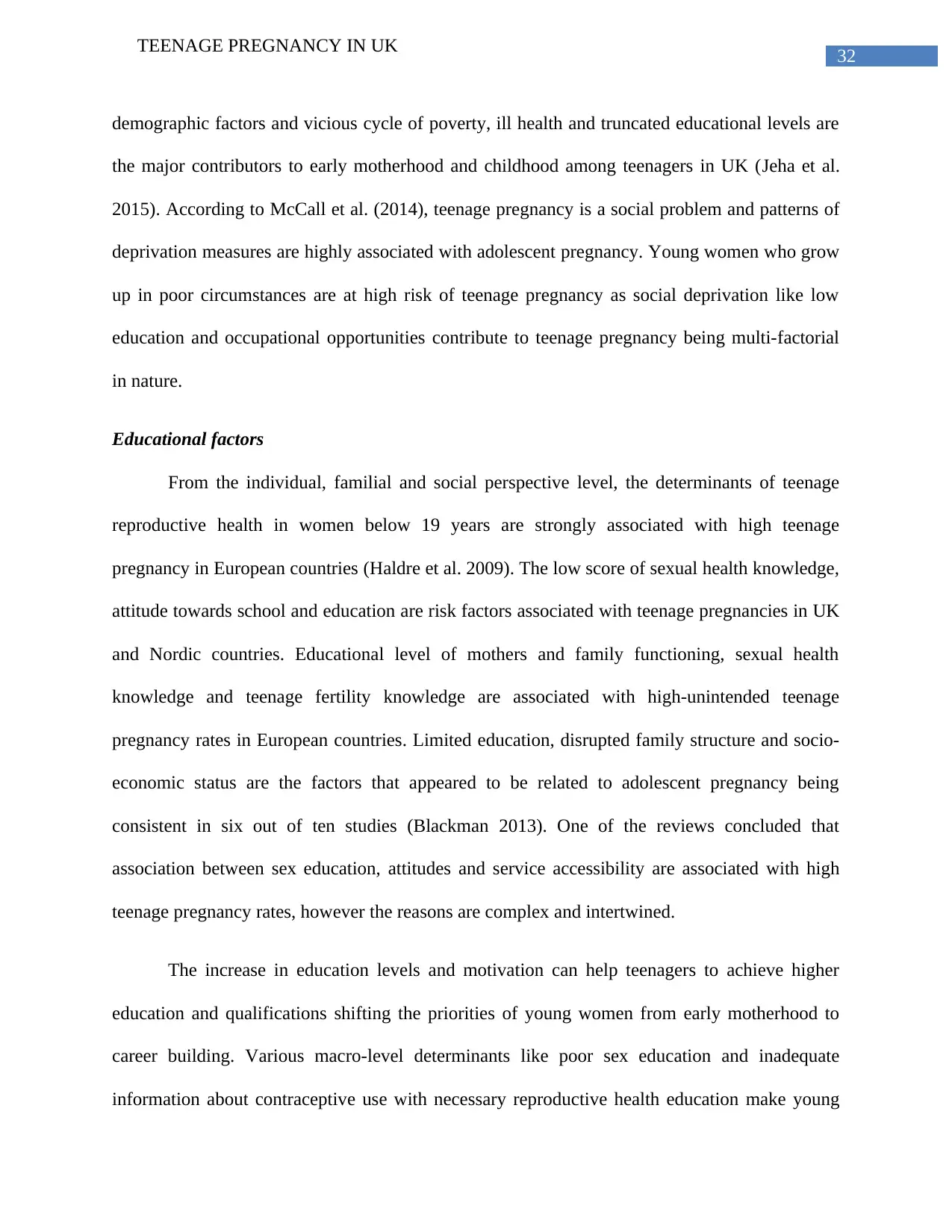
TEENAGE PREGNANCY IN UK
demographic factors and vicious cycle of poverty, ill health and truncated educational levels are
the major contributors to early motherhood and childhood among teenagers in UK (Jeha et al.
2015). According to McCall et al. (2014), teenage pregnancy is a social problem and patterns of
deprivation measures are highly associated with adolescent pregnancy. Young women who grow
up in poor circumstances are at high risk of teenage pregnancy as social deprivation like low
education and occupational opportunities contribute to teenage pregnancy being multi-factorial
in nature.
Educational factors
From the individual, familial and social perspective level, the determinants of teenage
reproductive health in women below 19 years are strongly associated with high teenage
pregnancy in European countries (Haldre et al. 2009). The low score of sexual health knowledge,
attitude towards school and education are risk factors associated with teenage pregnancies in UK
and Nordic countries. Educational level of mothers and family functioning, sexual health
knowledge and teenage fertility knowledge are associated with high-unintended teenage
pregnancy rates in European countries. Limited education, disrupted family structure and socio-
economic status are the factors that appeared to be related to adolescent pregnancy being
consistent in six out of ten studies (Blackman 2013). One of the reviews concluded that
association between sex education, attitudes and service accessibility are associated with high
teenage pregnancy rates, however the reasons are complex and intertwined.
The increase in education levels and motivation can help teenagers to achieve higher
education and qualifications shifting the priorities of young women from early motherhood to
career building. Various macro-level determinants like poor sex education and inadequate
information about contraceptive use with necessary reproductive health education make young
⊘ This is a preview!⊘
Do you want full access?
Subscribe today to unlock all pages.

Trusted by 1+ million students worldwide
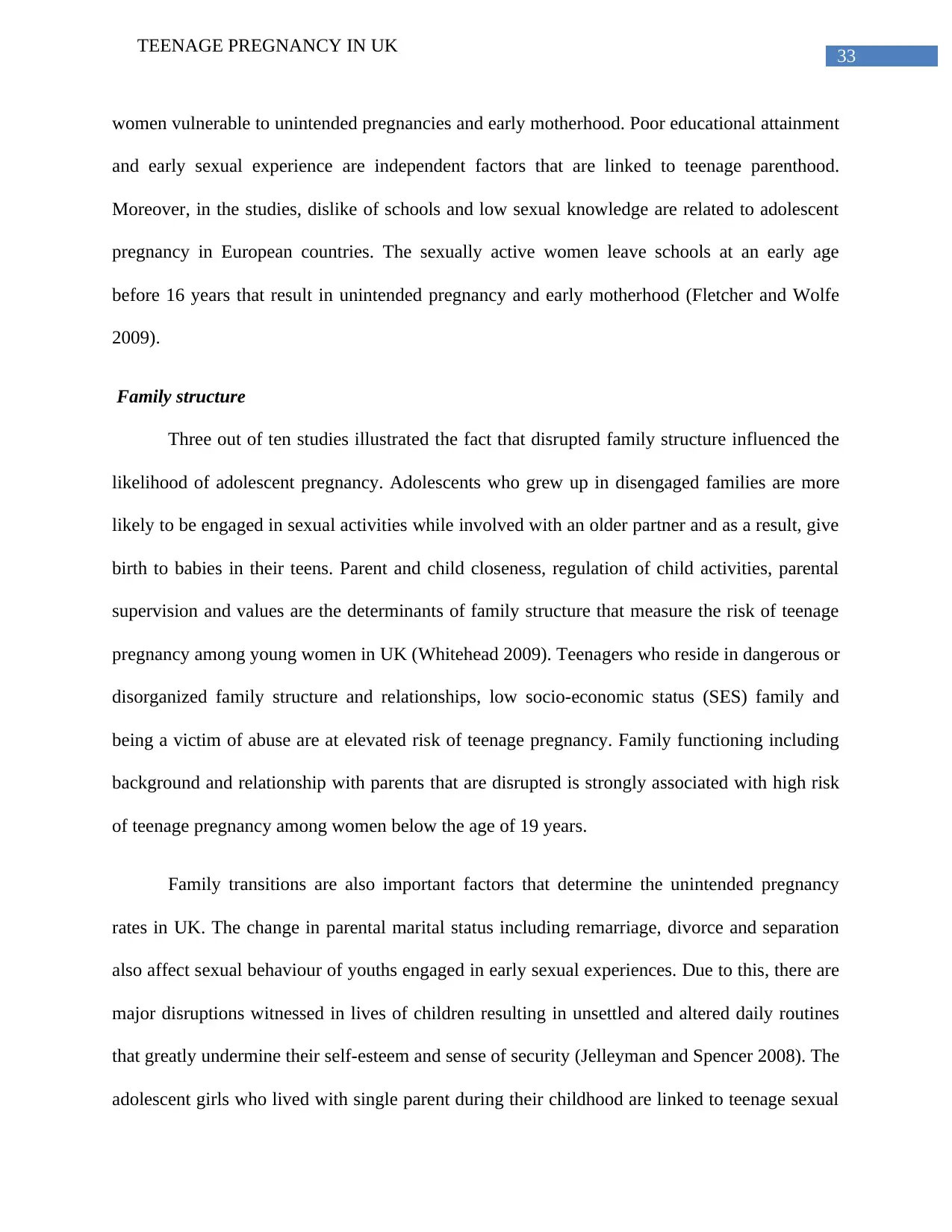
TEENAGE PREGNANCY IN UK
women vulnerable to unintended pregnancies and early motherhood. Poor educational attainment
and early sexual experience are independent factors that are linked to teenage parenthood.
Moreover, in the studies, dislike of schools and low sexual knowledge are related to adolescent
pregnancy in European countries. The sexually active women leave schools at an early age
before 16 years that result in unintended pregnancy and early motherhood (Fletcher and Wolfe
2009).
Family structure
Three out of ten studies illustrated the fact that disrupted family structure influenced the
likelihood of adolescent pregnancy. Adolescents who grew up in disengaged families are more
likely to be engaged in sexual activities while involved with an older partner and as a result, give
birth to babies in their teens. Parent and child closeness, regulation of child activities, parental
supervision and values are the determinants of family structure that measure the risk of teenage
pregnancy among young women in UK (Whitehead 2009). Teenagers who reside in dangerous or
disorganized family structure and relationships, low socio-economic status (SES) family and
being a victim of abuse are at elevated risk of teenage pregnancy. Family functioning including
background and relationship with parents that are disrupted is strongly associated with high risk
of teenage pregnancy among women below the age of 19 years.
Family transitions are also important factors that determine the unintended pregnancy
rates in UK. The change in parental marital status including remarriage, divorce and separation
also affect sexual behaviour of youths engaged in early sexual experiences. Due to this, there are
major disruptions witnessed in lives of children resulting in unsettled and altered daily routines
that greatly undermine their self-esteem and sense of security (Jelleyman and Spencer 2008). The
adolescent girls who lived with single parent during their childhood are linked to teenage sexual
Paraphrase This Document

TEENAGE PREGNANCY IN UK
activity and risk of adolescent pregnancy. Moreover, unstable family structure greatly influences
the choices of young women towards childbearing and parenting. There are negative
consequences for the young women that include early intercourse resulting in high teenage
pregnancies rates among age groups 12-19 years.
Reproductive health knowledge, behaviour and attitude
The variations in sexual health knowledge and behaviour of young people greatly
influence their attitude towards sex. Adolescent information and access to reproductive health is
important for their physical, social and emotional well-being. The lack of knowledge about these
aspects have severe consequences of unprotected sex among teenagers predisposing them
towards unintended pregnancies, unsafe abortion, sexually transmitted diseases and related
complications (Coleman and Testa 2008). Reproductive knowledge that encompasses
information regarding abstinence, contraceptive use, decision to continue pregnancy and use of
safe abortion options are useful for adolescents to make healthy decisions for themselves and
their families. The lack of knowledge about sexual health among the teenagers makes them be
easily influenced and misguided that is harmful to their reproductive health.
Health education plays a crucial role in increasing information and behaviour of
teenagers towards attitudes to sex. This helps in maintaining good reproductive health having an
impact on their behaviour and attitude towards early sexual experiences. Moreover, reproductive
health knowledge helps to protect teenagers from getting pregnant through contraceptive use and
abstinence. Inaccurate beliefs regarding attitudes to sex and high-risk behaviours predispose
teenagers to unwanted pregnancies and early motherhood. Inaccurate information perceived by
young people regarding reproductive health has potential consequences on their behaviours.
Appropriate knowledge about reproductive health helps teenagers to make informed decisions
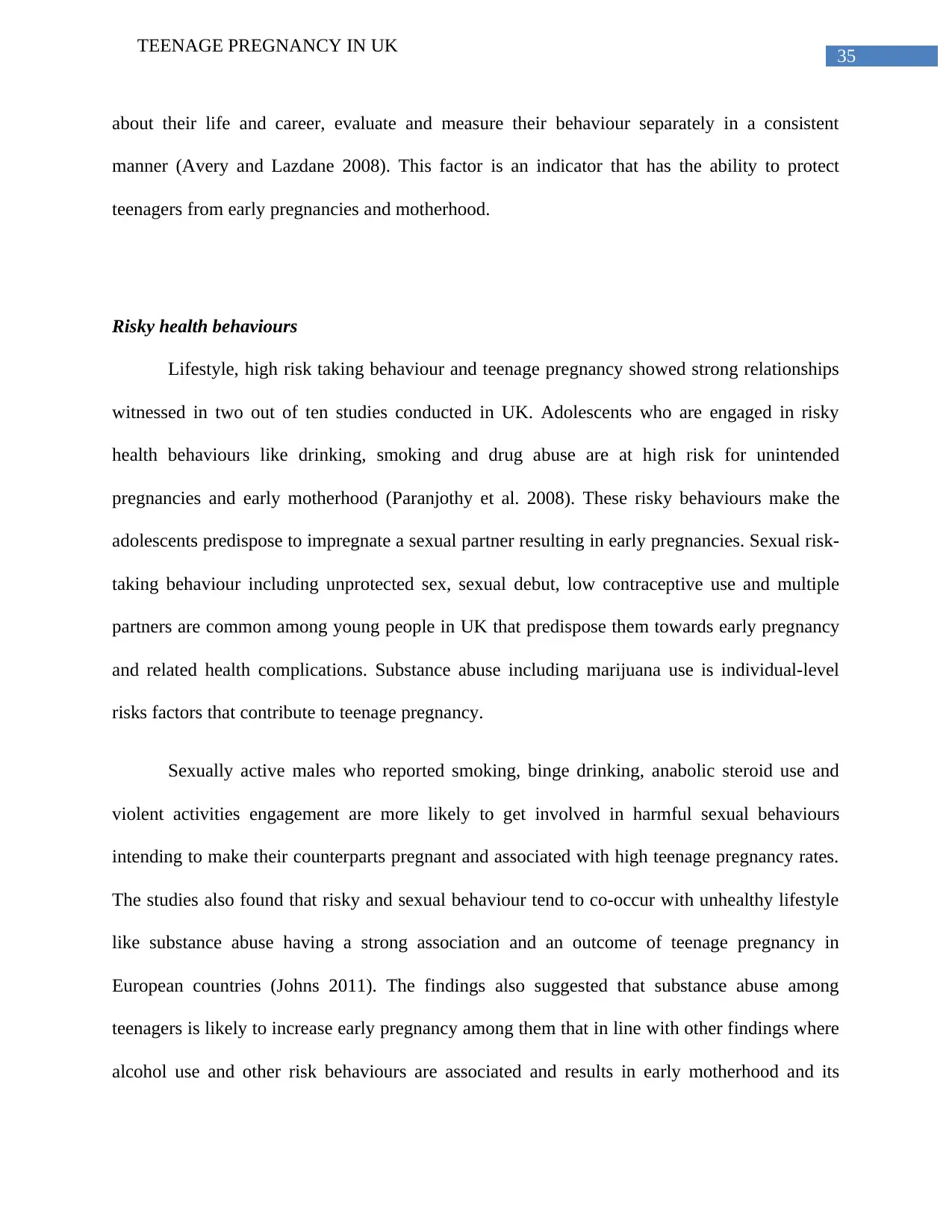
TEENAGE PREGNANCY IN UK
about their life and career, evaluate and measure their behaviour separately in a consistent
manner (Avery and Lazdane 2008). This factor is an indicator that has the ability to protect
teenagers from early pregnancies and motherhood.
Risky health behaviours
Lifestyle, high risk taking behaviour and teenage pregnancy showed strong relationships
witnessed in two out of ten studies conducted in UK. Adolescents who are engaged in risky
health behaviours like drinking, smoking and drug abuse are at high risk for unintended
pregnancies and early motherhood (Paranjothy et al. 2008). These risky behaviours make the
adolescents predispose to impregnate a sexual partner resulting in early pregnancies. Sexual risk-
taking behaviour including unprotected sex, sexual debut, low contraceptive use and multiple
partners are common among young people in UK that predispose them towards early pregnancy
and related health complications. Substance abuse including marijuana use is individual-level
risks factors that contribute to teenage pregnancy.
Sexually active males who reported smoking, binge drinking, anabolic steroid use and
violent activities engagement are more likely to get involved in harmful sexual behaviours
intending to make their counterparts pregnant and associated with high teenage pregnancy rates.
The studies also found that risky and sexual behaviour tend to co-occur with unhealthy lifestyle
like substance abuse having a strong association and an outcome of teenage pregnancy in
European countries (Johns 2011). The findings also suggested that substance abuse among
teenagers is likely to increase early pregnancy among them that in line with other findings where
alcohol use and other risk behaviours are associated and results in early motherhood and its
⊘ This is a preview!⊘
Do you want full access?
Subscribe today to unlock all pages.

Trusted by 1+ million students worldwide
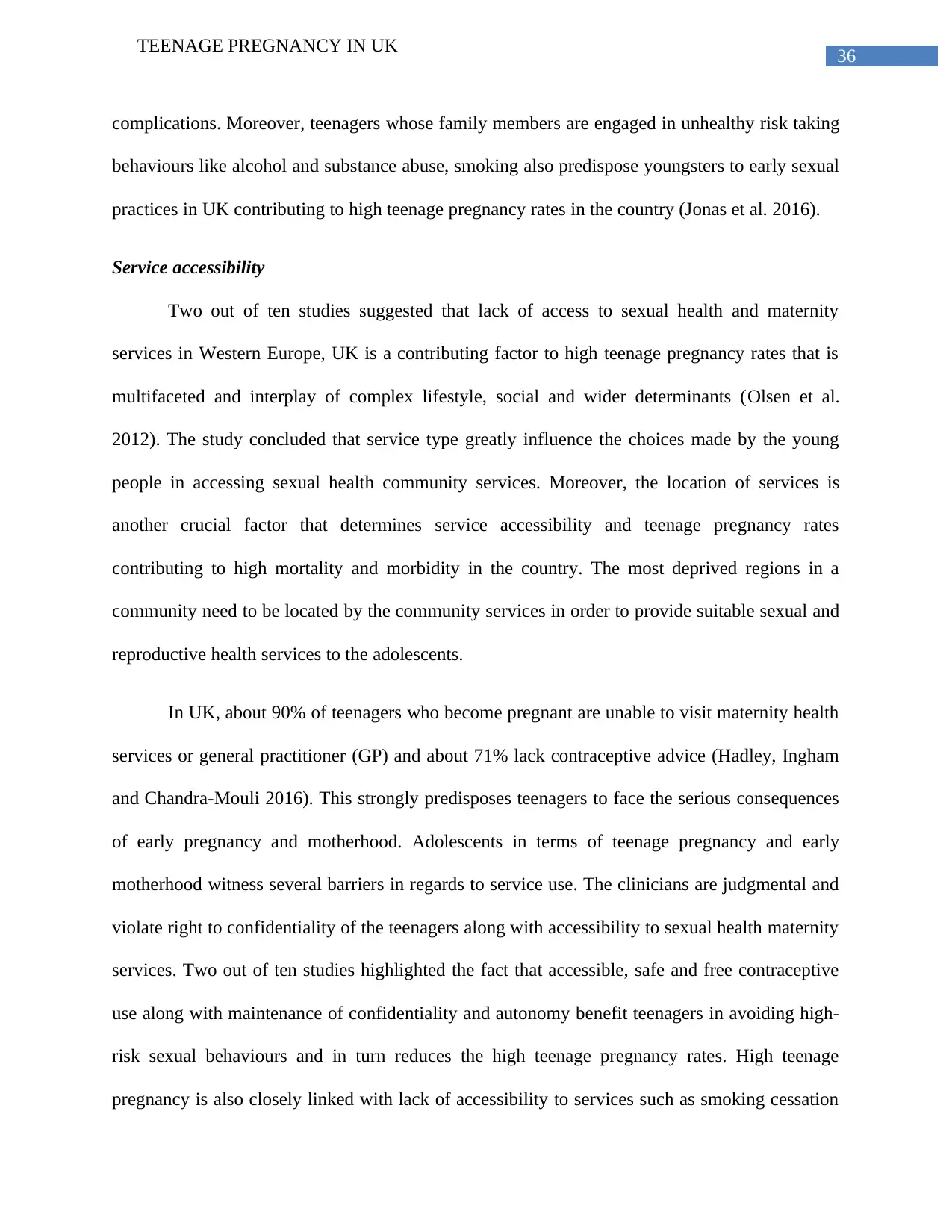
TEENAGE PREGNANCY IN UK
complications. Moreover, teenagers whose family members are engaged in unhealthy risk taking
behaviours like alcohol and substance abuse, smoking also predispose youngsters to early sexual
practices in UK contributing to high teenage pregnancy rates in the country (Jonas et al. 2016).
Service accessibility
Two out of ten studies suggested that lack of access to sexual health and maternity
services in Western Europe, UK is a contributing factor to high teenage pregnancy rates that is
multifaceted and interplay of complex lifestyle, social and wider determinants (Olsen et al.
2012). The study concluded that service type greatly influence the choices made by the young
people in accessing sexual health community services. Moreover, the location of services is
another crucial factor that determines service accessibility and teenage pregnancy rates
contributing to high mortality and morbidity in the country. The most deprived regions in a
community need to be located by the community services in order to provide suitable sexual and
reproductive health services to the adolescents.
In UK, about 90% of teenagers who become pregnant are unable to visit maternity health
services or general practitioner (GP) and about 71% lack contraceptive advice (Hadley, Ingham
and Chandra-Mouli 2016). This strongly predisposes teenagers to face the serious consequences
of early pregnancy and motherhood. Adolescents in terms of teenage pregnancy and early
motherhood witness several barriers in regards to service use. The clinicians are judgmental and
violate right to confidentiality of the teenagers along with accessibility to sexual health maternity
services. Two out of ten studies highlighted the fact that accessible, safe and free contraceptive
use along with maintenance of confidentiality and autonomy benefit teenagers in avoiding high-
risk sexual behaviours and in turn reduces the high teenage pregnancy rates. High teenage
pregnancy is also closely linked with lack of accessibility to services such as smoking cessation
Paraphrase This Document
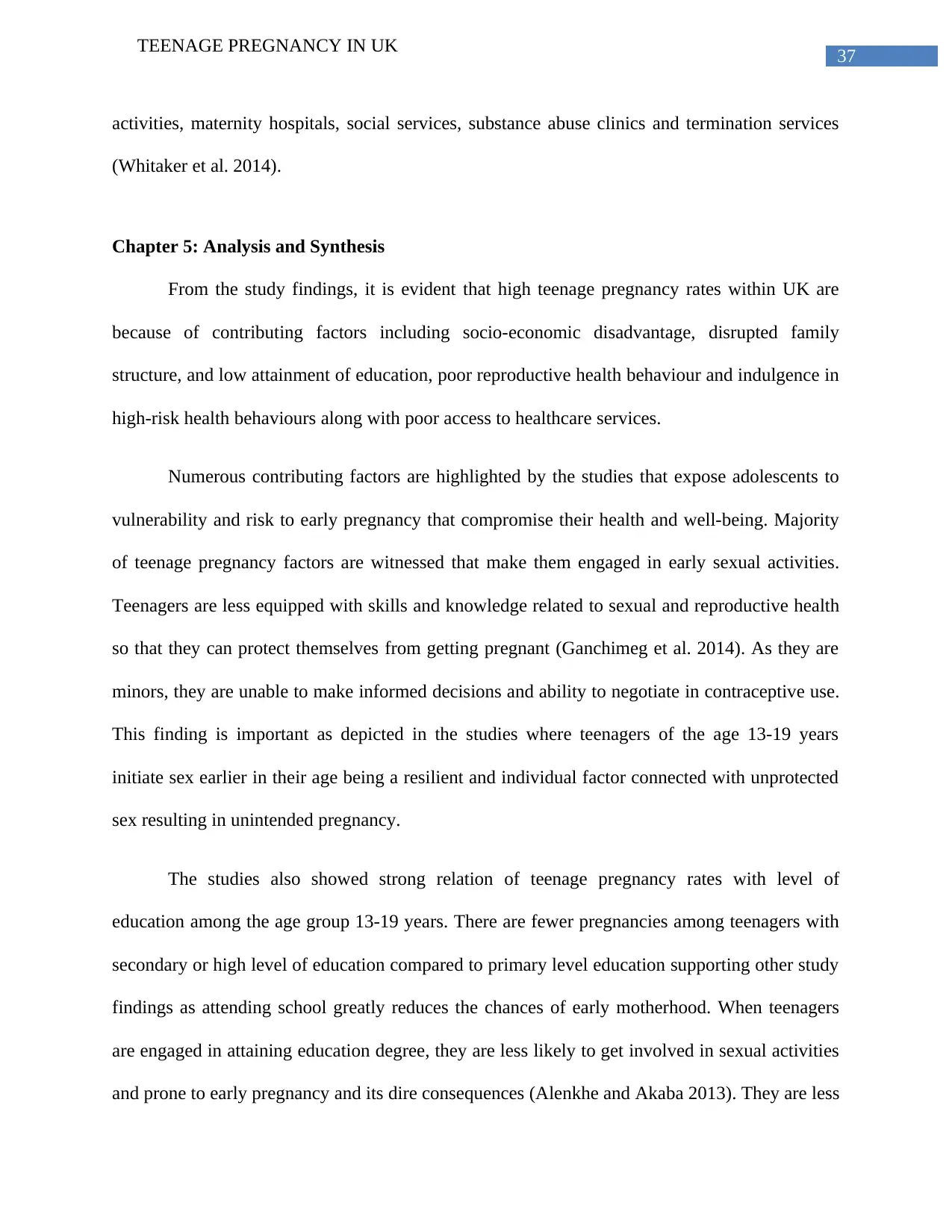
TEENAGE PREGNANCY IN UK
activities, maternity hospitals, social services, substance abuse clinics and termination services
(Whitaker et al. 2014).
Chapter 5: Analysis and Synthesis
From the study findings, it is evident that high teenage pregnancy rates within UK are
because of contributing factors including socio-economic disadvantage, disrupted family
structure, and low attainment of education, poor reproductive health behaviour and indulgence in
high-risk health behaviours along with poor access to healthcare services.
Numerous contributing factors are highlighted by the studies that expose adolescents to
vulnerability and risk to early pregnancy that compromise their health and well-being. Majority
of teenage pregnancy factors are witnessed that make them engaged in early sexual activities.
Teenagers are less equipped with skills and knowledge related to sexual and reproductive health
so that they can protect themselves from getting pregnant (Ganchimeg et al. 2014). As they are
minors, they are unable to make informed decisions and ability to negotiate in contraceptive use.
This finding is important as depicted in the studies where teenagers of the age 13-19 years
initiate sex earlier in their age being a resilient and individual factor connected with unprotected
sex resulting in unintended pregnancy.
The studies also showed strong relation of teenage pregnancy rates with level of
education among the age group 13-19 years. There are fewer pregnancies among teenagers with
secondary or high level of education compared to primary level education supporting other study
findings as attending school greatly reduces the chances of early motherhood. When teenagers
are engaged in attaining education degree, they are less likely to get involved in sexual activities
and prone to early pregnancy and its dire consequences (Alenkhe and Akaba 2013). They are less
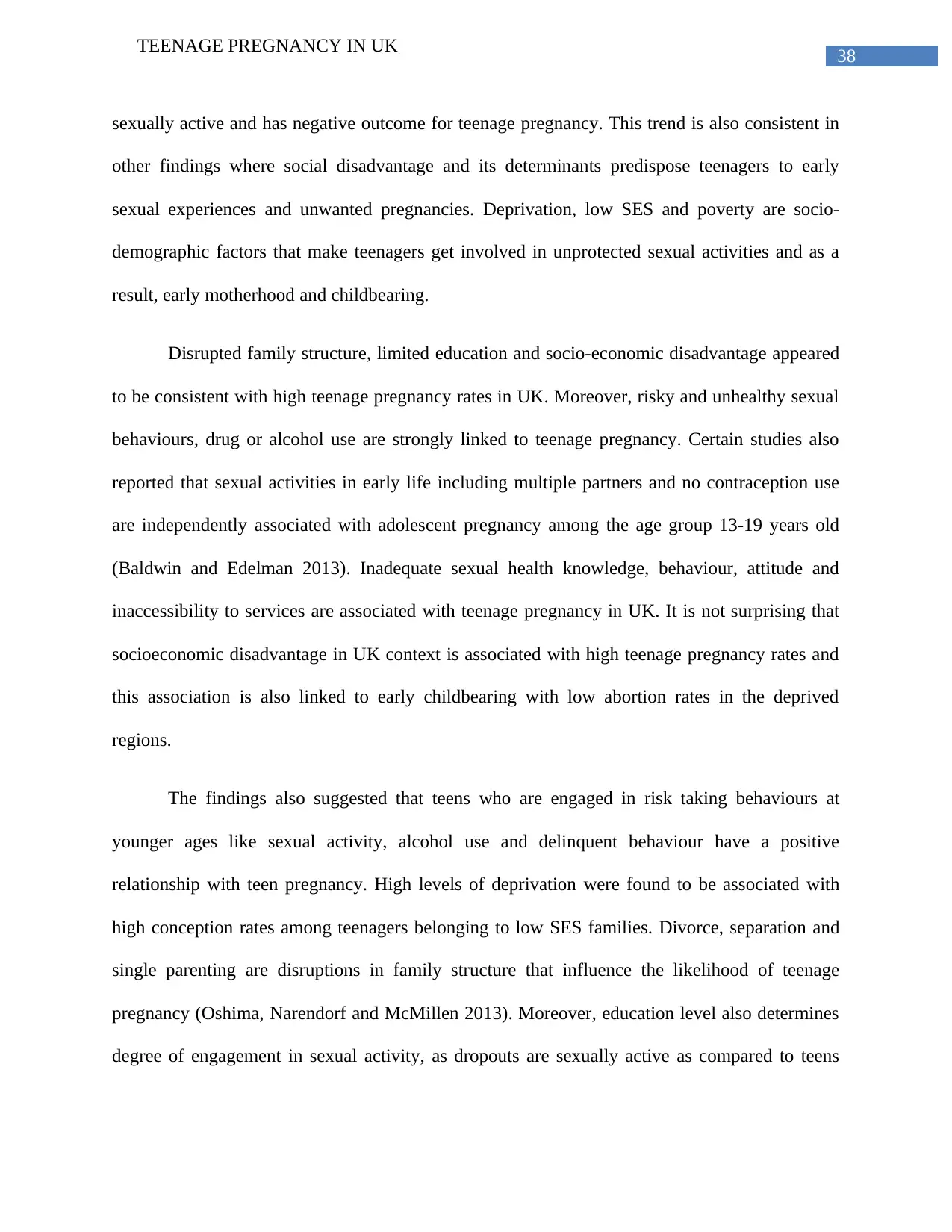
TEENAGE PREGNANCY IN UK
sexually active and has negative outcome for teenage pregnancy. This trend is also consistent in
other findings where social disadvantage and its determinants predispose teenagers to early
sexual experiences and unwanted pregnancies. Deprivation, low SES and poverty are socio-
demographic factors that make teenagers get involved in unprotected sexual activities and as a
result, early motherhood and childbearing.
Disrupted family structure, limited education and socio-economic disadvantage appeared
to be consistent with high teenage pregnancy rates in UK. Moreover, risky and unhealthy sexual
behaviours, drug or alcohol use are strongly linked to teenage pregnancy. Certain studies also
reported that sexual activities in early life including multiple partners and no contraception use
are independently associated with adolescent pregnancy among the age group 13-19 years old
(Baldwin and Edelman 2013). Inadequate sexual health knowledge, behaviour, attitude and
inaccessibility to services are associated with teenage pregnancy in UK. It is not surprising that
socioeconomic disadvantage in UK context is associated with high teenage pregnancy rates and
this association is also linked to early childbearing with low abortion rates in the deprived
regions.
The findings also suggested that teens who are engaged in risk taking behaviours at
younger ages like sexual activity, alcohol use and delinquent behaviour have a positive
relationship with teen pregnancy. High levels of deprivation were found to be associated with
high conception rates among teenagers belonging to low SES families. Divorce, separation and
single parenting are disruptions in family structure that influence the likelihood of teenage
pregnancy (Oshima, Narendorf and McMillen 2013). Moreover, education level also determines
degree of engagement in sexual activity, as dropouts are sexually active as compared to teens
⊘ This is a preview!⊘
Do you want full access?
Subscribe today to unlock all pages.

Trusted by 1+ million students worldwide

TEENAGE PREGNANCY IN UK
that attain regular schooling (Stanger-Hall and Hall 2011). Teens that disliked schools of the age
below 19 years are more likely to get pregnant as compared to teens who liked school.
The gap in sexual and reproductive health knowledge that teenagers experience make
them subjected to risky sexual activities with untimely emergency contraception and poor access
to sexual health and termination services. Early sexual competence is associated with high
pregnancy rates among the females of the age 12-19 years. Contraceptive failure and inability to
convince partners to use condoms make them a victim of sexual offence resulting in making the
young females become pregnant (Frost, Lindberg and Finer 2012).
Young women experience obstacles and face barriers in accessing reproductive health
and abortions services. Moreover, the judgmental approach that GPs and clinicians pursue
towards them hinder in seeking any health services (Liran et al. 2013). This greatly threatens
their confidentiality and violation of right to privacy. Age-appropriate sex education is also not
provided to them in school that hinder their access to use of contraception results in high-
unwanted pregnancies among them. They are unable to access information that can help in
preventing unwanted pregnancies, its related complications and avoid sexually transmitted
diseases. Sexual and abstinence education programs are not provided to the teens so that
pregnancy can be avoided at an early age.
Socio-demographic factors in association with early onset of puberty, lack of education
on reproductive health and contraception use and high sexual activity have negative outcomes
like teenage pregnancy and health-related complications (Nessa et al. 2014). In addition, lack of
awareness, low SES condition, disrupted family structure, illiteracy, low education attainment,
poor accessibility of services, involvement in risky behaviours, poor access and delay in seeking
Paraphrase This Document
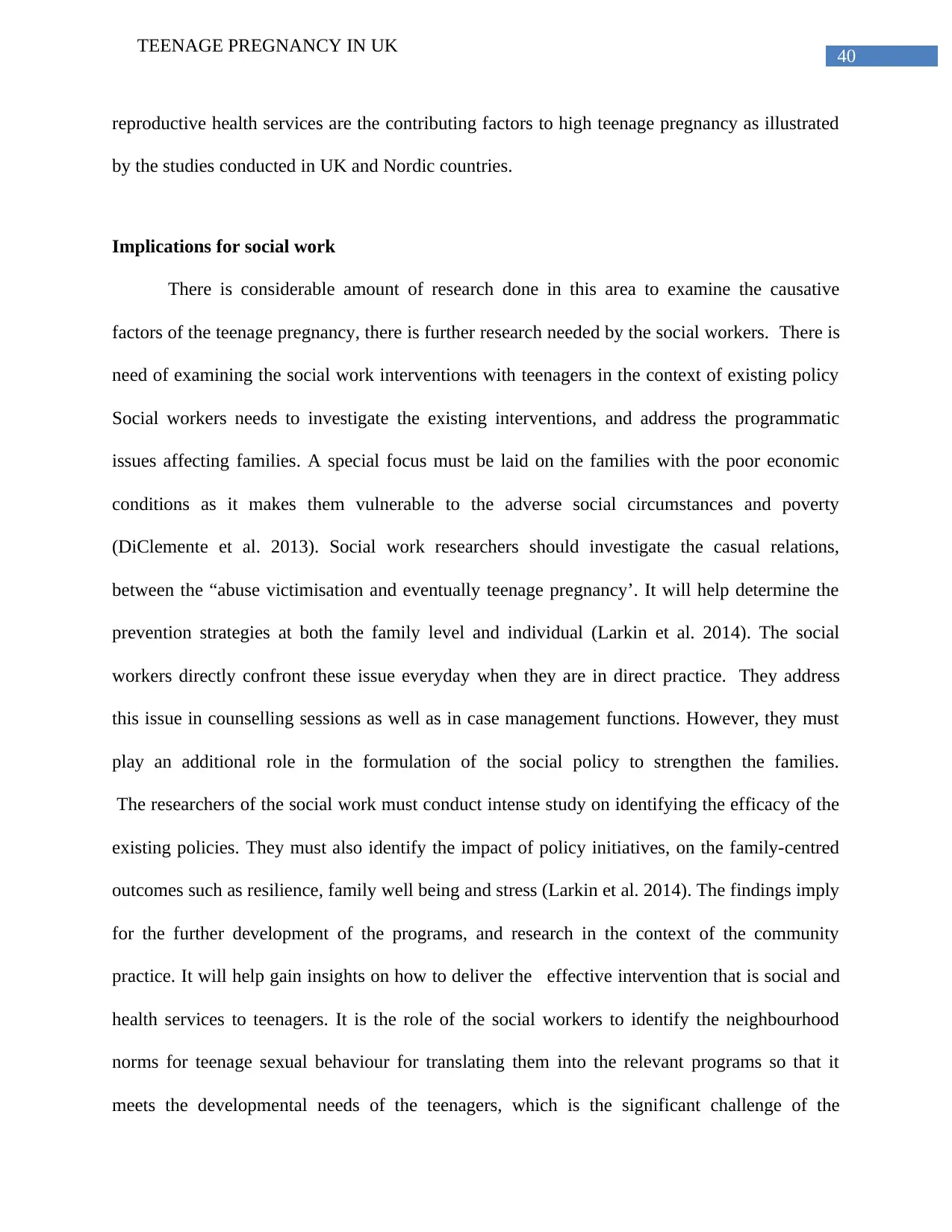
TEENAGE PREGNANCY IN UK
reproductive health services are the contributing factors to high teenage pregnancy as illustrated
by the studies conducted in UK and Nordic countries.
Implications for social work
There is considerable amount of research done in this area to examine the causative
factors of the teenage pregnancy, there is further research needed by the social workers. There is
need of examining the social work interventions with teenagers in the context of existing policy
Social workers needs to investigate the existing interventions, and address the programmatic
issues affecting families. A special focus must be laid on the families with the poor economic
conditions as it makes them vulnerable to the adverse social circumstances and poverty
(DiClemente et al. 2013). Social work researchers should investigate the casual relations,
between the “abuse victimisation and eventually teenage pregnancy’. It will help determine the
prevention strategies at both the family level and individual (Larkin et al. 2014). The social
workers directly confront these issue everyday when they are in direct practice. They address
this issue in counselling sessions as well as in case management functions. However, they must
play an additional role in the formulation of the social policy to strengthen the families.
The researchers of the social work must conduct intense study on identifying the efficacy of the
existing policies. They must also identify the impact of policy initiatives, on the family-centred
outcomes such as resilience, family well being and stress (Larkin et al. 2014). The findings imply
for the further development of the programs, and research in the context of the community
practice. It will help gain insights on how to deliver the effective intervention that is social and
health services to teenagers. It is the role of the social workers to identify the neighbourhood
norms for teenage sexual behaviour for translating them into the relevant programs so that it
meets the developmental needs of the teenagers, which is the significant challenge of the
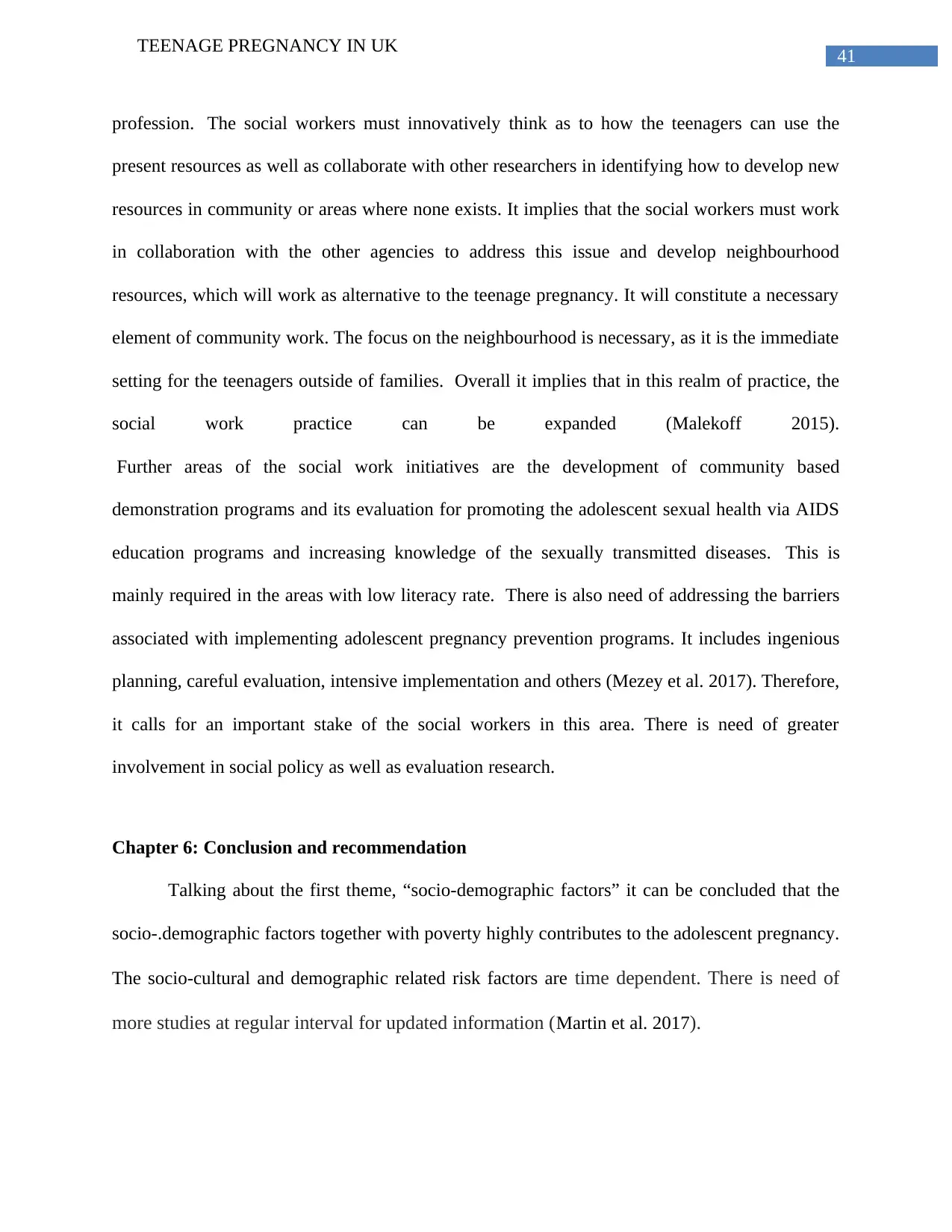
TEENAGE PREGNANCY IN UK
profession. The social workers must innovatively think as to how the teenagers can use the
present resources as well as collaborate with other researchers in identifying how to develop new
resources in community or areas where none exists. It implies that the social workers must work
in collaboration with the other agencies to address this issue and develop neighbourhood
resources, which will work as alternative to the teenage pregnancy. It will constitute a necessary
element of community work. The focus on the neighbourhood is necessary, as it is the immediate
setting for the teenagers outside of families. Overall it implies that in this realm of practice, the
social work practice can be expanded (Malekoff 2015).
Further areas of the social work initiatives are the development of community based
demonstration programs and its evaluation for promoting the adolescent sexual health via AIDS
education programs and increasing knowledge of the sexually transmitted diseases. This is
mainly required in the areas with low literacy rate. There is also need of addressing the barriers
associated with implementing adolescent pregnancy prevention programs. It includes ingenious
planning, careful evaluation, intensive implementation and others (Mezey et al. 2017). Therefore,
it calls for an important stake of the social workers in this area. There is need of greater
involvement in social policy as well as evaluation research.
Chapter 6: Conclusion and recommendation
Talking about the first theme, “socio-demographic factors” it can be concluded that the
socio-.demographic factors together with poverty highly contributes to the adolescent pregnancy.
The socio-cultural and demographic related risk factors are time dependent. There is need of
more studies at regular interval for updated information (Martin et al. 2017).
⊘ This is a preview!⊘
Do you want full access?
Subscribe today to unlock all pages.

Trusted by 1+ million students worldwide
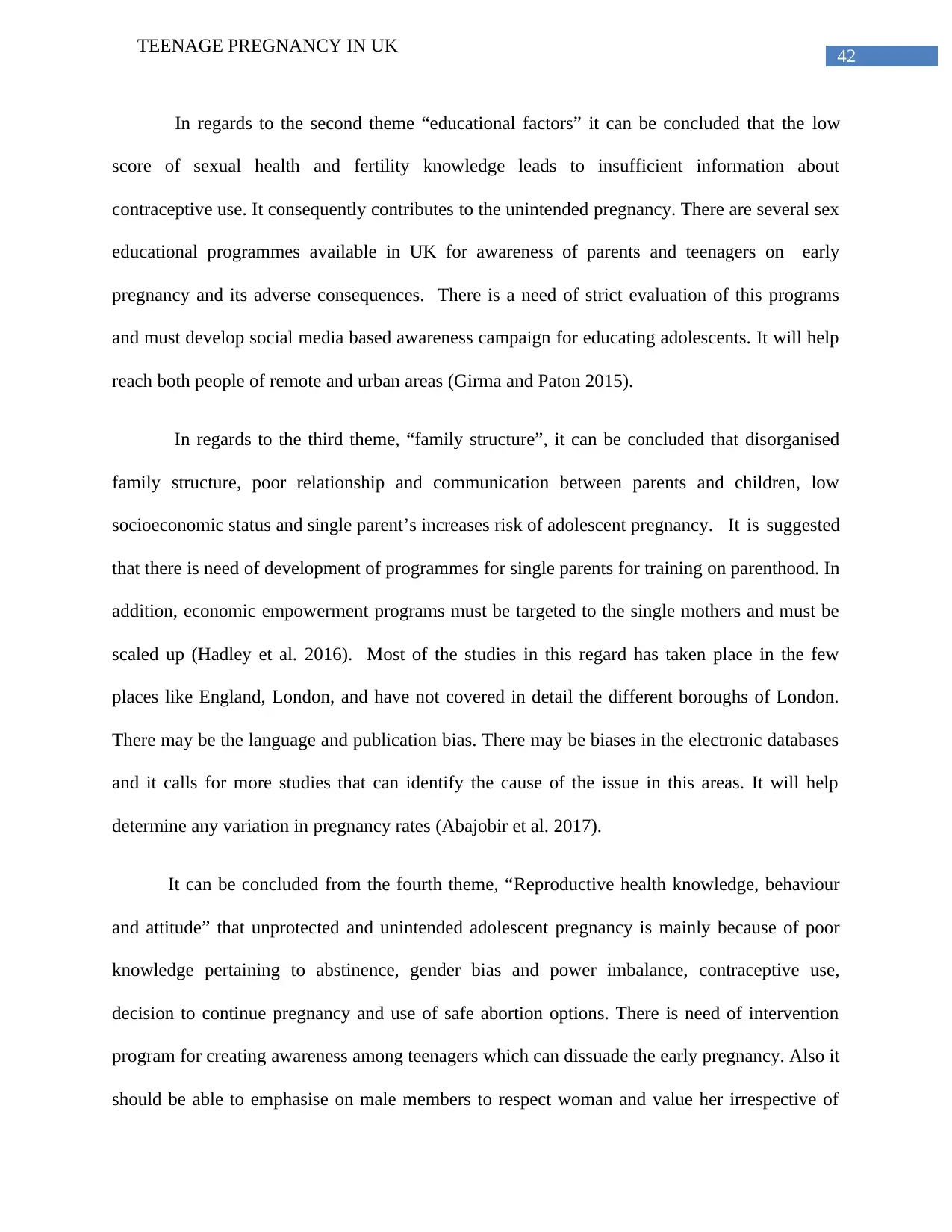
TEENAGE PREGNANCY IN UK
In regards to the second theme “educational factors” it can be concluded that the low
score of sexual health and fertility knowledge leads to insufficient information about
contraceptive use. It consequently contributes to the unintended pregnancy. There are several sex
educational programmes available in UK for awareness of parents and teenagers on early
pregnancy and its adverse consequences. There is a need of strict evaluation of this programs
and must develop social media based awareness campaign for educating adolescents. It will help
reach both people of remote and urban areas (Girma and Paton 2015).
In regards to the third theme, “family structure”, it can be concluded that disorganised
family structure, poor relationship and communication between parents and children, low
socioeconomic status and single parent’s increases risk of adolescent pregnancy. It is suggested
that there is need of development of programmes for single parents for training on parenthood. In
addition, economic empowerment programs must be targeted to the single mothers and must be
scaled up (Hadley et al. 2016). Most of the studies in this regard has taken place in the few
places like England, London, and have not covered in detail the different boroughs of London.
There may be the language and publication bias. There may be biases in the electronic databases
and it calls for more studies that can identify the cause of the issue in this areas. It will help
determine any variation in pregnancy rates (Abajobir et al. 2017).
It can be concluded from the fourth theme, “Reproductive health knowledge, behaviour
and attitude” that unprotected and unintended adolescent pregnancy is mainly because of poor
knowledge pertaining to abstinence, gender bias and power imbalance, contraceptive use,
decision to continue pregnancy and use of safe abortion options. There is need of intervention
program for creating awareness among teenagers which can dissuade the early pregnancy. Also it
should be able to emphasise on male members to respect woman and value her irrespective of
Paraphrase This Document
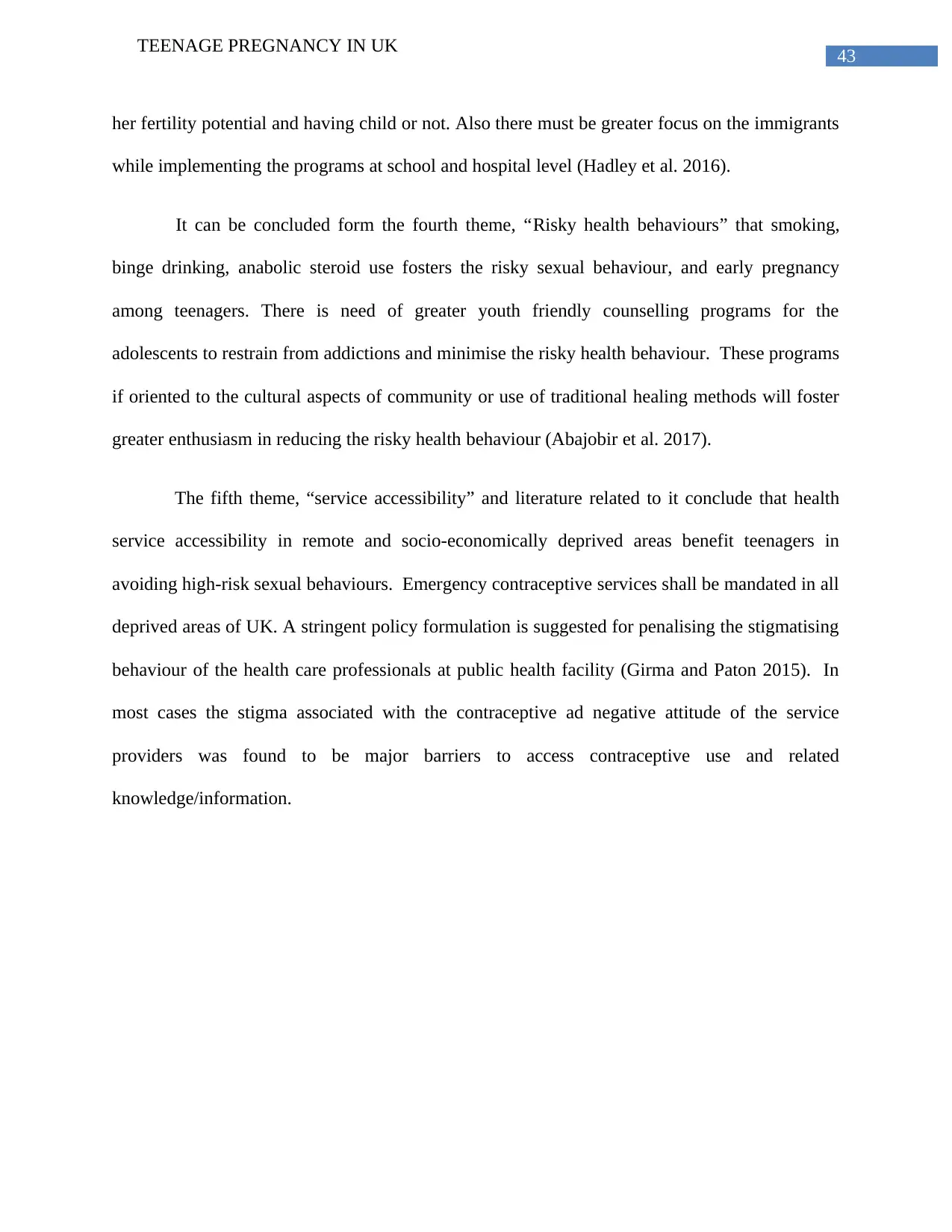
TEENAGE PREGNANCY IN UK
her fertility potential and having child or not. Also there must be greater focus on the immigrants
while implementing the programs at school and hospital level (Hadley et al. 2016).
It can be concluded form the fourth theme, “Risky health behaviours” that smoking,
binge drinking, anabolic steroid use fosters the risky sexual behaviour, and early pregnancy
among teenagers. There is need of greater youth friendly counselling programs for the
adolescents to restrain from addictions and minimise the risky health behaviour. These programs
if oriented to the cultural aspects of community or use of traditional healing methods will foster
greater enthusiasm in reducing the risky health behaviour (Abajobir et al. 2017).
The fifth theme, “service accessibility” and literature related to it conclude that health
service accessibility in remote and socio-economically deprived areas benefit teenagers in
avoiding high-risk sexual behaviours. Emergency contraceptive services shall be mandated in all
deprived areas of UK. A stringent policy formulation is suggested for penalising the stigmatising
behaviour of the health care professionals at public health facility (Girma and Paton 2015). In
most cases the stigma associated with the contraceptive ad negative attitude of the service
providers was found to be major barriers to access contraceptive use and related
knowledge/information.

TEENAGE PREGNANCY IN UK
References
Abajobir, A.A., Kisely, S., Maravilla, J.C., Williams, G. and Najman, J.M., 2017. Gender
differences in the association between childhood sexual abuse and risky sexual behaviours: A
systematic review and meta-analysis. Child abuse & neglect, 63, pp.249-260.
Alenkhe, O.A. and Akaba, J., 2013. Teenage pregnancy in Benin City: Causes and Consequences
for Future National Leaders. International Journal of Social Sciences and Humanities Review,
4(2).
Aspinall, P.J. and Hashem, F., 2010. Are our data on teenage pregnancy across ethnic groups in
England fit for the purpose of policy formulation, implementation, and monitoring?. Critical
Public Health, 20(1), pp.47-70.
Avery, L. and Lazdane, G., 2008. What do we know about sexual and reproductive health of
adolescents in Europe?. The European Journal of Contraception & Reproductive Health
Care, 13(1), pp.58-70.
Baldwin, M.K. and Edelman, A.B., 2013. The effect of long-acting reversible contraception on
rapid repeat pregnancy in adolescents: a review. Journal of adolescent health, 52(4), pp.S47-S53.
Banerjee, B., Pandey, G.K., Dutt, D., Sengupta, B., Mondal, M. and Deb, S., 2009. Teenage
pregnancy: a socially inflicted health hazard. Indian journal of community medicine: official
publication of Indian Association of Preventive & Social Medicine, 34(3), p.227.
Batchelder, A.W., Gonzalez, J.S., Palma, A., Schoenbaum, E. and Lounsbury, D.W., 2015. A
Social Ecological Model of Syndemic Risk affecting Women with and At‐Risk for HIV in
⊘ This is a preview!⊘
Do you want full access?
Subscribe today to unlock all pages.

Trusted by 1+ million students worldwide
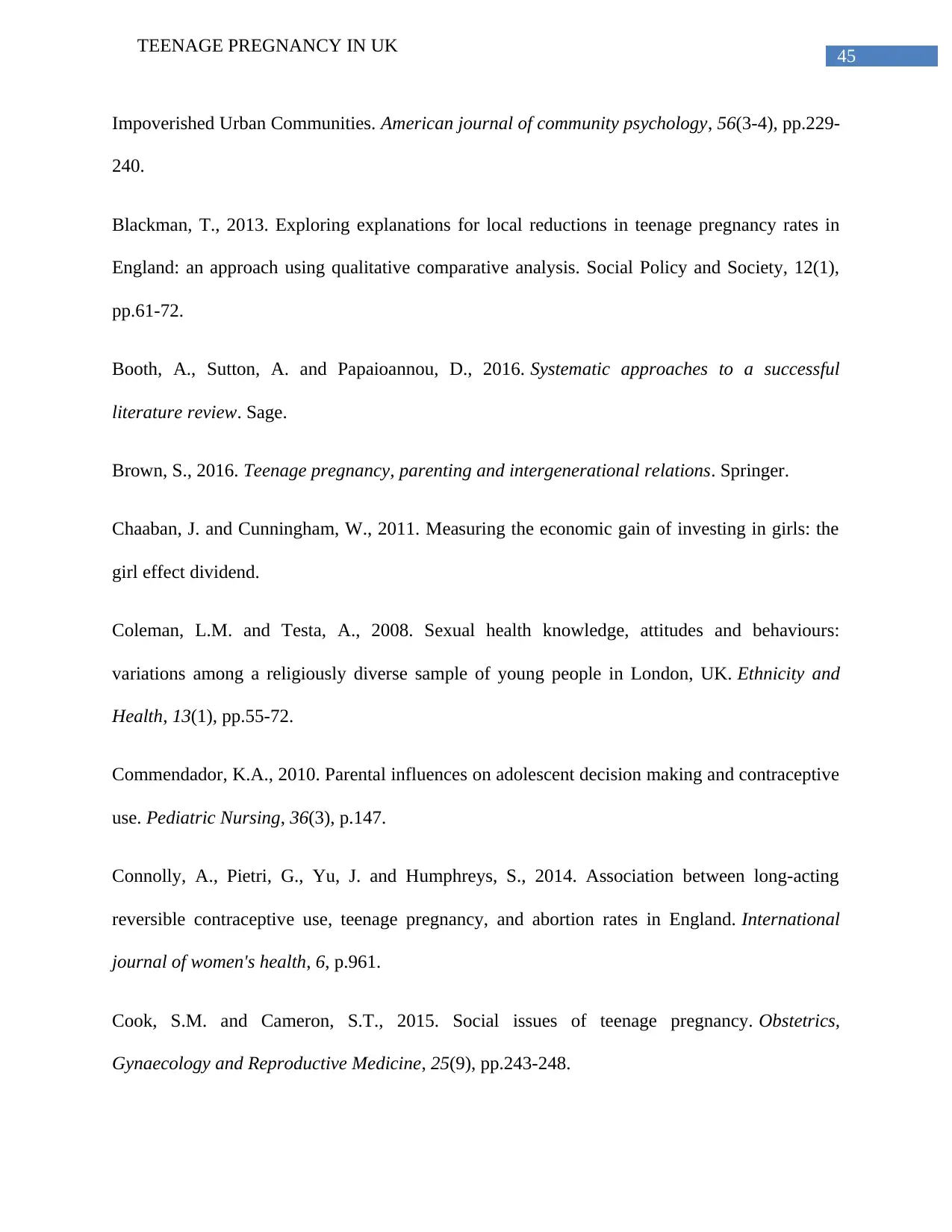
TEENAGE PREGNANCY IN UK
Impoverished Urban Communities. American journal of community psychology, 56(3-4), pp.229-
240.
Blackman, T., 2013. Exploring explanations for local reductions in teenage pregnancy rates in
England: an approach using qualitative comparative analysis. Social Policy and Society, 12(1),
pp.61-72.
Booth, A., Sutton, A. and Papaioannou, D., 2016. Systematic approaches to a successful
literature review. Sage.
Brown, S., 2016. Teenage pregnancy, parenting and intergenerational relations. Springer.
Chaaban, J. and Cunningham, W., 2011. Measuring the economic gain of investing in girls: the
girl effect dividend.
Coleman, L.M. and Testa, A., 2008. Sexual health knowledge, attitudes and behaviours:
variations among a religiously diverse sample of young people in London, UK. Ethnicity and
Health, 13(1), pp.55-72.
Commendador, K.A., 2010. Parental influences on adolescent decision making and contraceptive
use. Pediatric Nursing, 36(3), p.147.
Connolly, A., Pietri, G., Yu, J. and Humphreys, S., 2014. Association between long-acting
reversible contraceptive use, teenage pregnancy, and abortion rates in England. International
journal of women's health, 6, p.961.
Cook, S.M. and Cameron, S.T., 2015. Social issues of teenage pregnancy. Obstetrics,
Gynaecology and Reproductive Medicine, 25(9), pp.243-248.
Paraphrase This Document
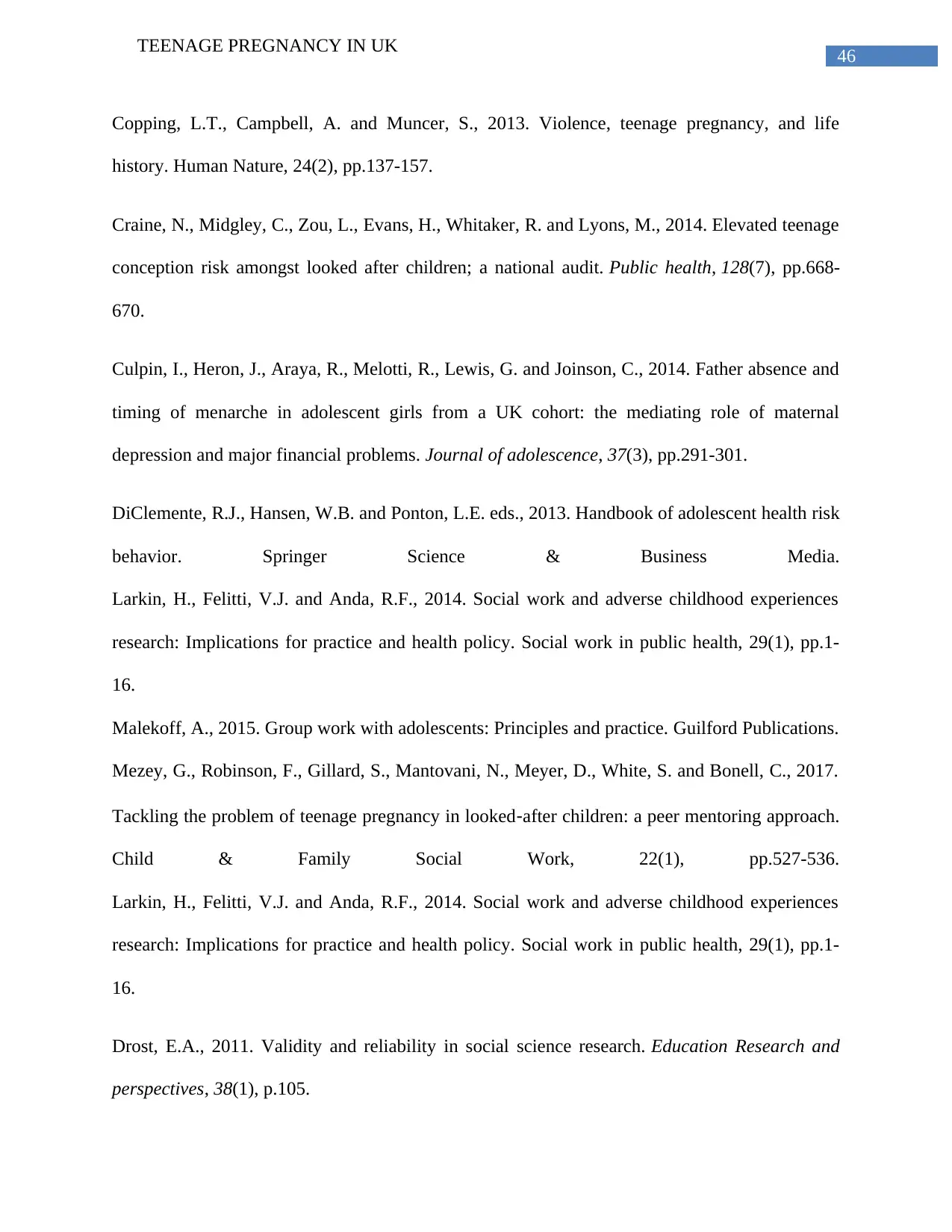
TEENAGE PREGNANCY IN UK
Copping, L.T., Campbell, A. and Muncer, S., 2013. Violence, teenage pregnancy, and life
history. Human Nature, 24(2), pp.137-157.
Craine, N., Midgley, C., Zou, L., Evans, H., Whitaker, R. and Lyons, M., 2014. Elevated teenage
conception risk amongst looked after children; a national audit. Public health, 128(7), pp.668-
670.
Culpin, I., Heron, J., Araya, R., Melotti, R., Lewis, G. and Joinson, C., 2014. Father absence and
timing of menarche in adolescent girls from a UK cohort: the mediating role of maternal
depression and major financial problems. Journal of adolescence, 37(3), pp.291-301.
DiClemente, R.J., Hansen, W.B. and Ponton, L.E. eds., 2013. Handbook of adolescent health risk
behavior. Springer Science & Business Media.
Larkin, H., Felitti, V.J. and Anda, R.F., 2014. Social work and adverse childhood experiences
research: Implications for practice and health policy. Social work in public health, 29(1), pp.1-
16.
Malekoff, A., 2015. Group work with adolescents: Principles and practice. Guilford Publications.
Mezey, G., Robinson, F., Gillard, S., Mantovani, N., Meyer, D., White, S. and Bonell, C., 2017.
Tackling the problem of teenage pregnancy in looked‐after children: a peer mentoring approach.
Child & Family Social Work, 22(1), pp.527-536.
Larkin, H., Felitti, V.J. and Anda, R.F., 2014. Social work and adverse childhood experiences
research: Implications for practice and health policy. Social work in public health, 29(1), pp.1-
16.
Drost, E.A., 2011. Validity and reliability in social science research. Education Research and
perspectives, 38(1), p.105.
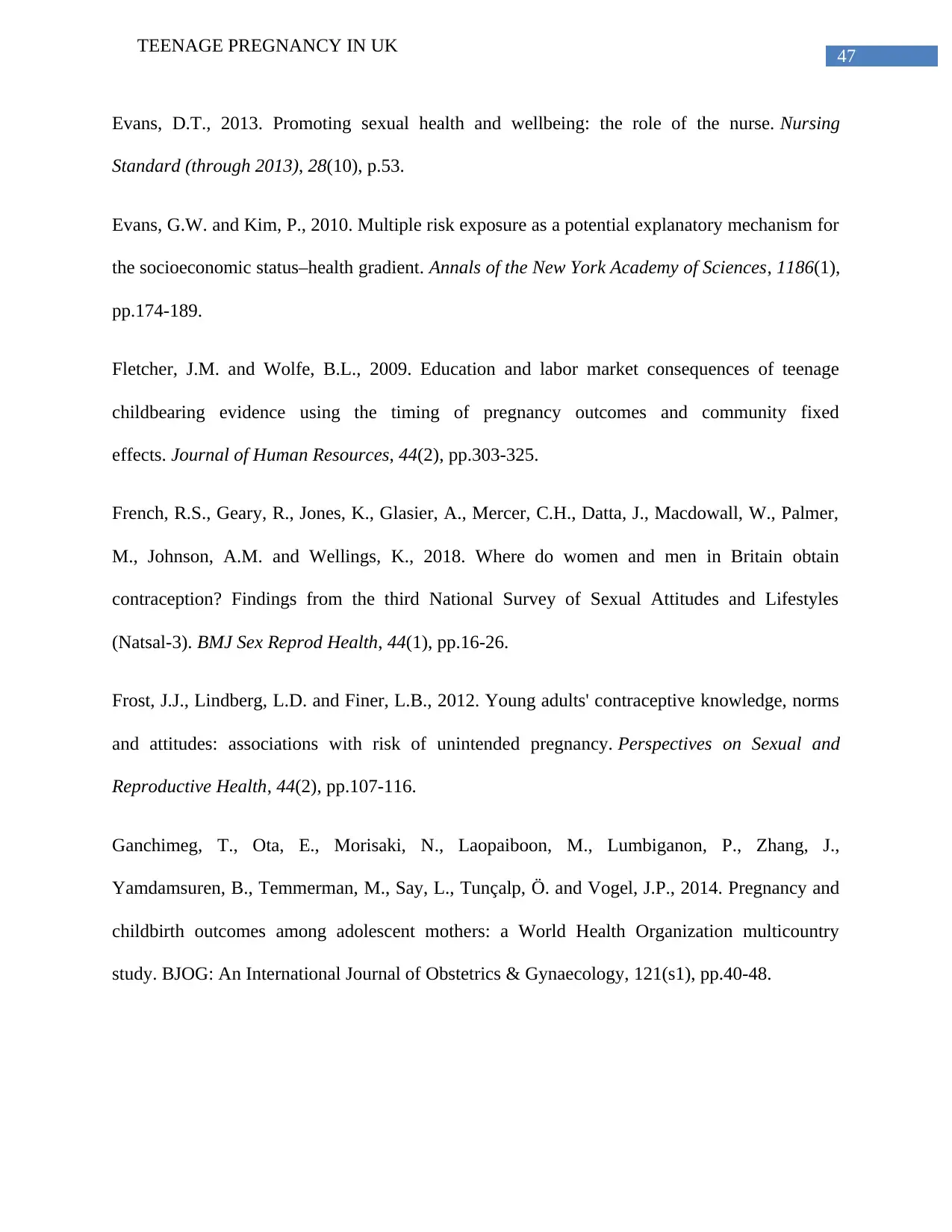
TEENAGE PREGNANCY IN UK
Evans, D.T., 2013. Promoting sexual health and wellbeing: the role of the nurse. Nursing
Standard (through 2013), 28(10), p.53.
Evans, G.W. and Kim, P., 2010. Multiple risk exposure as a potential explanatory mechanism for
the socioeconomic status–health gradient. Annals of the New York Academy of Sciences, 1186(1),
pp.174-189.
Fletcher, J.M. and Wolfe, B.L., 2009. Education and labor market consequences of teenage
childbearing evidence using the timing of pregnancy outcomes and community fixed
effects. Journal of Human Resources, 44(2), pp.303-325.
French, R.S., Geary, R., Jones, K., Glasier, A., Mercer, C.H., Datta, J., Macdowall, W., Palmer,
M., Johnson, A.M. and Wellings, K., 2018. Where do women and men in Britain obtain
contraception? Findings from the third National Survey of Sexual Attitudes and Lifestyles
(Natsal-3). BMJ Sex Reprod Health, 44(1), pp.16-26.
Frost, J.J., Lindberg, L.D. and Finer, L.B., 2012. Young adults' contraceptive knowledge, norms
and attitudes: associations with risk of unintended pregnancy. Perspectives on Sexual and
Reproductive Health, 44(2), pp.107-116.
Ganchimeg, T., Ota, E., Morisaki, N., Laopaiboon, M., Lumbiganon, P., Zhang, J.,
Yamdamsuren, B., Temmerman, M., Say, L., Tunçalp, Ö. and Vogel, J.P., 2014. Pregnancy and
childbirth outcomes among adolescent mothers: a World Health Organization multicountry
study. BJOG: An International Journal of Obstetrics & Gynaecology, 121(s1), pp.40-48.
⊘ This is a preview!⊘
Do you want full access?
Subscribe today to unlock all pages.

Trusted by 1+ million students worldwide
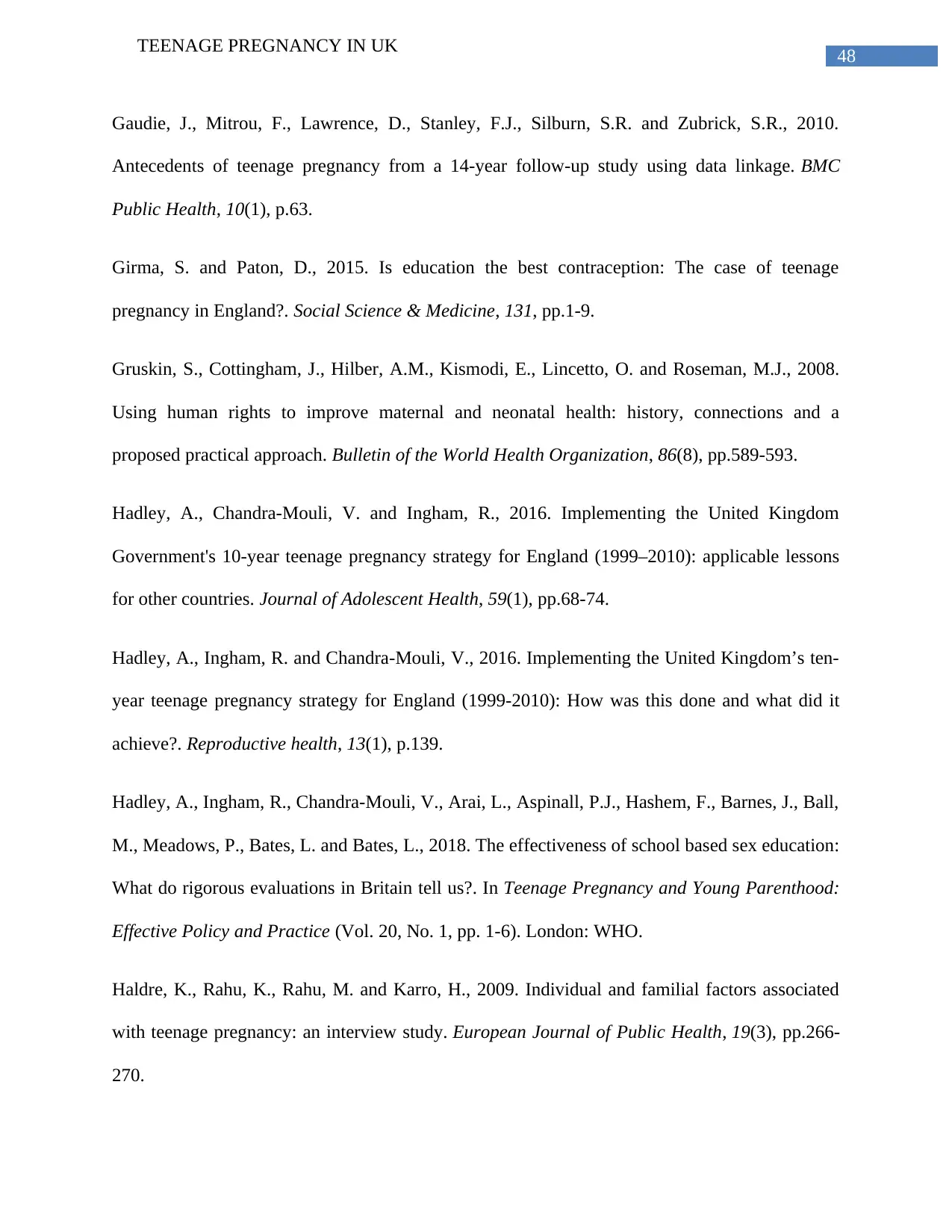
TEENAGE PREGNANCY IN UK
Gaudie, J., Mitrou, F., Lawrence, D., Stanley, F.J., Silburn, S.R. and Zubrick, S.R., 2010.
Antecedents of teenage pregnancy from a 14-year follow-up study using data linkage. BMC
Public Health, 10(1), p.63.
Girma, S. and Paton, D., 2015. Is education the best contraception: The case of teenage
pregnancy in England?. Social Science & Medicine, 131, pp.1-9.
Gruskin, S., Cottingham, J., Hilber, A.M., Kismodi, E., Lincetto, O. and Roseman, M.J., 2008.
Using human rights to improve maternal and neonatal health: history, connections and a
proposed practical approach. Bulletin of the World Health Organization, 86(8), pp.589-593.
Hadley, A., Chandra-Mouli, V. and Ingham, R., 2016. Implementing the United Kingdom
Government's 10-year teenage pregnancy strategy for England (1999–2010): applicable lessons
for other countries. Journal of Adolescent Health, 59(1), pp.68-74.
Hadley, A., Ingham, R. and Chandra-Mouli, V., 2016. Implementing the United Kingdom’s ten-
year teenage pregnancy strategy for England (1999-2010): How was this done and what did it
achieve?. Reproductive health, 13(1), p.139.
Hadley, A., Ingham, R., Chandra-Mouli, V., Arai, L., Aspinall, P.J., Hashem, F., Barnes, J., Ball,
M., Meadows, P., Bates, L. and Bates, L., 2018. The effectiveness of school based sex education:
What do rigorous evaluations in Britain tell us?. In Teenage Pregnancy and Young Parenthood:
Effective Policy and Practice (Vol. 20, No. 1, pp. 1-6). London: WHO.
Haldre, K., Rahu, K., Rahu, M. and Karro, H., 2009. Individual and familial factors associated
with teenage pregnancy: an interview study. European Journal of Public Health, 19(3), pp.266-
270.
Paraphrase This Document
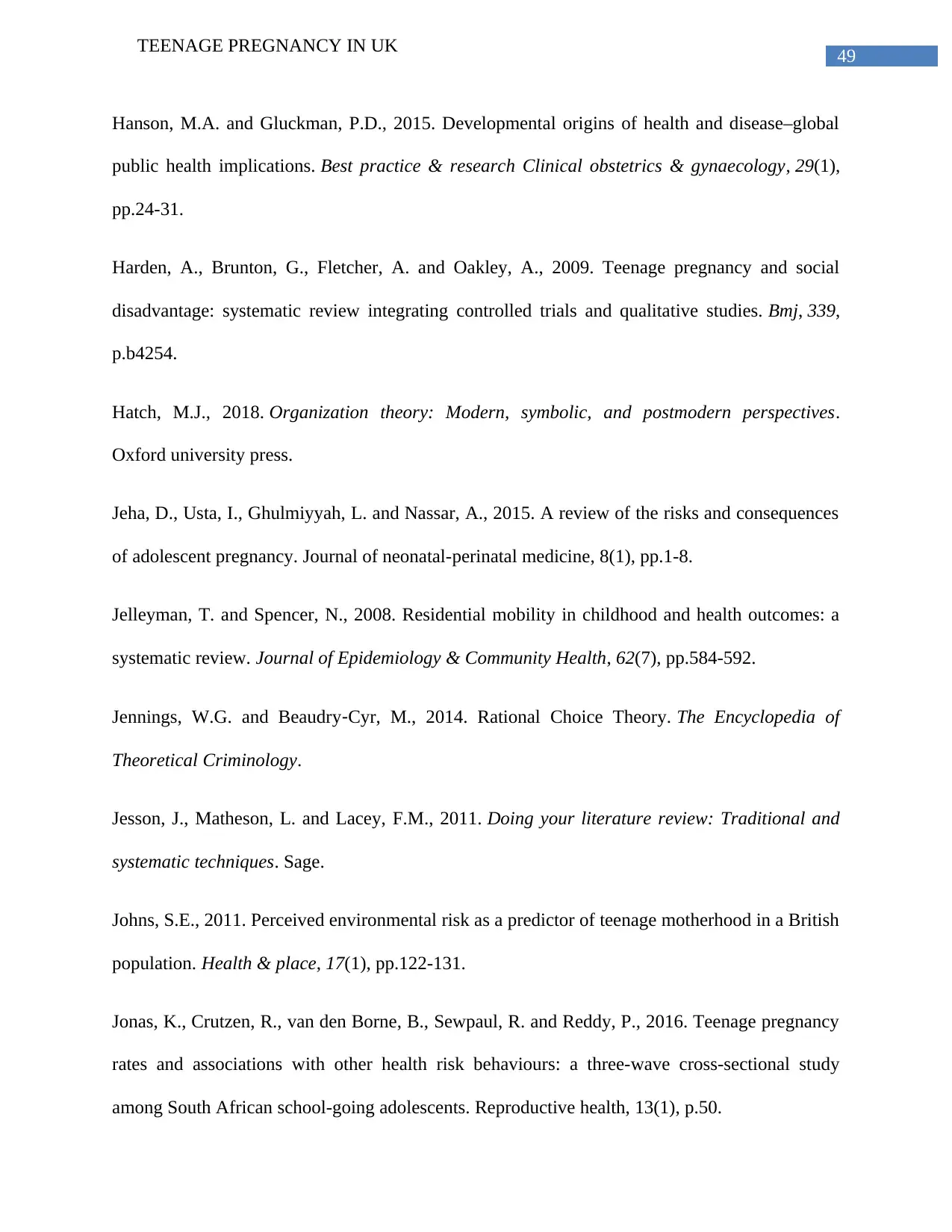
TEENAGE PREGNANCY IN UK
Hanson, M.A. and Gluckman, P.D., 2015. Developmental origins of health and disease–global
public health implications. Best practice & research Clinical obstetrics & gynaecology, 29(1),
pp.24-31.
Harden, A., Brunton, G., Fletcher, A. and Oakley, A., 2009. Teenage pregnancy and social
disadvantage: systematic review integrating controlled trials and qualitative studies. Bmj, 339,
p.b4254.
Hatch, M.J., 2018. Organization theory: Modern, symbolic, and postmodern perspectives.
Oxford university press.
Jeha, D., Usta, I., Ghulmiyyah, L. and Nassar, A., 2015. A review of the risks and consequences
of adolescent pregnancy. Journal of neonatal-perinatal medicine, 8(1), pp.1-8.
Jelleyman, T. and Spencer, N., 2008. Residential mobility in childhood and health outcomes: a
systematic review. Journal of Epidemiology & Community Health, 62(7), pp.584-592.
Jennings, W.G. and Beaudry‐Cyr, M., 2014. Rational Choice Theory. The Encyclopedia of
Theoretical Criminology.
Jesson, J., Matheson, L. and Lacey, F.M., 2011. Doing your literature review: Traditional and
systematic techniques. Sage.
Johns, S.E., 2011. Perceived environmental risk as a predictor of teenage motherhood in a British
population. Health & place, 17(1), pp.122-131.
Jonas, K., Crutzen, R., van den Borne, B., Sewpaul, R. and Reddy, P., 2016. Teenage pregnancy
rates and associations with other health risk behaviours: a three-wave cross-sectional study
among South African school-going adolescents. Reproductive health, 13(1), p.50.
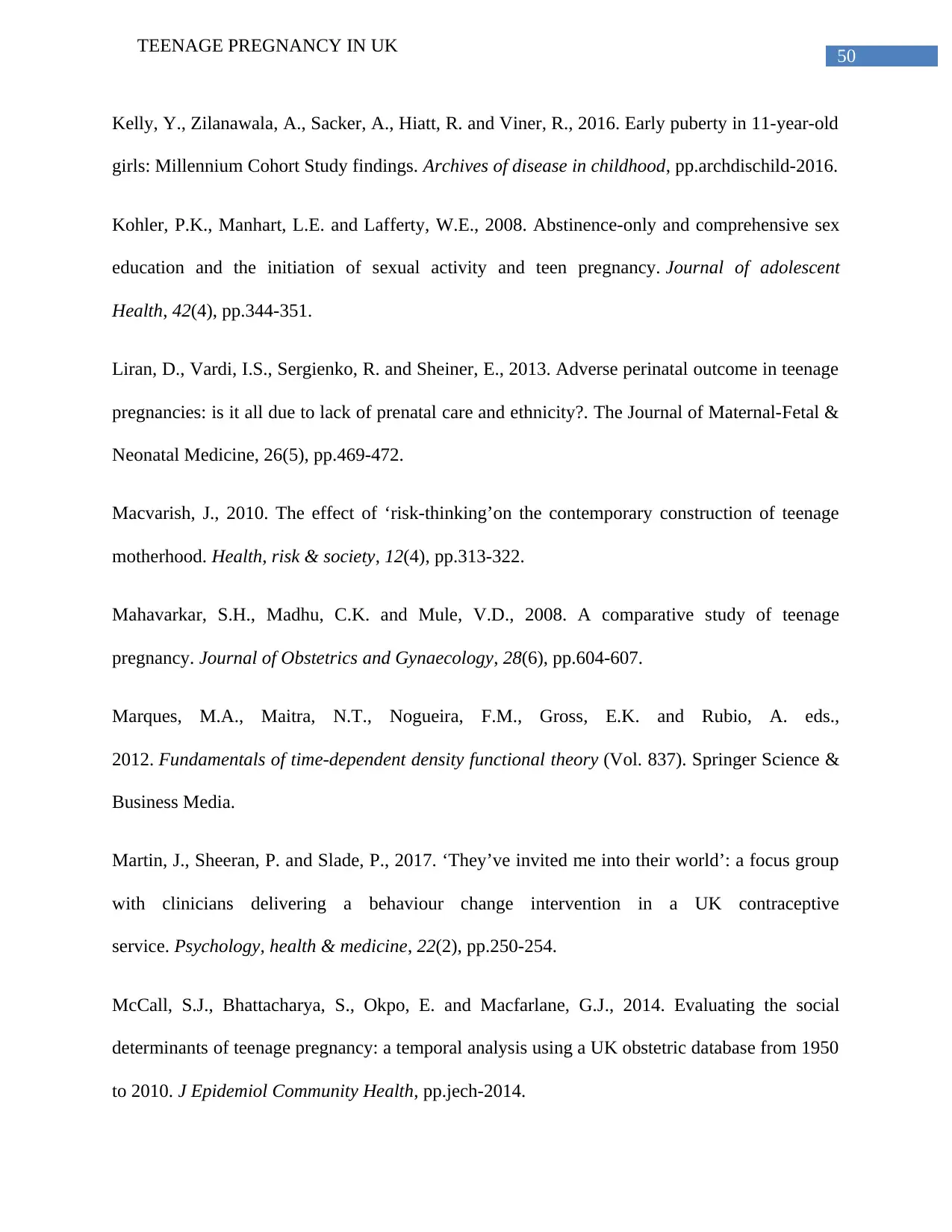
TEENAGE PREGNANCY IN UK
Kelly, Y., Zilanawala, A., Sacker, A., Hiatt, R. and Viner, R., 2016. Early puberty in 11-year-old
girls: Millennium Cohort Study findings. Archives of disease in childhood, pp.archdischild-2016.
Kohler, P.K., Manhart, L.E. and Lafferty, W.E., 2008. Abstinence-only and comprehensive sex
education and the initiation of sexual activity and teen pregnancy. Journal of adolescent
Health, 42(4), pp.344-351.
Liran, D., Vardi, I.S., Sergienko, R. and Sheiner, E., 2013. Adverse perinatal outcome in teenage
pregnancies: is it all due to lack of prenatal care and ethnicity?. The Journal of Maternal-Fetal &
Neonatal Medicine, 26(5), pp.469-472.
Macvarish, J., 2010. The effect of ‘risk-thinking’on the contemporary construction of teenage
motherhood. Health, risk & society, 12(4), pp.313-322.
Mahavarkar, S.H., Madhu, C.K. and Mule, V.D., 2008. A comparative study of teenage
pregnancy. Journal of Obstetrics and Gynaecology, 28(6), pp.604-607.
Marques, M.A., Maitra, N.T., Nogueira, F.M., Gross, E.K. and Rubio, A. eds.,
2012. Fundamentals of time-dependent density functional theory (Vol. 837). Springer Science &
Business Media.
Martin, J., Sheeran, P. and Slade, P., 2017. ‘They’ve invited me into their world’: a focus group
with clinicians delivering a behaviour change intervention in a UK contraceptive
service. Psychology, health & medicine, 22(2), pp.250-254.
McCall, S.J., Bhattacharya, S., Okpo, E. and Macfarlane, G.J., 2014. Evaluating the social
determinants of teenage pregnancy: a temporal analysis using a UK obstetric database from 1950
to 2010. J Epidemiol Community Health, pp.jech-2014.
⊘ This is a preview!⊘
Do you want full access?
Subscribe today to unlock all pages.

Trusted by 1+ million students worldwide
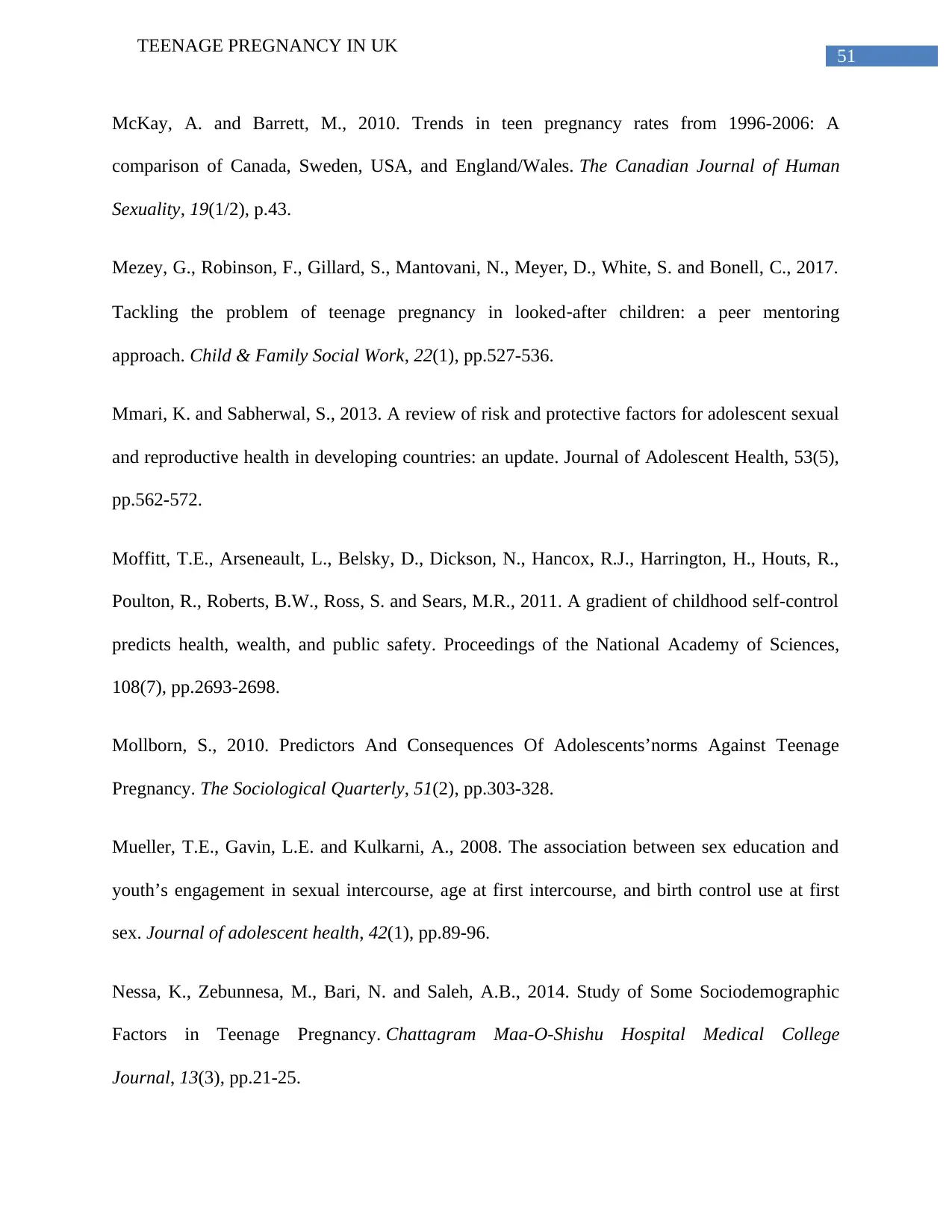
TEENAGE PREGNANCY IN UK
McKay, A. and Barrett, M., 2010. Trends in teen pregnancy rates from 1996-2006: A
comparison of Canada, Sweden, USA, and England/Wales. The Canadian Journal of Human
Sexuality, 19(1/2), p.43.
Mezey, G., Robinson, F., Gillard, S., Mantovani, N., Meyer, D., White, S. and Bonell, C., 2017.
Tackling the problem of teenage pregnancy in looked‐after children: a peer mentoring
approach. Child & Family Social Work, 22(1), pp.527-536.
Mmari, K. and Sabherwal, S., 2013. A review of risk and protective factors for adolescent sexual
and reproductive health in developing countries: an update. Journal of Adolescent Health, 53(5),
pp.562-572.
Moffitt, T.E., Arseneault, L., Belsky, D., Dickson, N., Hancox, R.J., Harrington, H., Houts, R.,
Poulton, R., Roberts, B.W., Ross, S. and Sears, M.R., 2011. A gradient of childhood self-control
predicts health, wealth, and public safety. Proceedings of the National Academy of Sciences,
108(7), pp.2693-2698.
Mollborn, S., 2010. Predictors And Consequences Of Adolescents’norms Against Teenage
Pregnancy. The Sociological Quarterly, 51(2), pp.303-328.
Mueller, T.E., Gavin, L.E. and Kulkarni, A., 2008. The association between sex education and
youth’s engagement in sexual intercourse, age at first intercourse, and birth control use at first
sex. Journal of adolescent health, 42(1), pp.89-96.
Nessa, K., Zebunnesa, M., Bari, N. and Saleh, A.B., 2014. Study of Some Sociodemographic
Factors in Teenage Pregnancy. Chattagram Maa-O-Shishu Hospital Medical College
Journal, 13(3), pp.21-25.
Paraphrase This Document
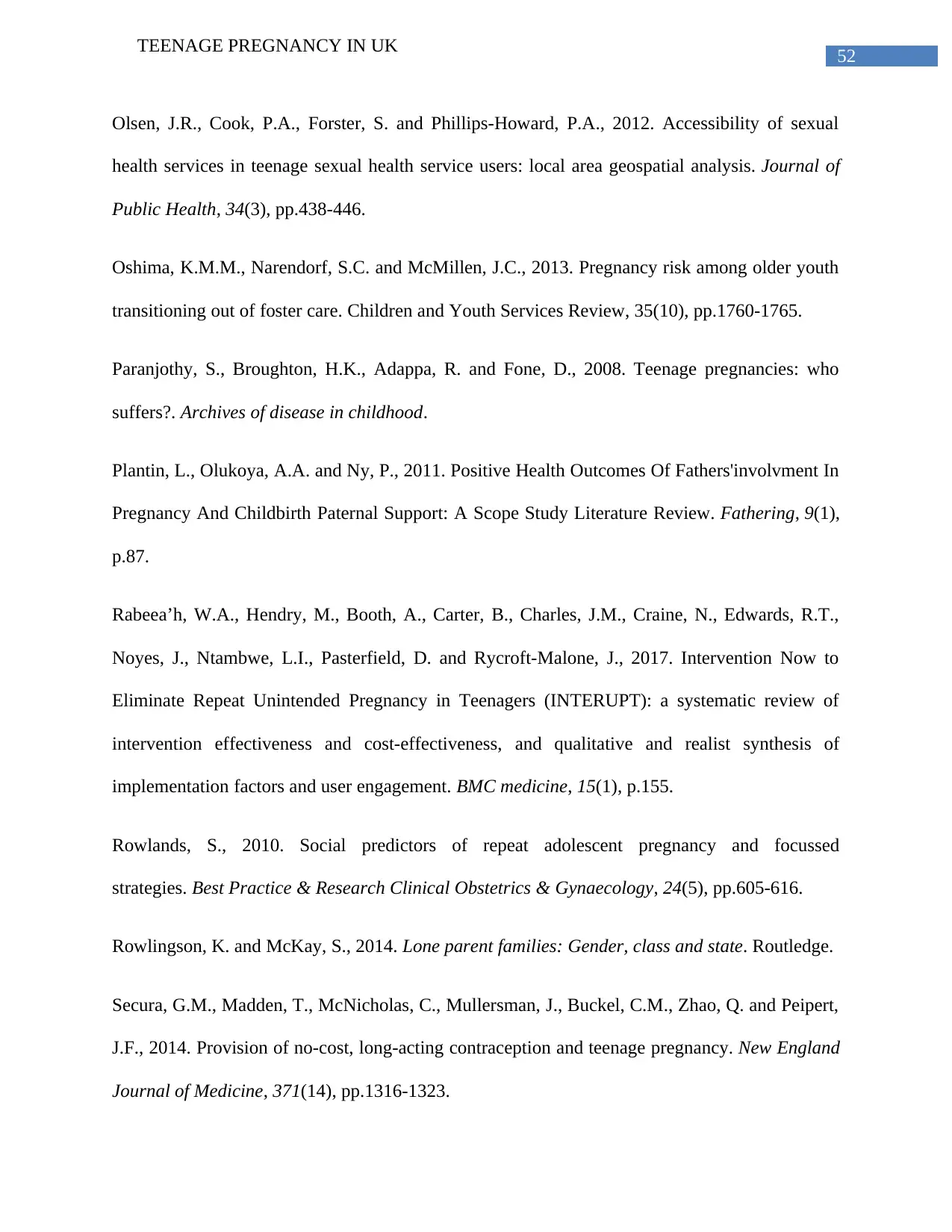
TEENAGE PREGNANCY IN UK
Olsen, J.R., Cook, P.A., Forster, S. and Phillips-Howard, P.A., 2012. Accessibility of sexual
health services in teenage sexual health service users: local area geospatial analysis. Journal of
Public Health, 34(3), pp.438-446.
Oshima, K.M.M., Narendorf, S.C. and McMillen, J.C., 2013. Pregnancy risk among older youth
transitioning out of foster care. Children and Youth Services Review, 35(10), pp.1760-1765.
Paranjothy, S., Broughton, H.K., Adappa, R. and Fone, D., 2008. Teenage pregnancies: who
suffers?. Archives of disease in childhood.
Plantin, L., Olukoya, A.A. and Ny, P., 2011. Positive Health Outcomes Of Fathers'involvment In
Pregnancy And Childbirth Paternal Support: A Scope Study Literature Review. Fathering, 9(1),
p.87.
Rabeea’h, W.A., Hendry, M., Booth, A., Carter, B., Charles, J.M., Craine, N., Edwards, R.T.,
Noyes, J., Ntambwe, L.I., Pasterfield, D. and Rycroft-Malone, J., 2017. Intervention Now to
Eliminate Repeat Unintended Pregnancy in Teenagers (INTERUPT): a systematic review of
intervention effectiveness and cost-effectiveness, and qualitative and realist synthesis of
implementation factors and user engagement. BMC medicine, 15(1), p.155.
Rowlands, S., 2010. Social predictors of repeat adolescent pregnancy and focussed
strategies. Best Practice & Research Clinical Obstetrics & Gynaecology, 24(5), pp.605-616.
Rowlingson, K. and McKay, S., 2014. Lone parent families: Gender, class and state. Routledge.
Secura, G.M., Madden, T., McNicholas, C., Mullersman, J., Buckel, C.M., Zhao, Q. and Peipert,
J.F., 2014. Provision of no-cost, long-acting contraception and teenage pregnancy. New England
Journal of Medicine, 371(14), pp.1316-1323.
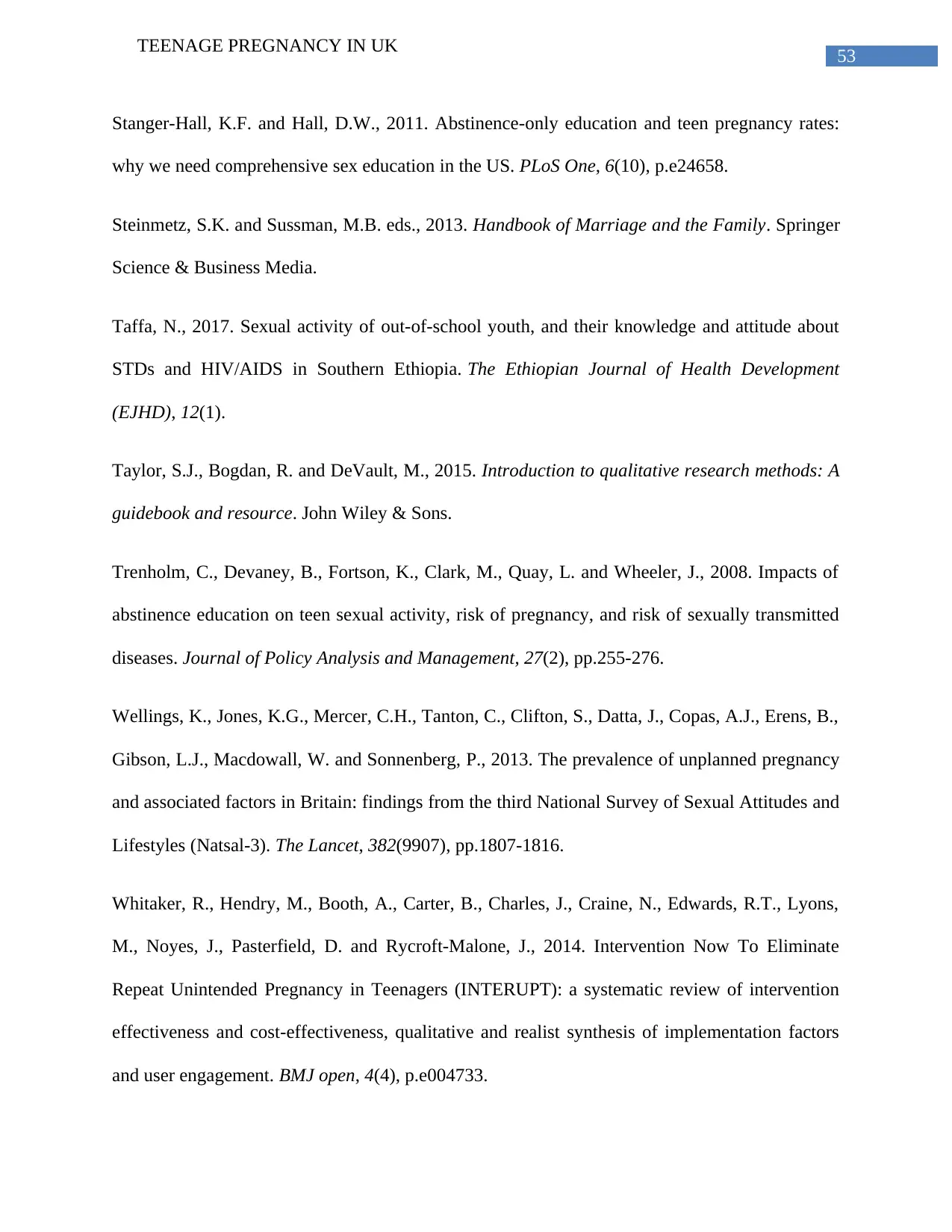
TEENAGE PREGNANCY IN UK
Stanger-Hall, K.F. and Hall, D.W., 2011. Abstinence-only education and teen pregnancy rates:
why we need comprehensive sex education in the US. PLoS One, 6(10), p.e24658.
Steinmetz, S.K. and Sussman, M.B. eds., 2013. Handbook of Marriage and the Family. Springer
Science & Business Media.
Taffa, N., 2017. Sexual activity of out-of-school youth, and their knowledge and attitude about
STDs and HIV/AIDS in Southern Ethiopia. The Ethiopian Journal of Health Development
(EJHD), 12(1).
Taylor, S.J., Bogdan, R. and DeVault, M., 2015. Introduction to qualitative research methods: A
guidebook and resource. John Wiley & Sons.
Trenholm, C., Devaney, B., Fortson, K., Clark, M., Quay, L. and Wheeler, J., 2008. Impacts of
abstinence education on teen sexual activity, risk of pregnancy, and risk of sexually transmitted
diseases. Journal of Policy Analysis and Management, 27(2), pp.255-276.
Wellings, K., Jones, K.G., Mercer, C.H., Tanton, C., Clifton, S., Datta, J., Copas, A.J., Erens, B.,
Gibson, L.J., Macdowall, W. and Sonnenberg, P., 2013. The prevalence of unplanned pregnancy
and associated factors in Britain: findings from the third National Survey of Sexual Attitudes and
Lifestyles (Natsal-3). The Lancet, 382(9907), pp.1807-1816.
Whitaker, R., Hendry, M., Booth, A., Carter, B., Charles, J., Craine, N., Edwards, R.T., Lyons,
M., Noyes, J., Pasterfield, D. and Rycroft-Malone, J., 2014. Intervention Now To Eliminate
Repeat Unintended Pregnancy in Teenagers (INTERUPT): a systematic review of intervention
effectiveness and cost-effectiveness, qualitative and realist synthesis of implementation factors
and user engagement. BMJ open, 4(4), p.e004733.
⊘ This is a preview!⊘
Do you want full access?
Subscribe today to unlock all pages.

Trusted by 1+ million students worldwide
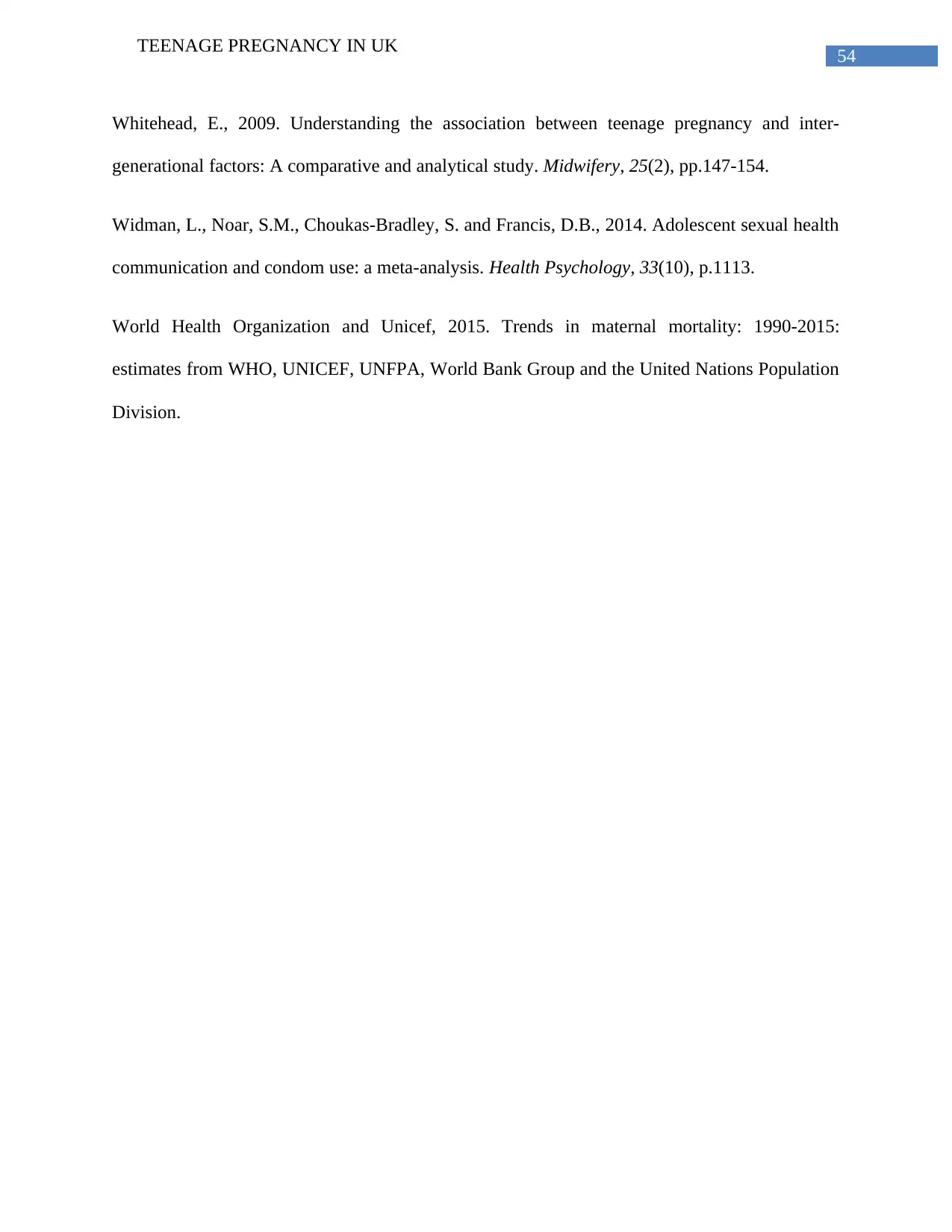
TEENAGE PREGNANCY IN UK
Whitehead, E., 2009. Understanding the association between teenage pregnancy and inter-
generational factors: A comparative and analytical study. Midwifery, 25(2), pp.147-154.
Widman, L., Noar, S.M., Choukas-Bradley, S. and Francis, D.B., 2014. Adolescent sexual health
communication and condom use: a meta-analysis. Health Psychology, 33(10), p.1113.
World Health Organization and Unicef, 2015. Trends in maternal mortality: 1990-2015:
estimates from WHO, UNICEF, UNFPA, World Bank Group and the United Nations Population
Division.
Related Documents
Your All-in-One AI-Powered Toolkit for Academic Success.
+13062052269
info@desklib.com
Available 24*7 on WhatsApp / Email
![[object Object]](/_next/static/media/star-bottom.7253800d.svg)
© 2024 | Zucol Services PVT LTD | All rights reserved.





